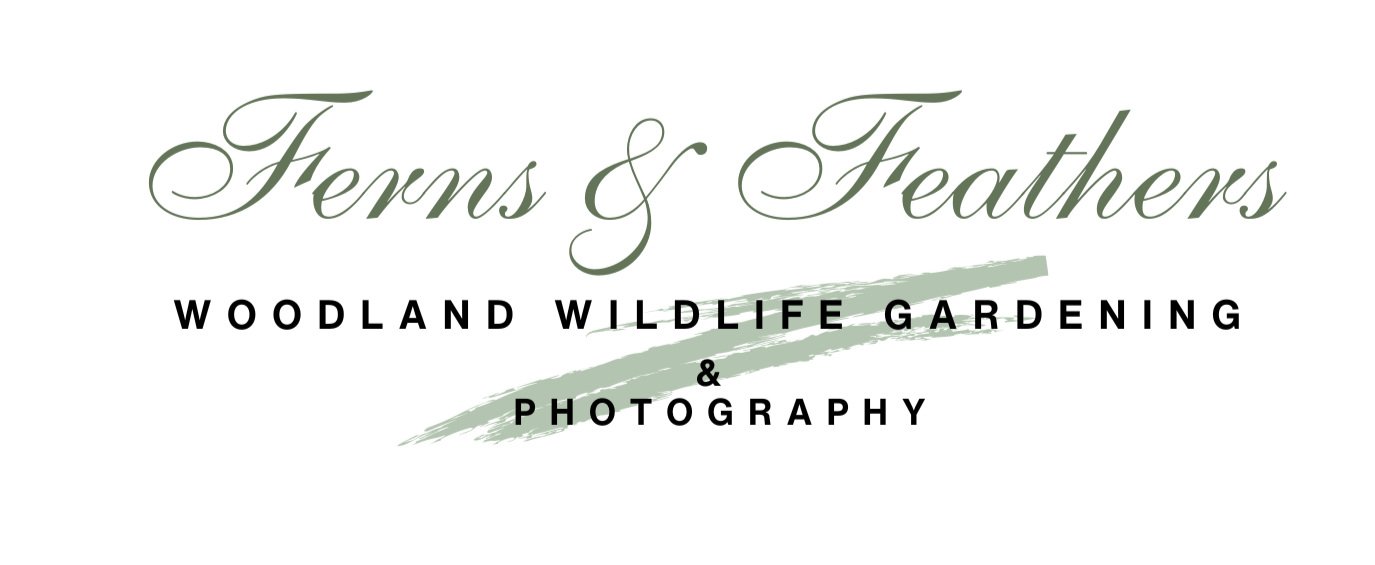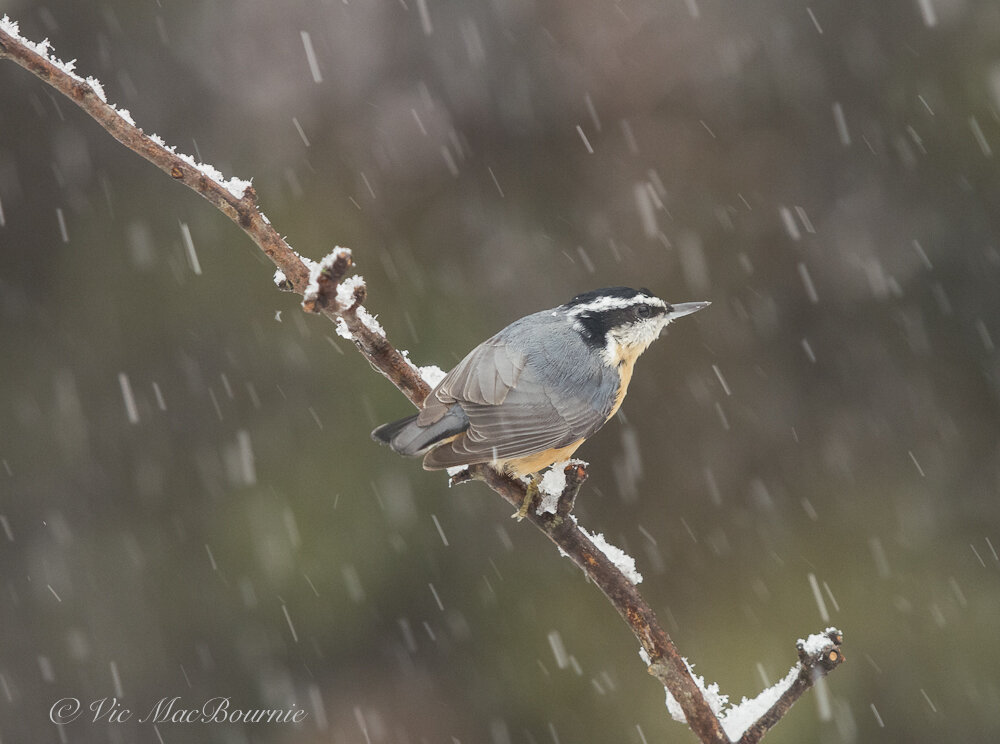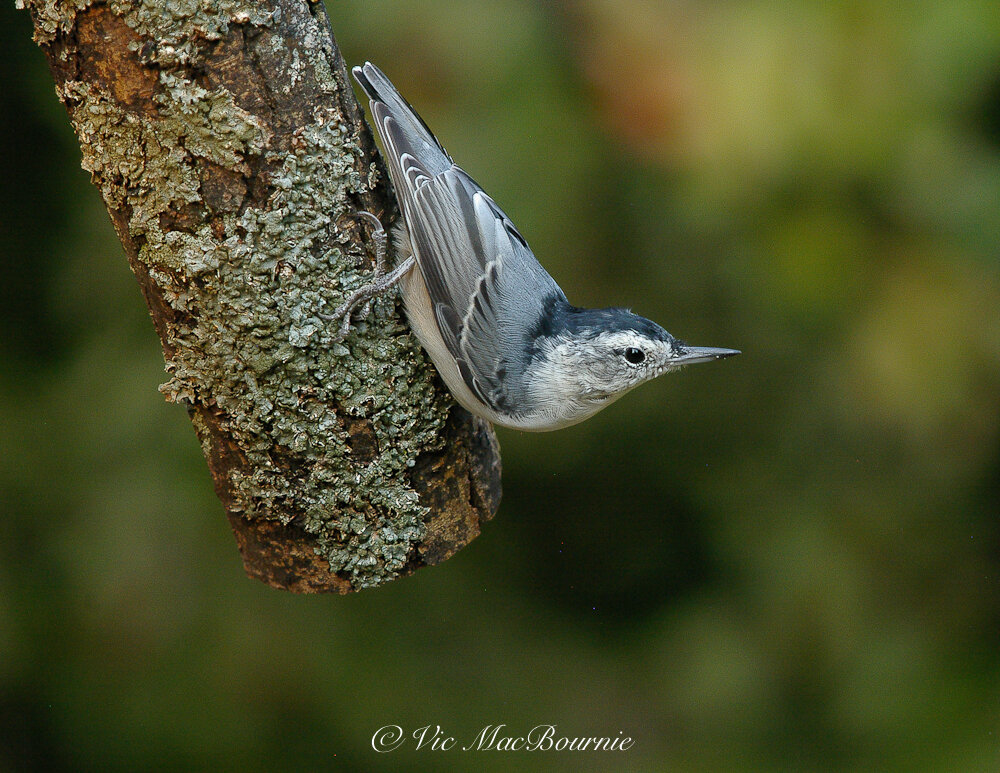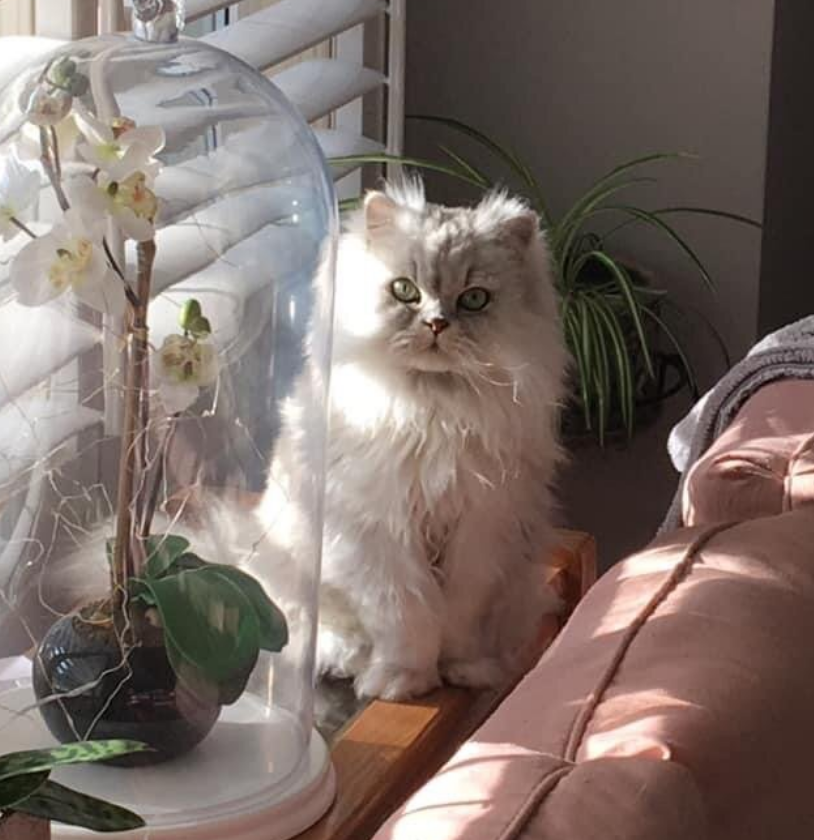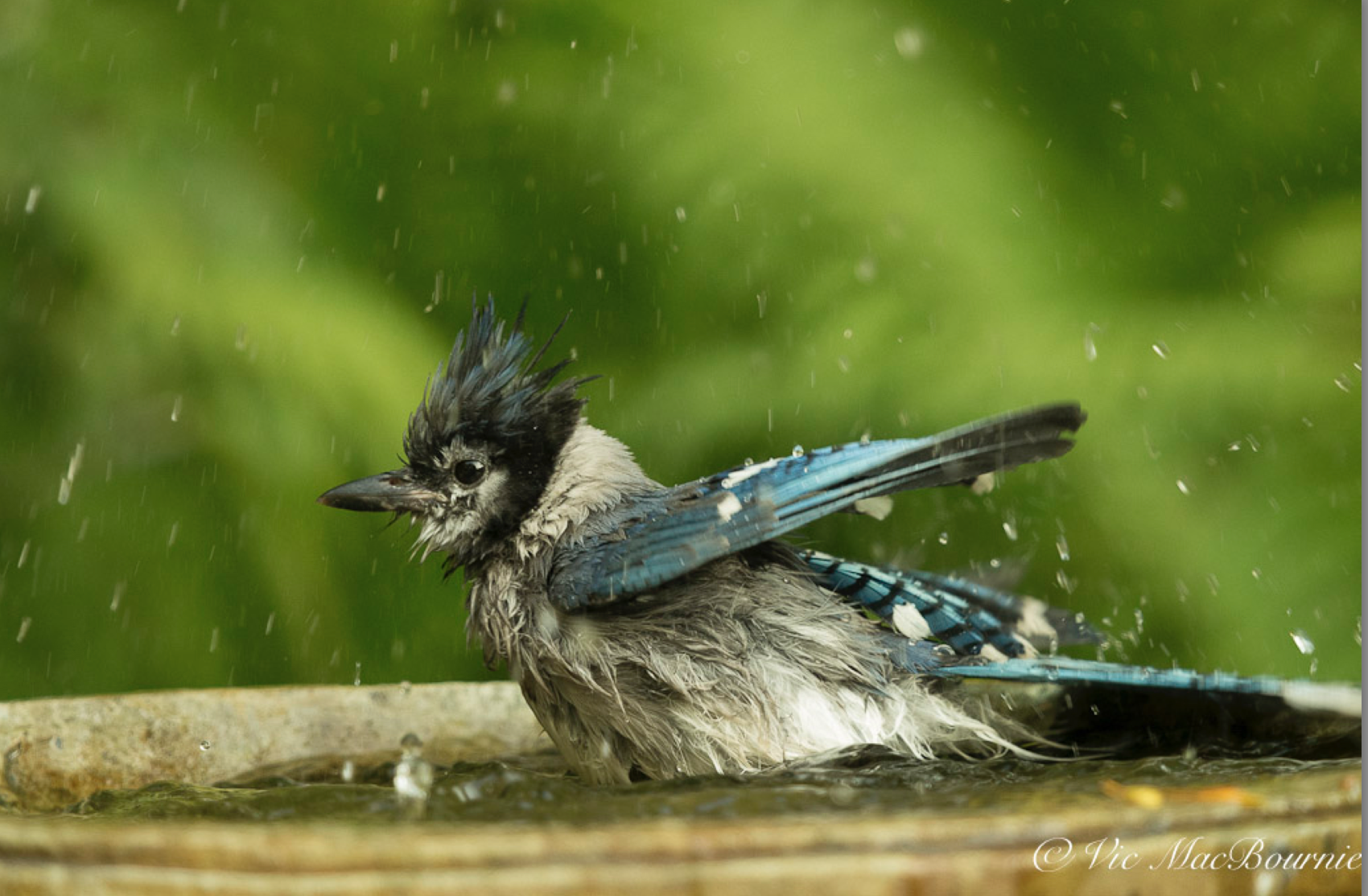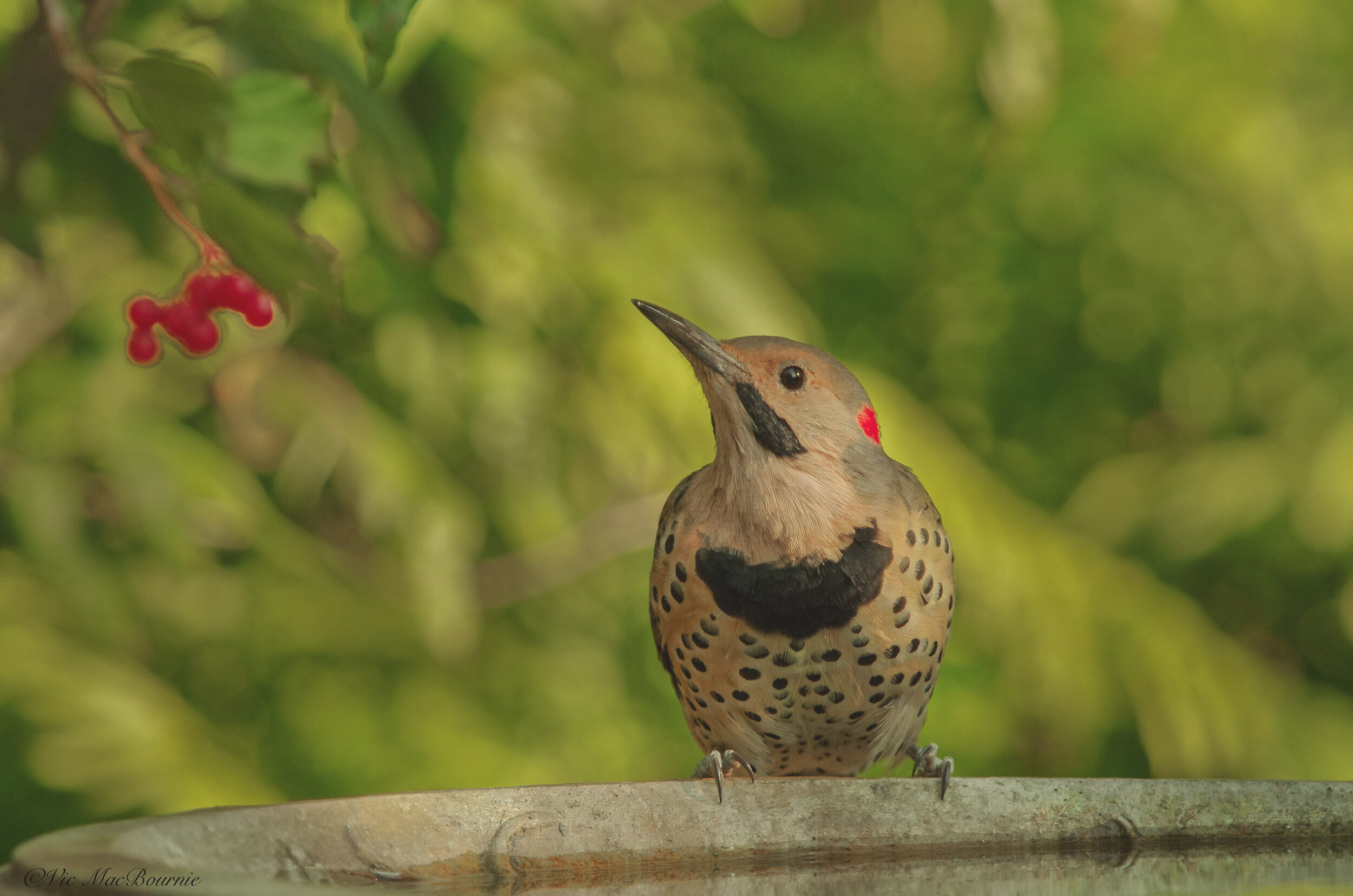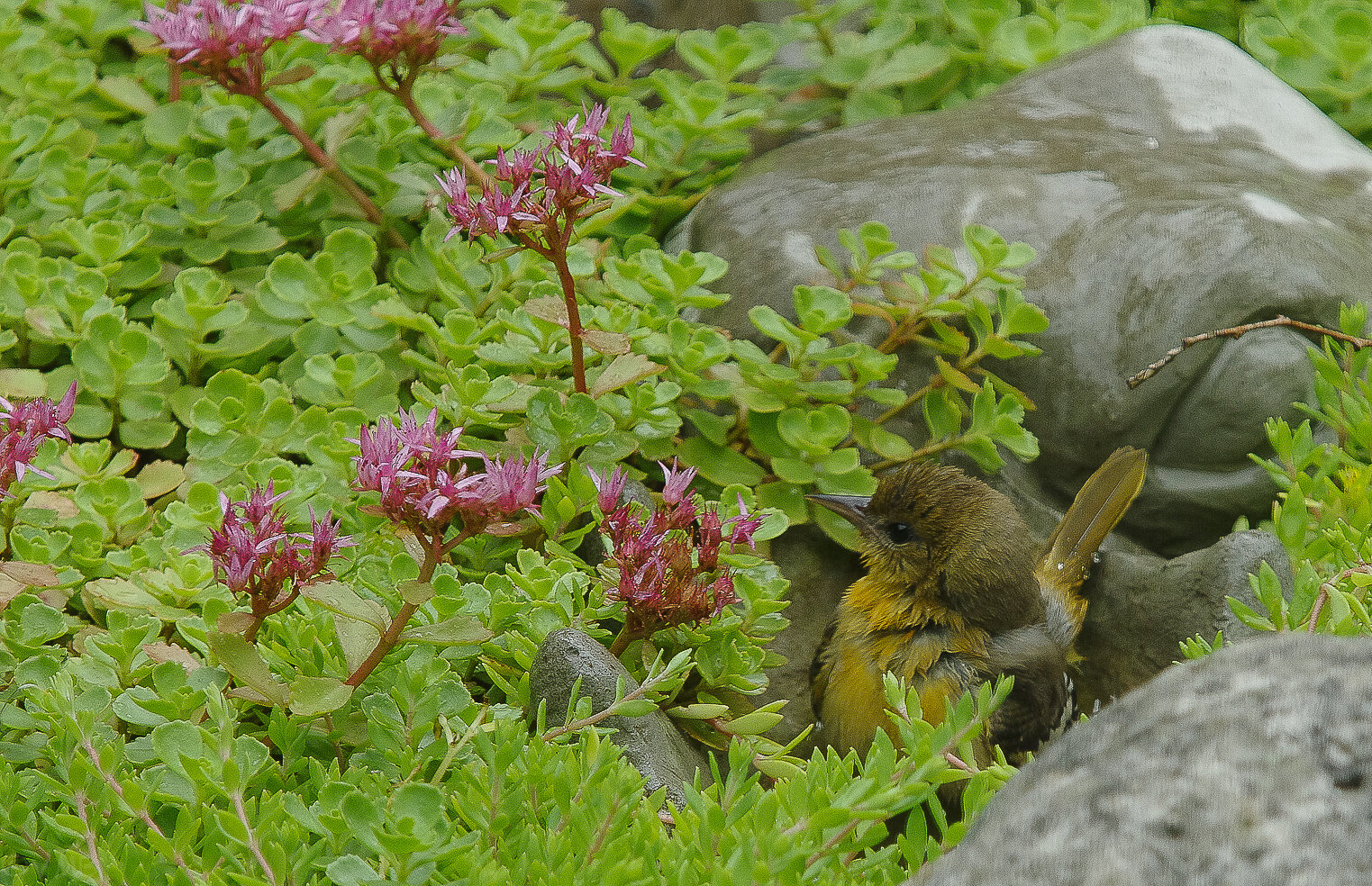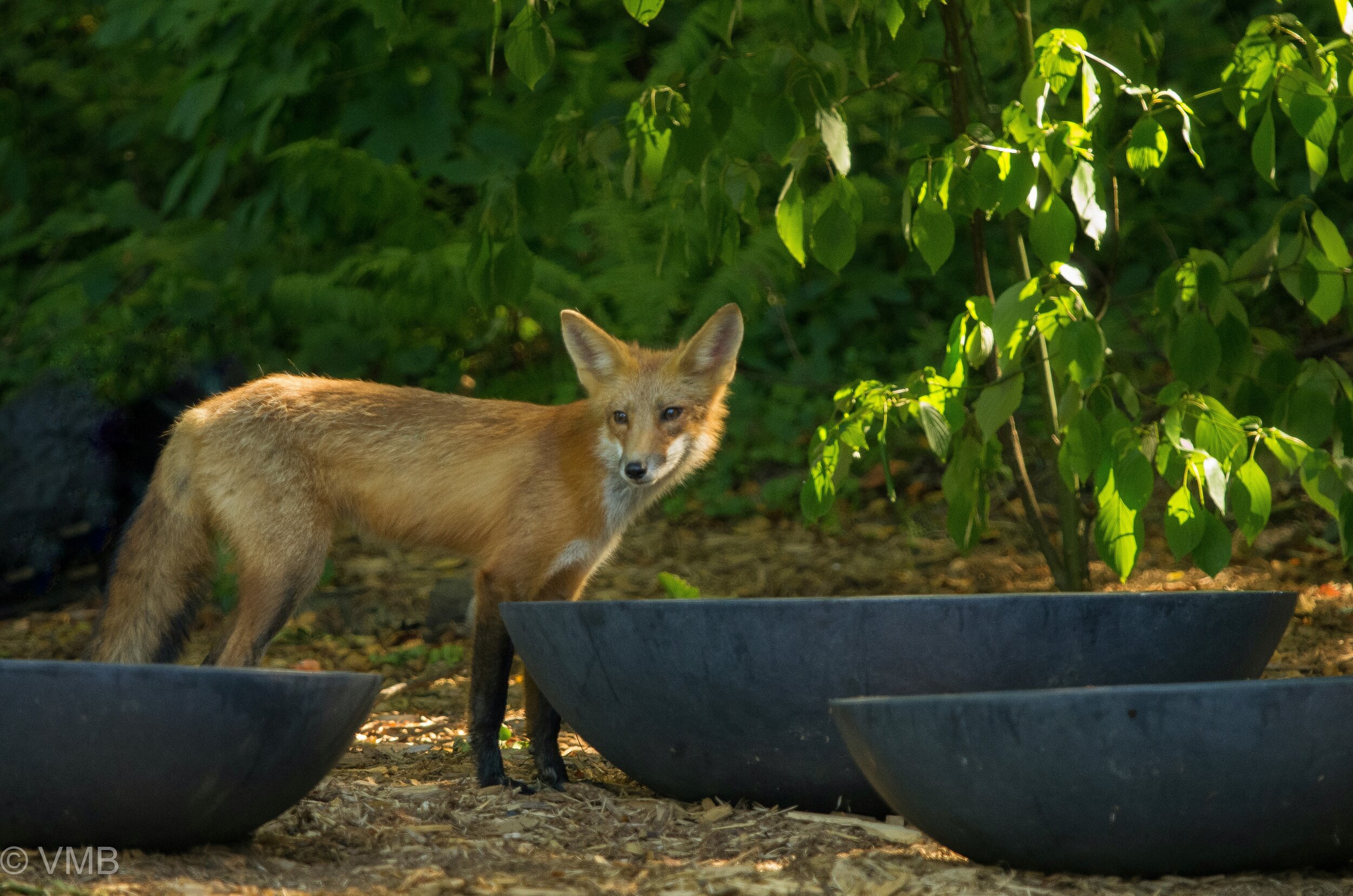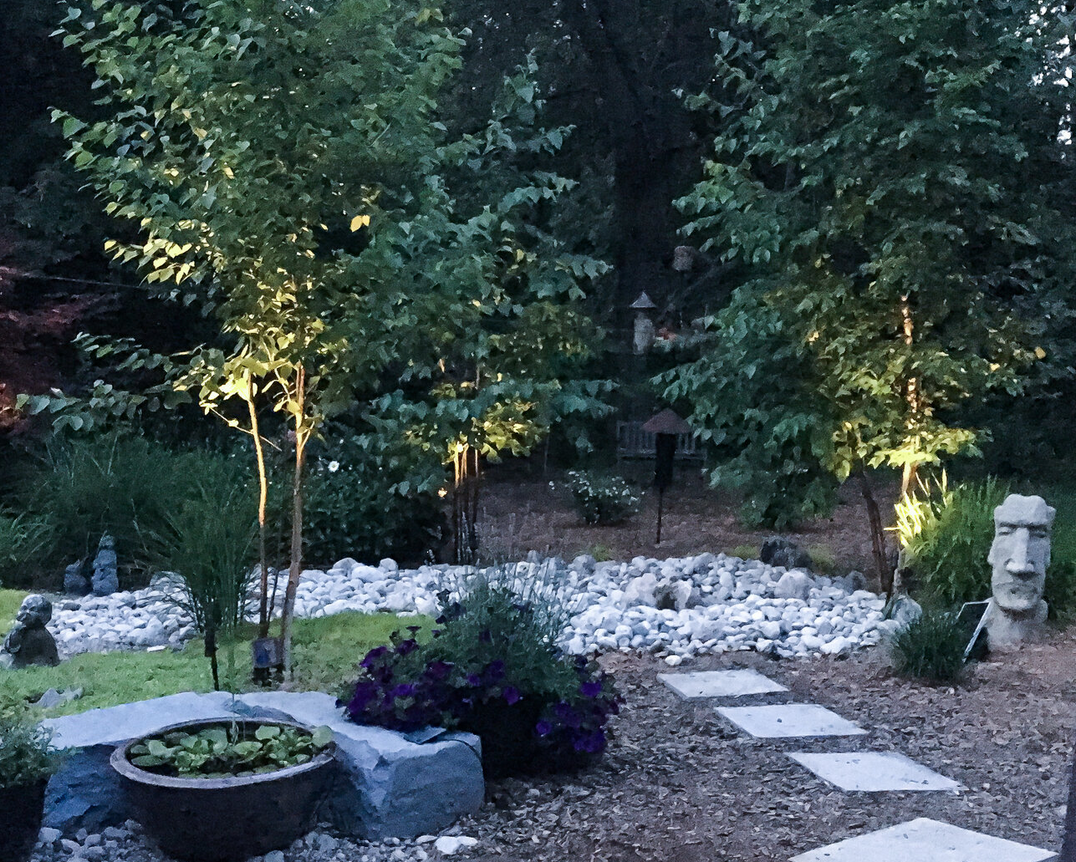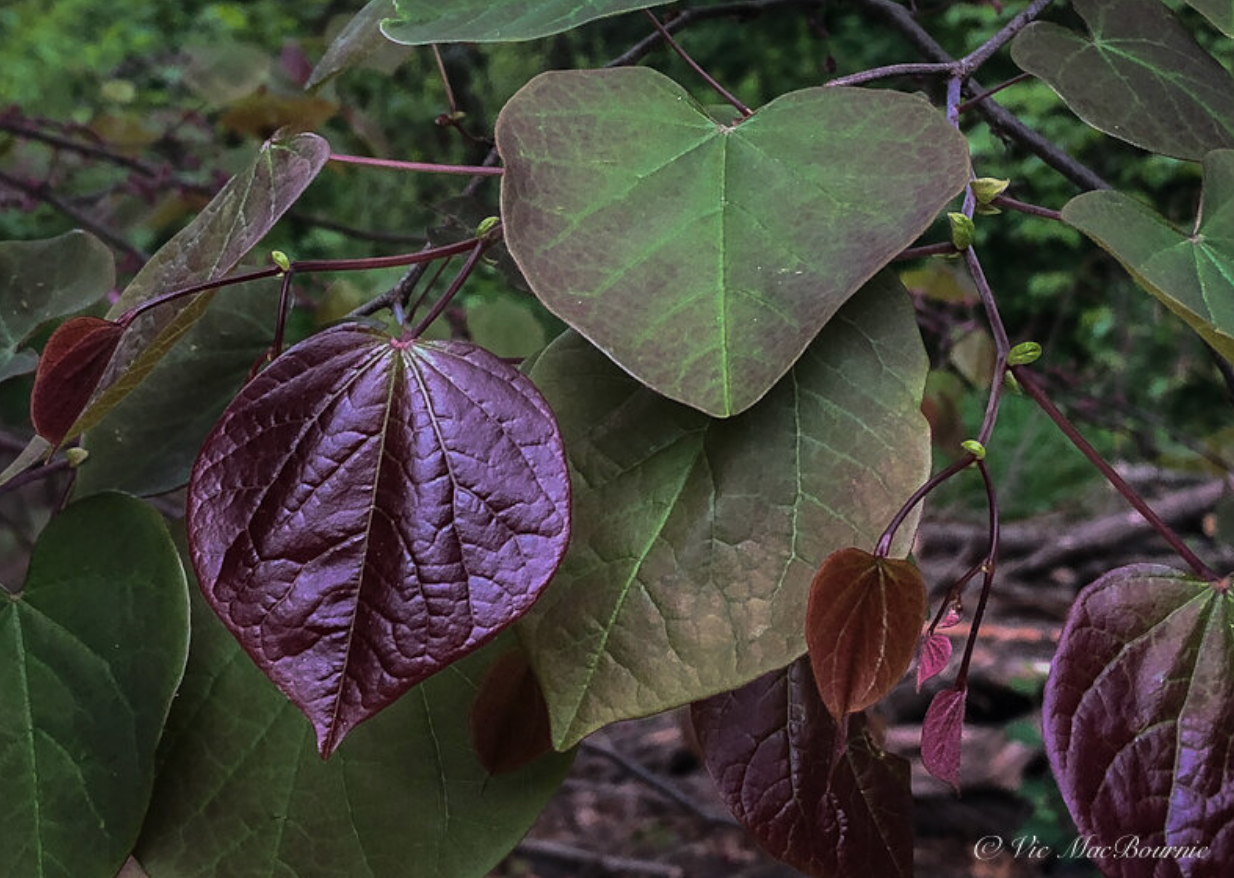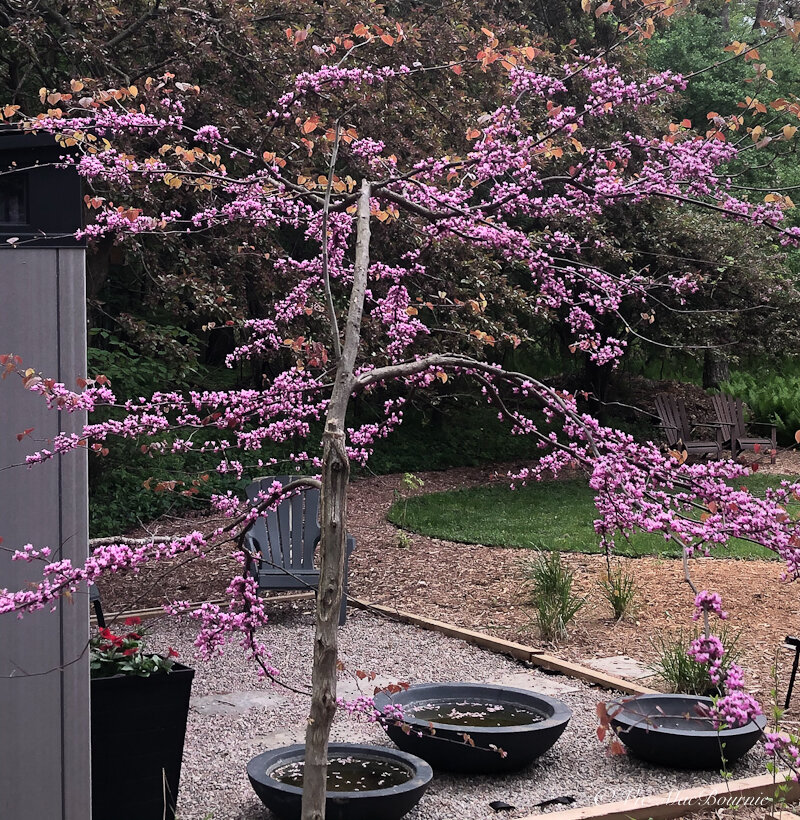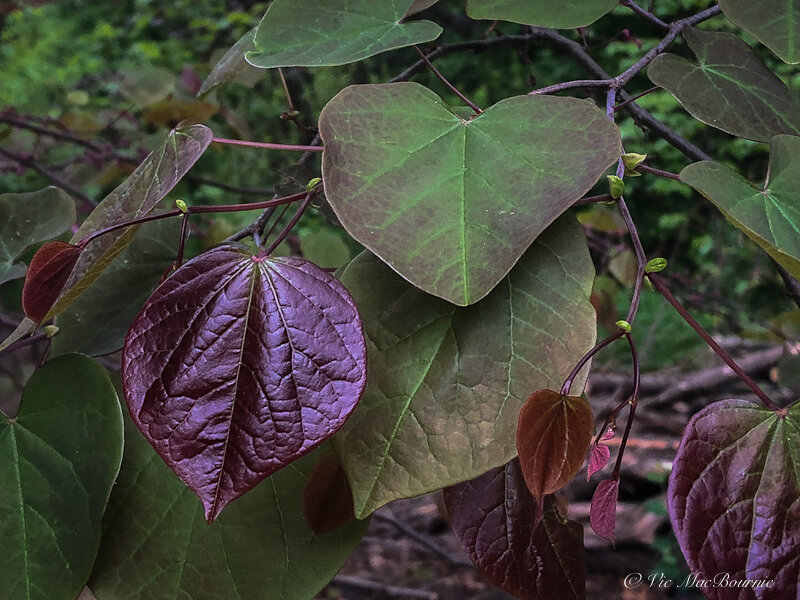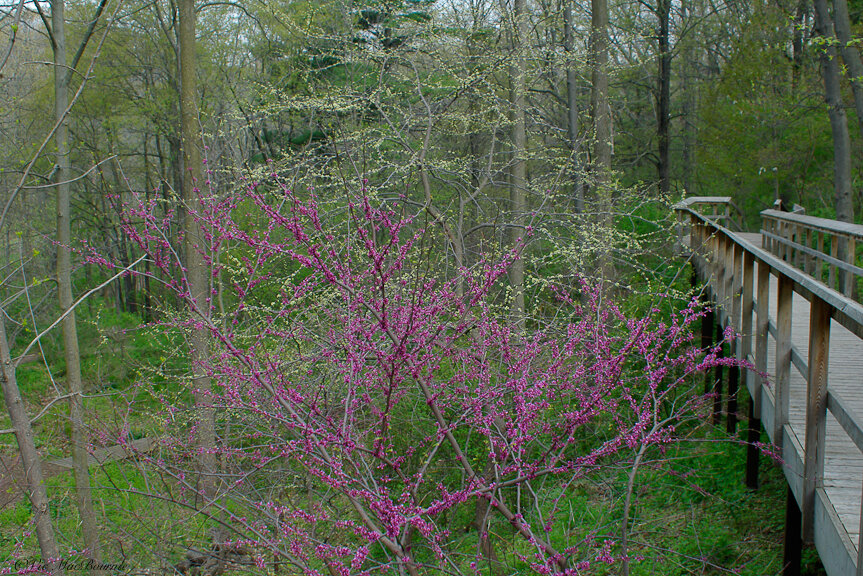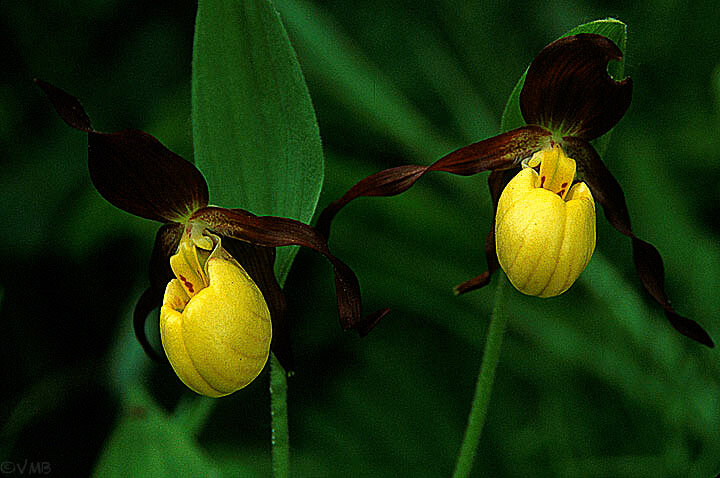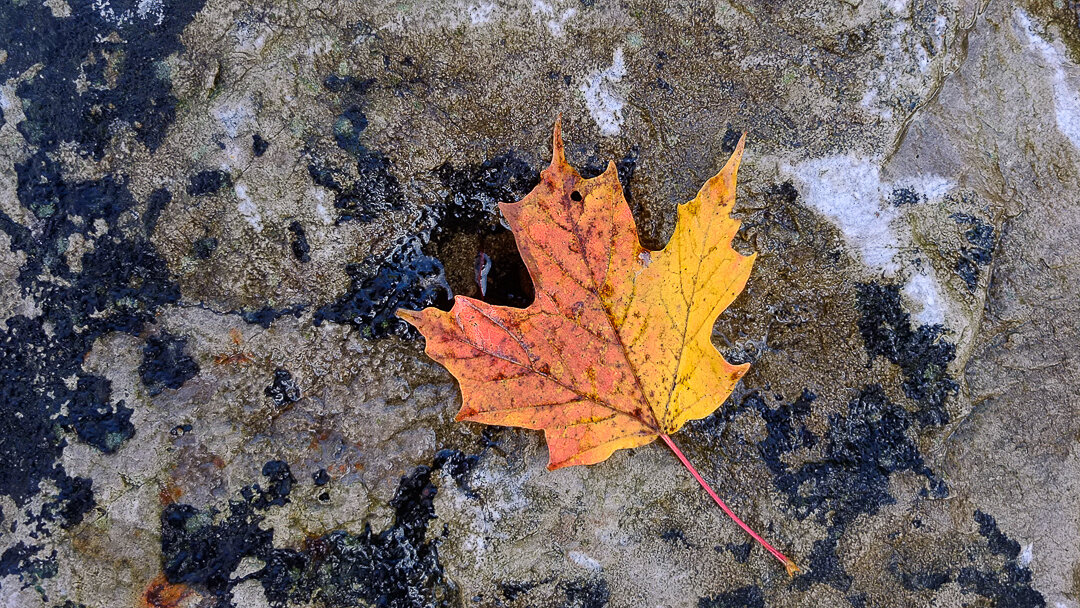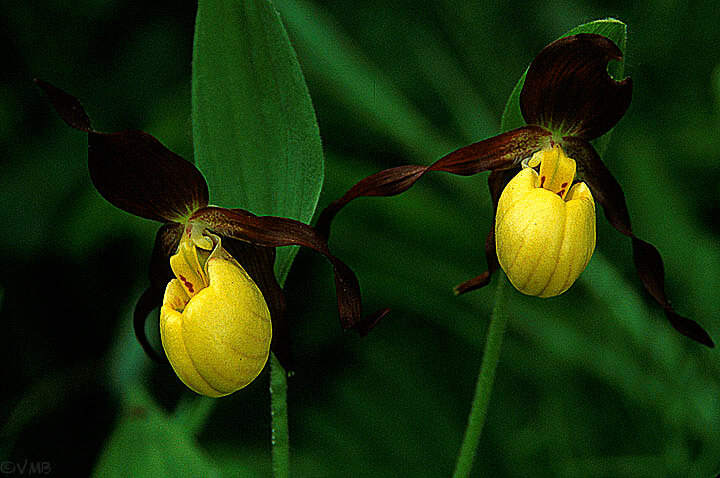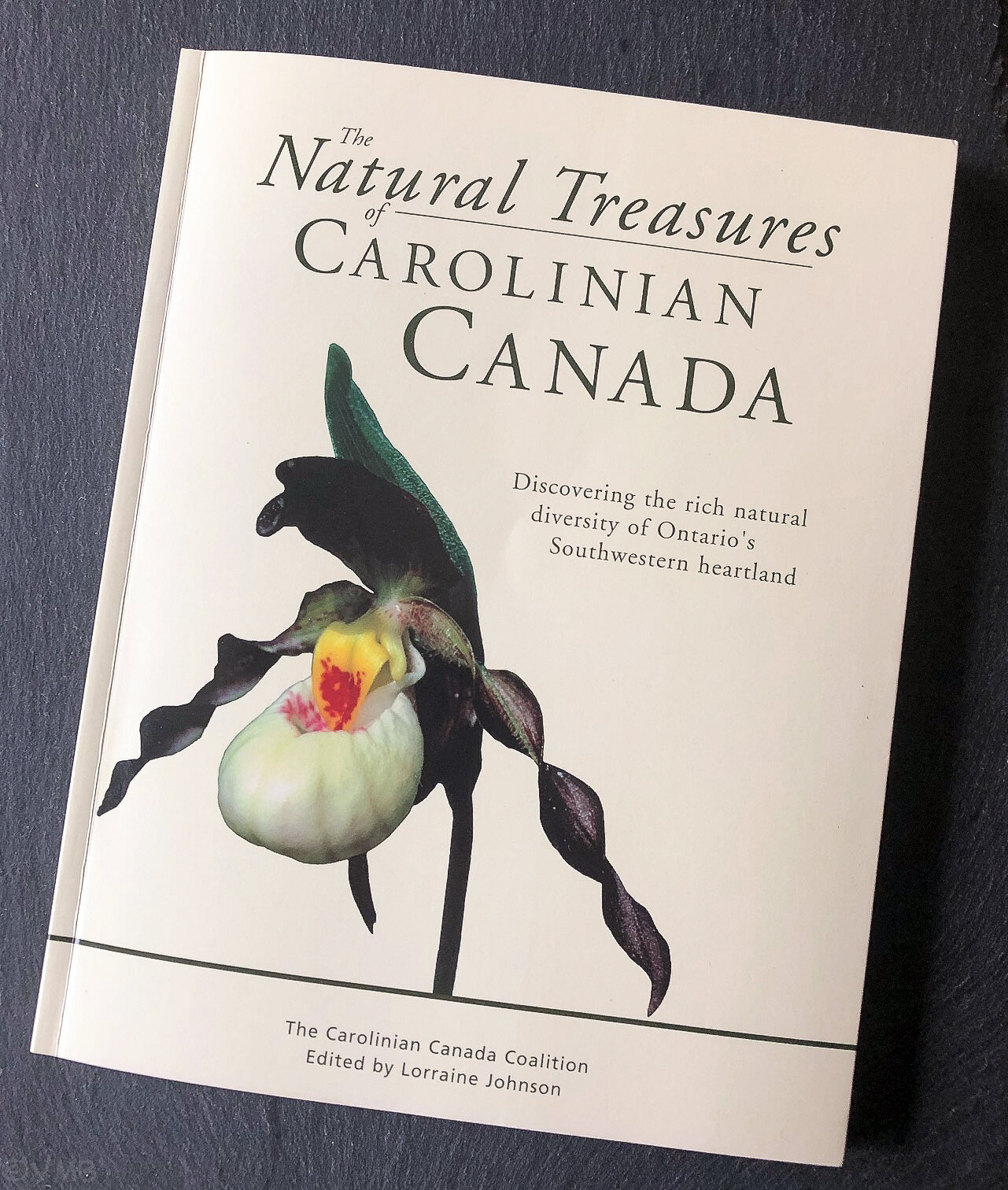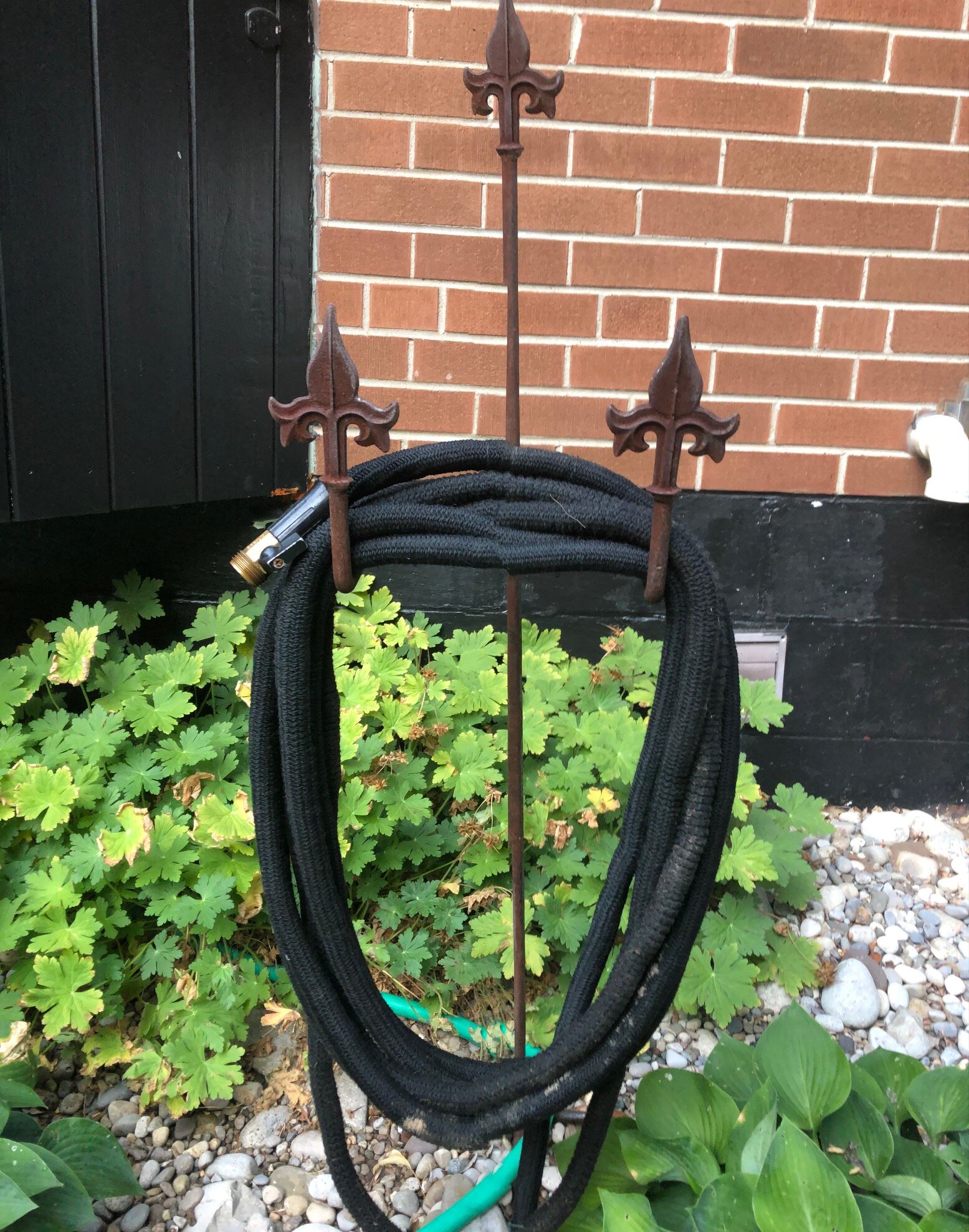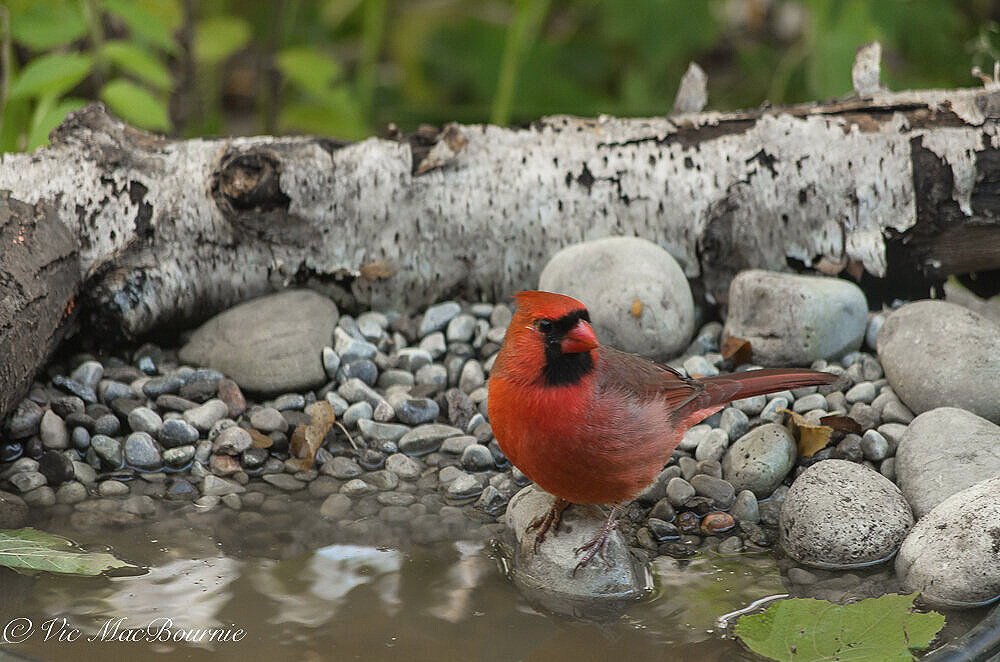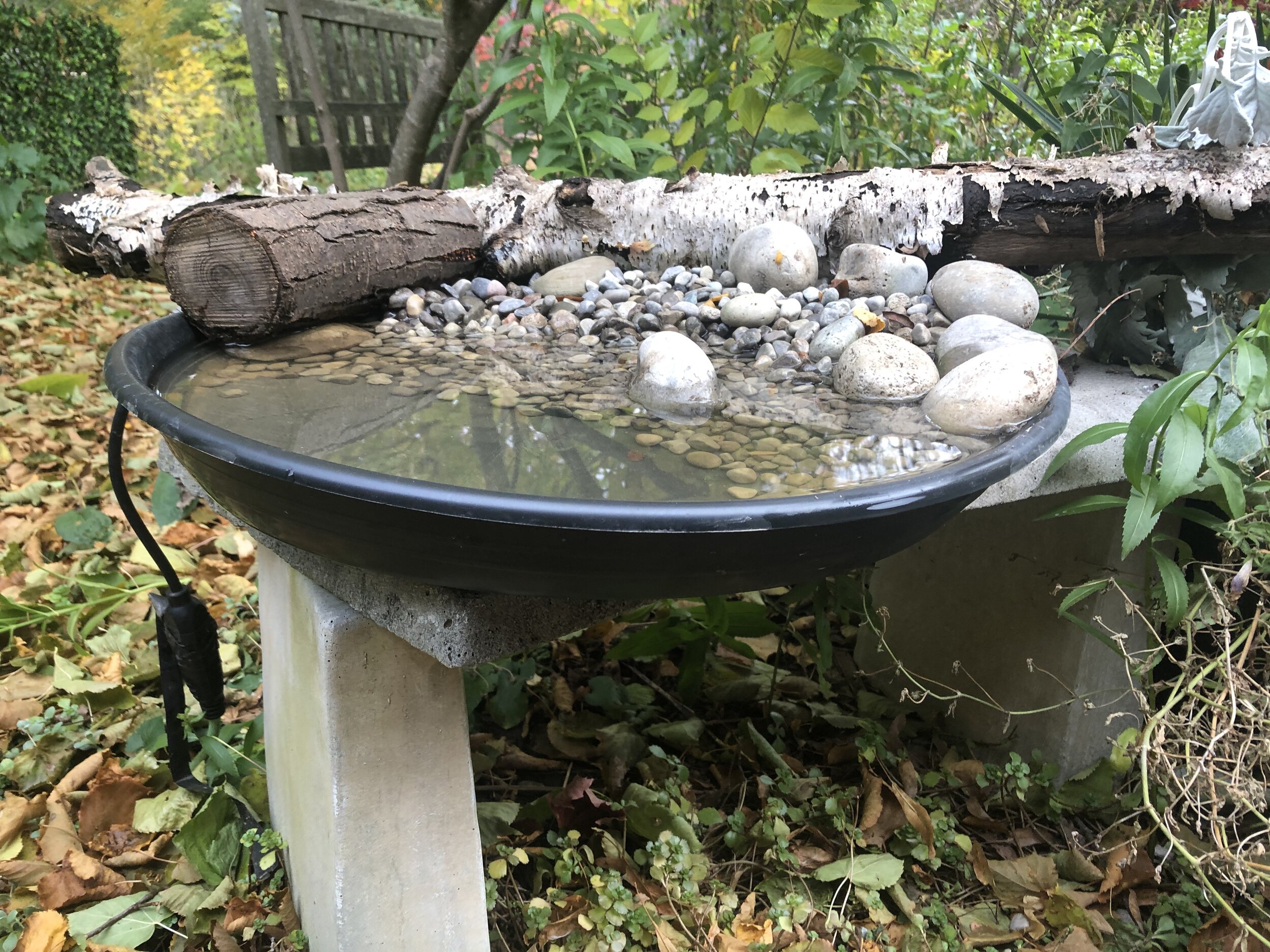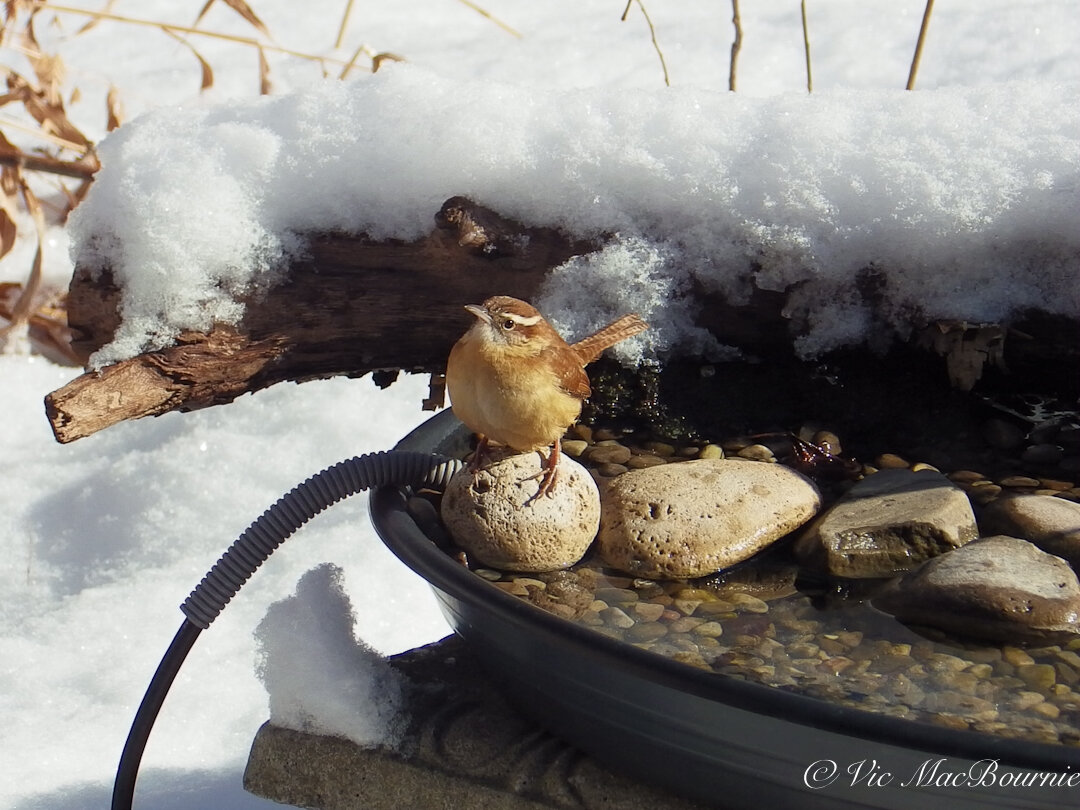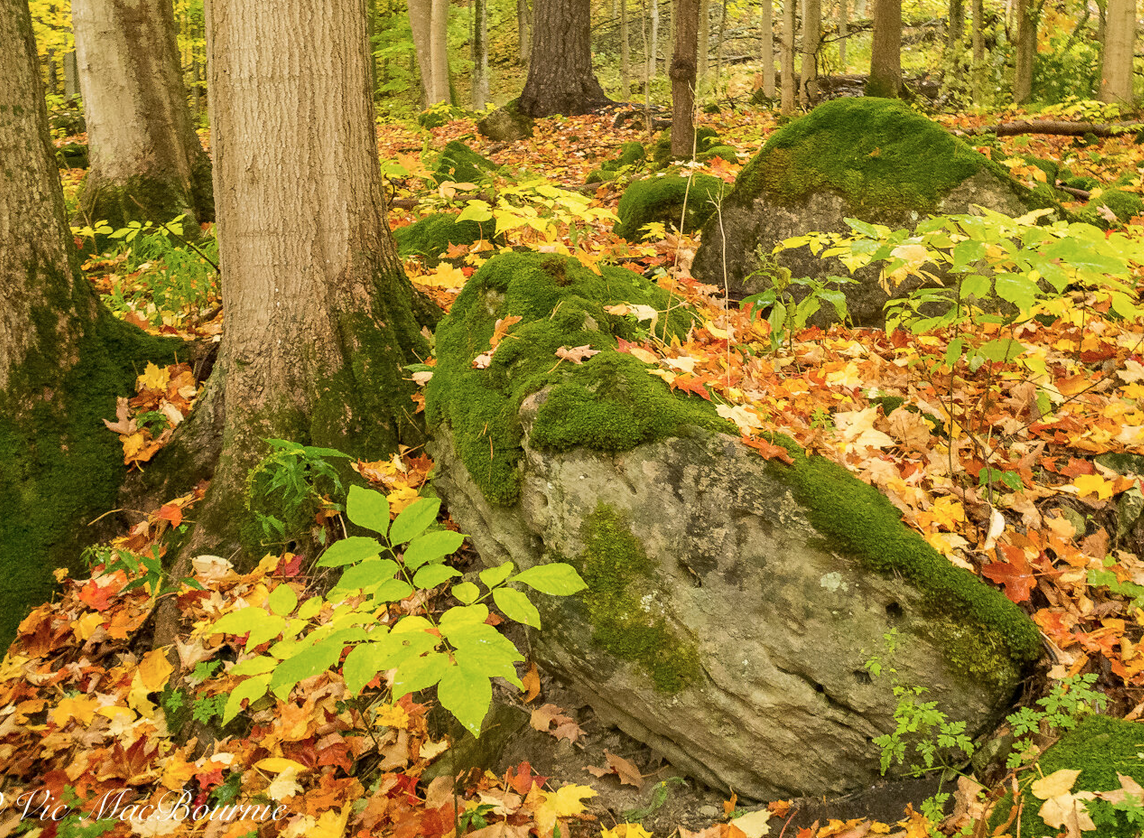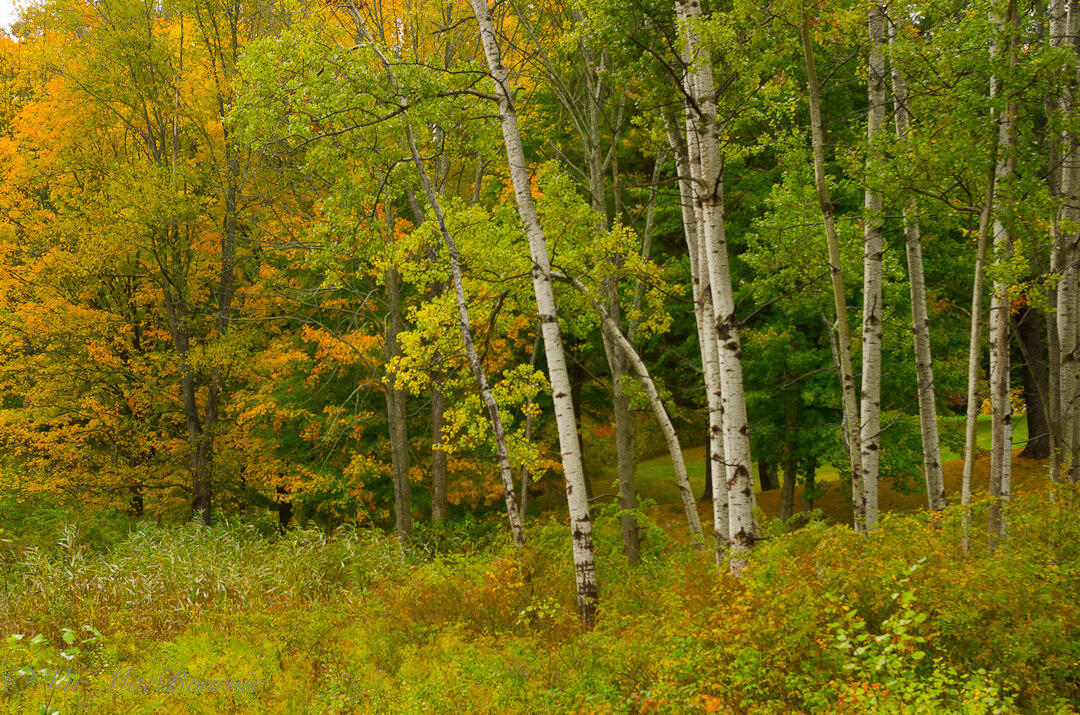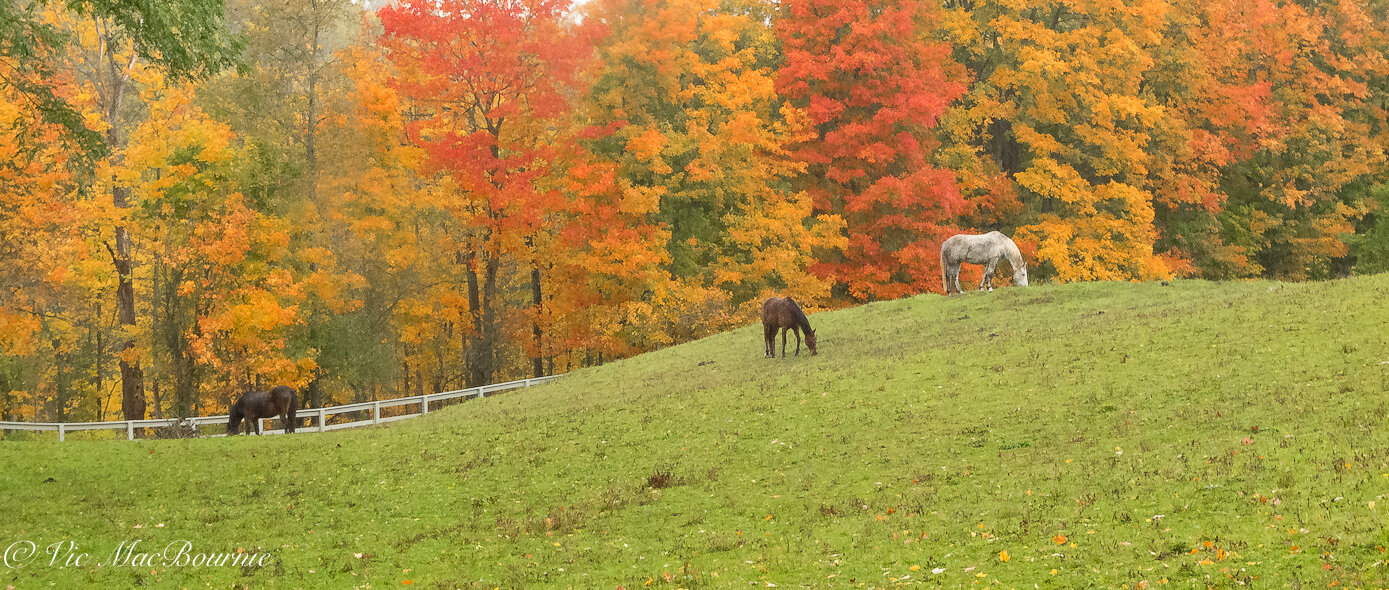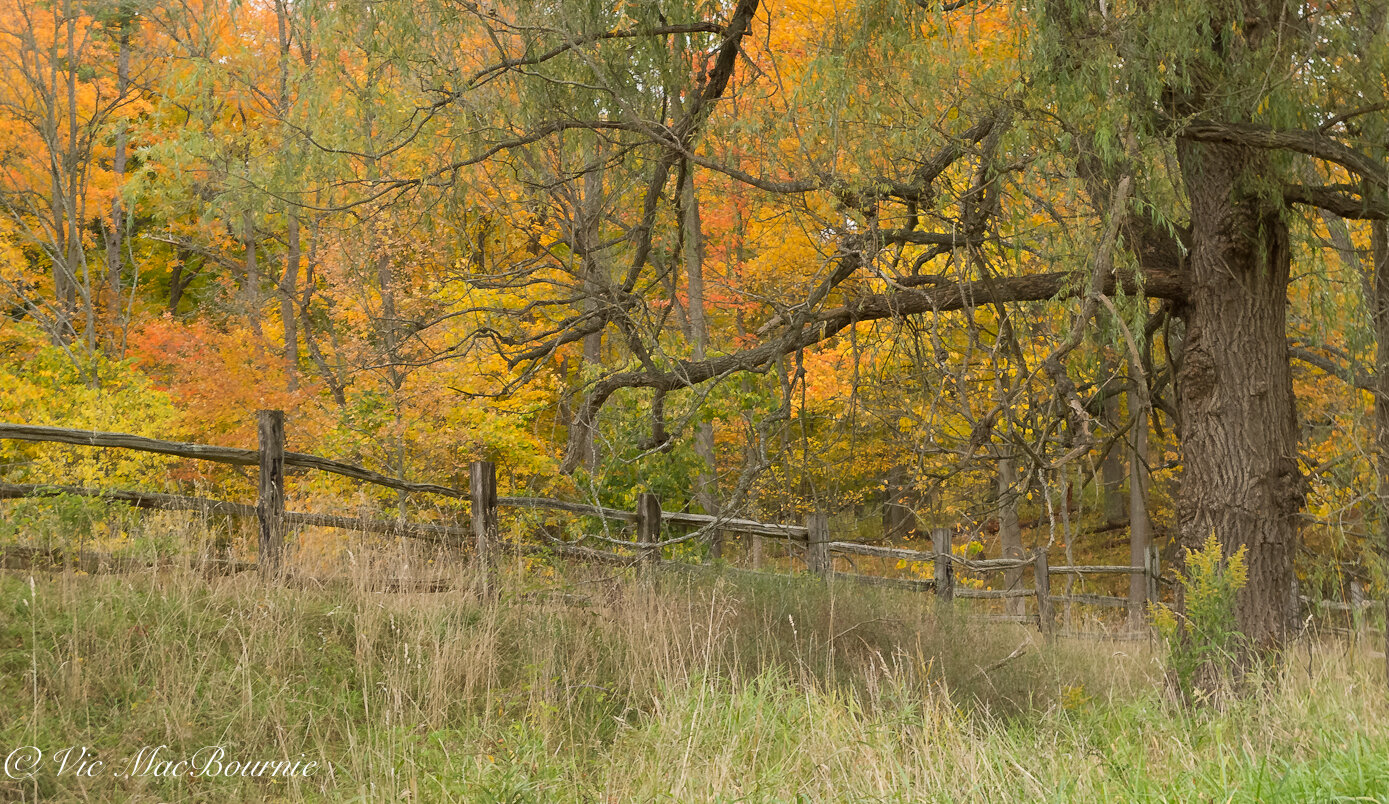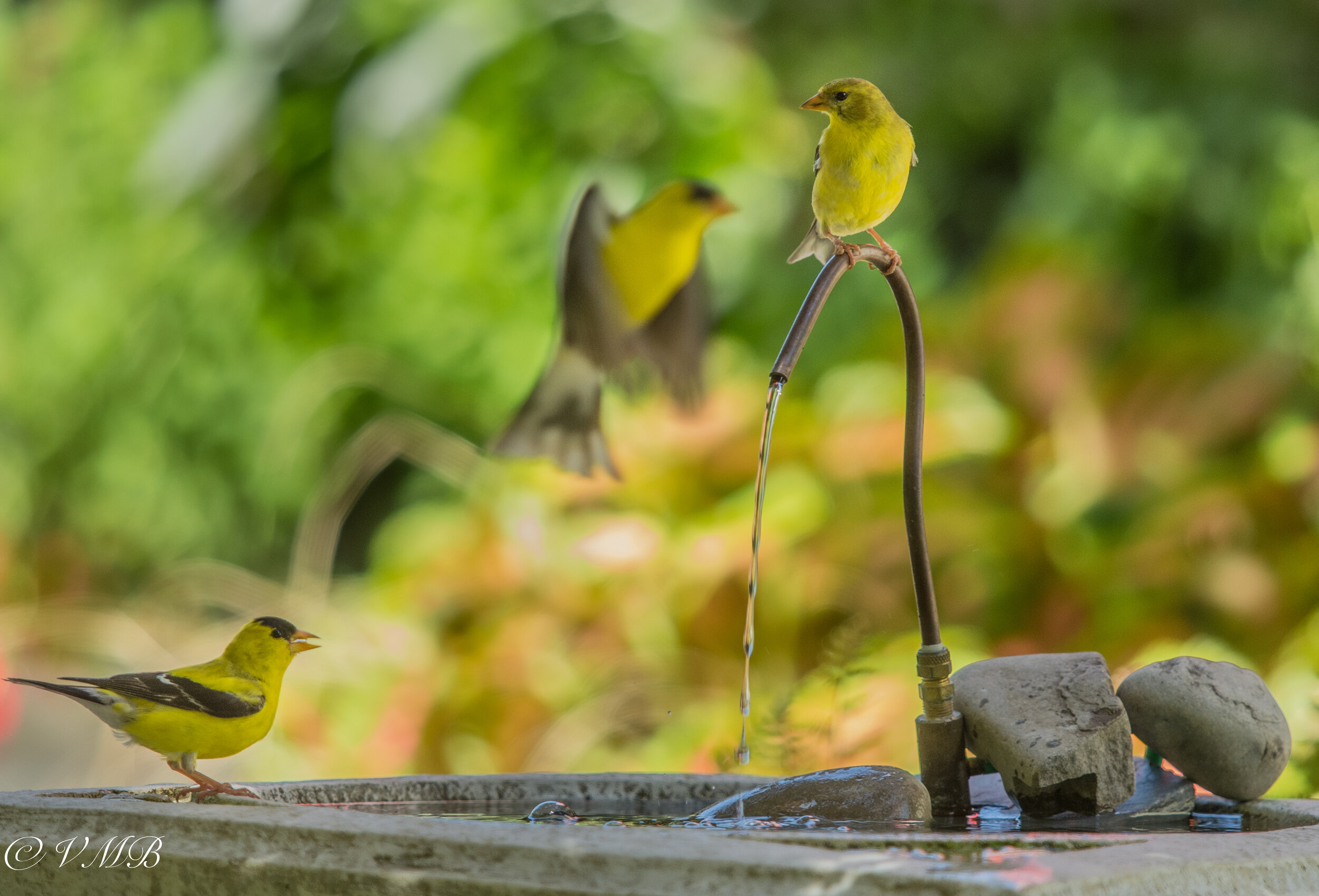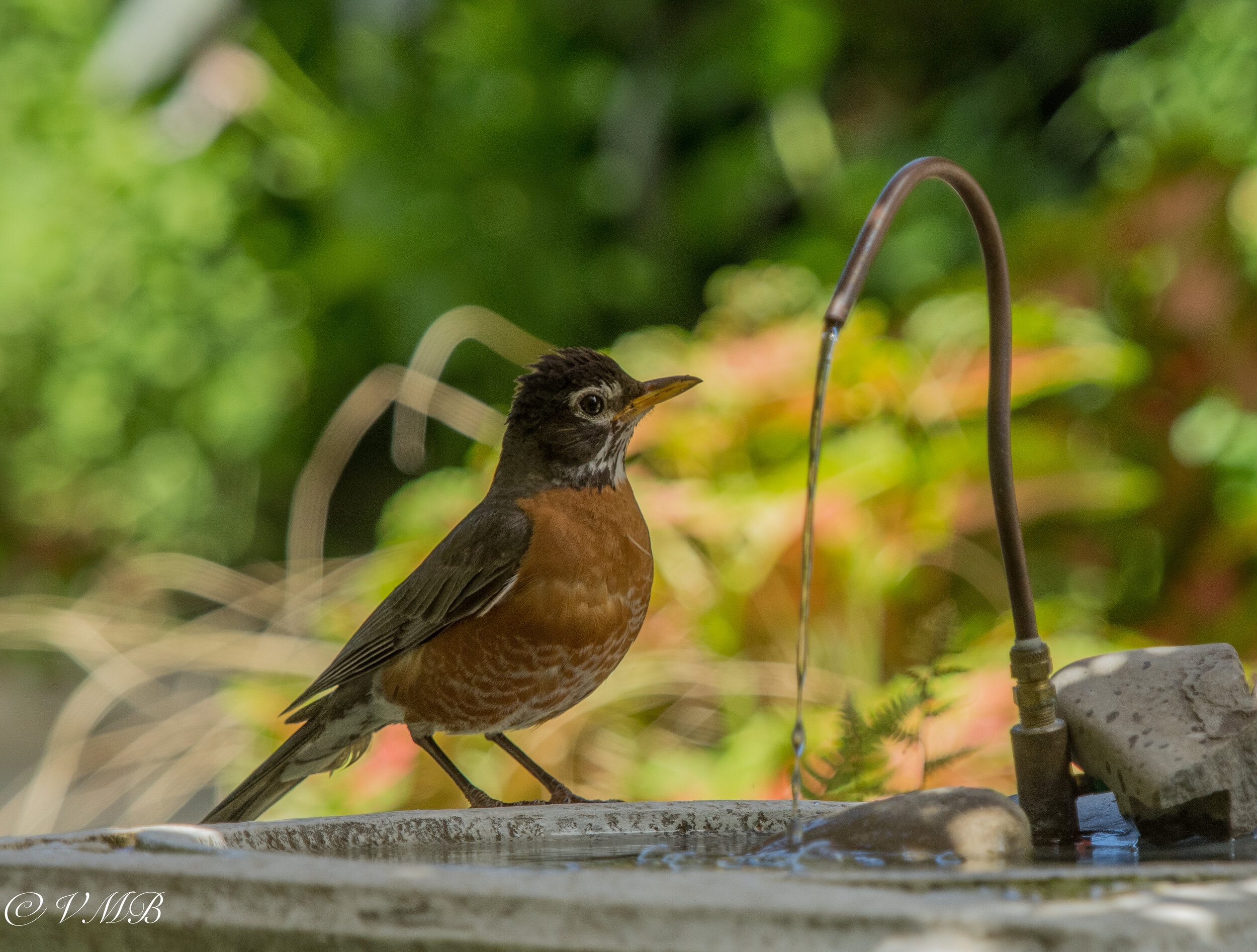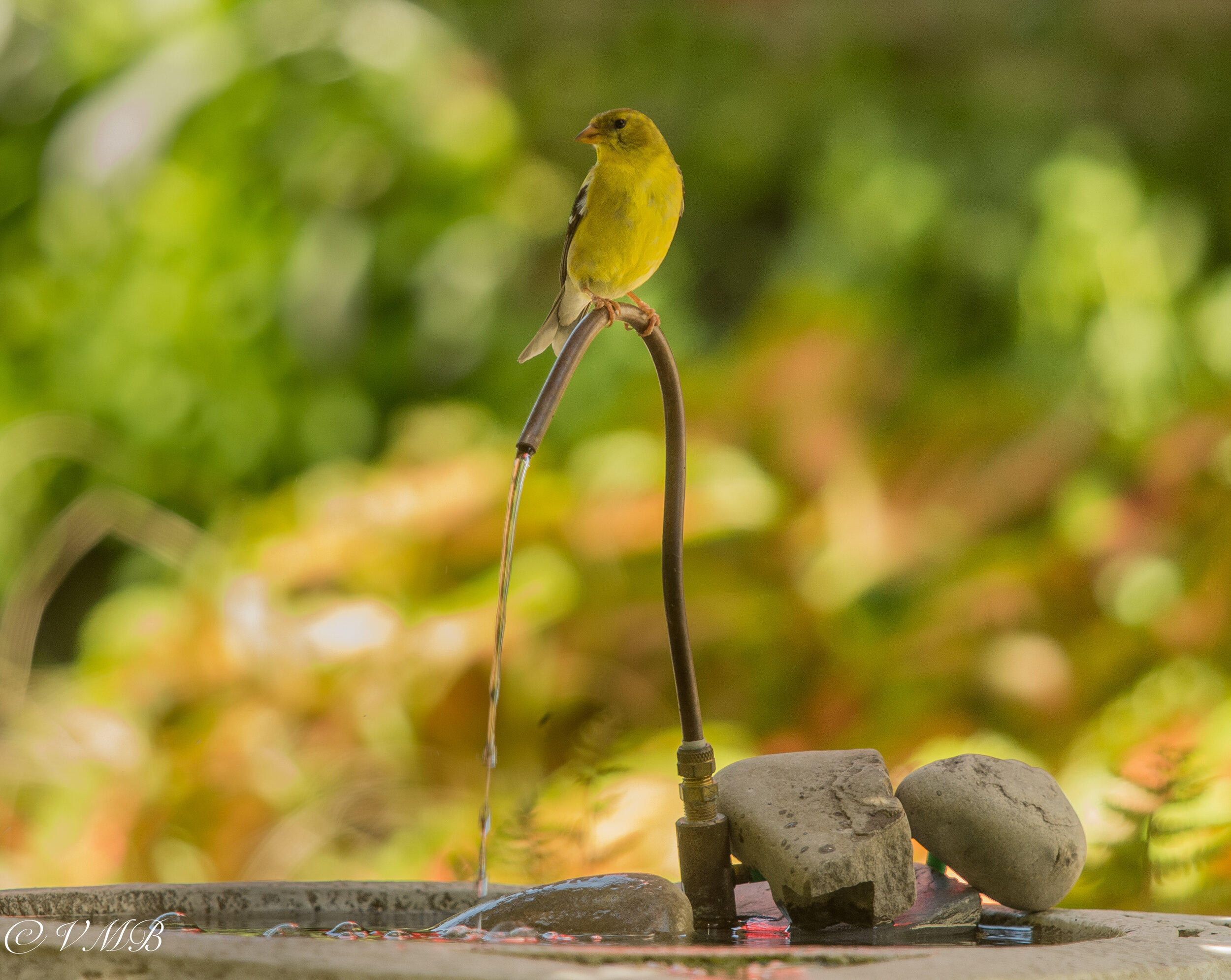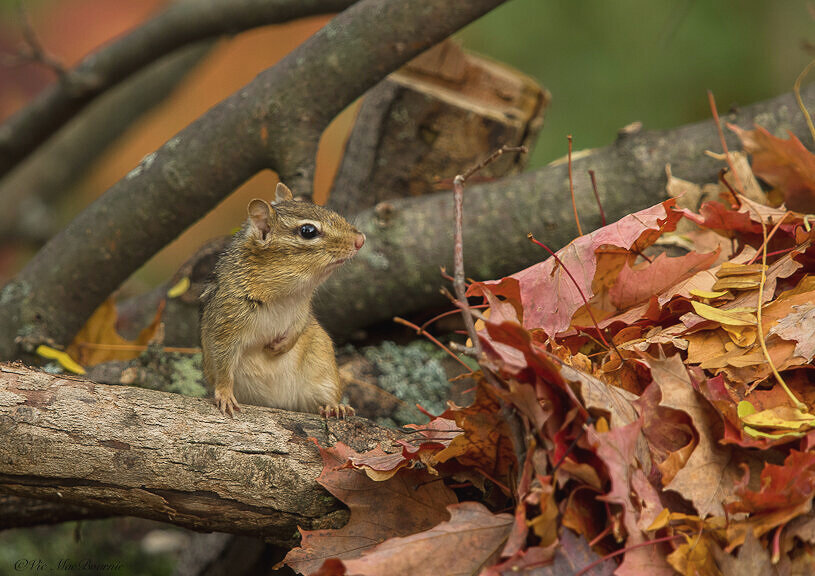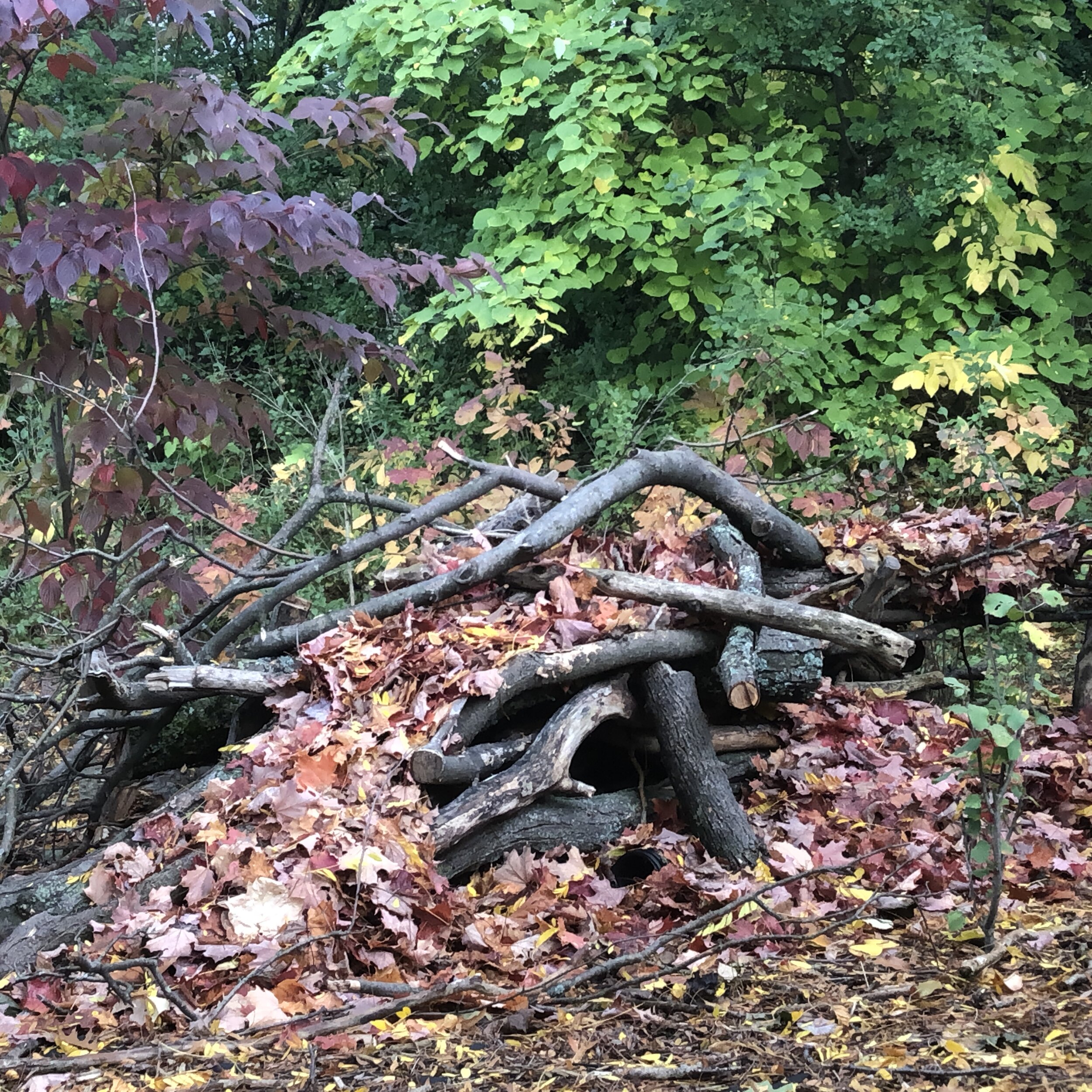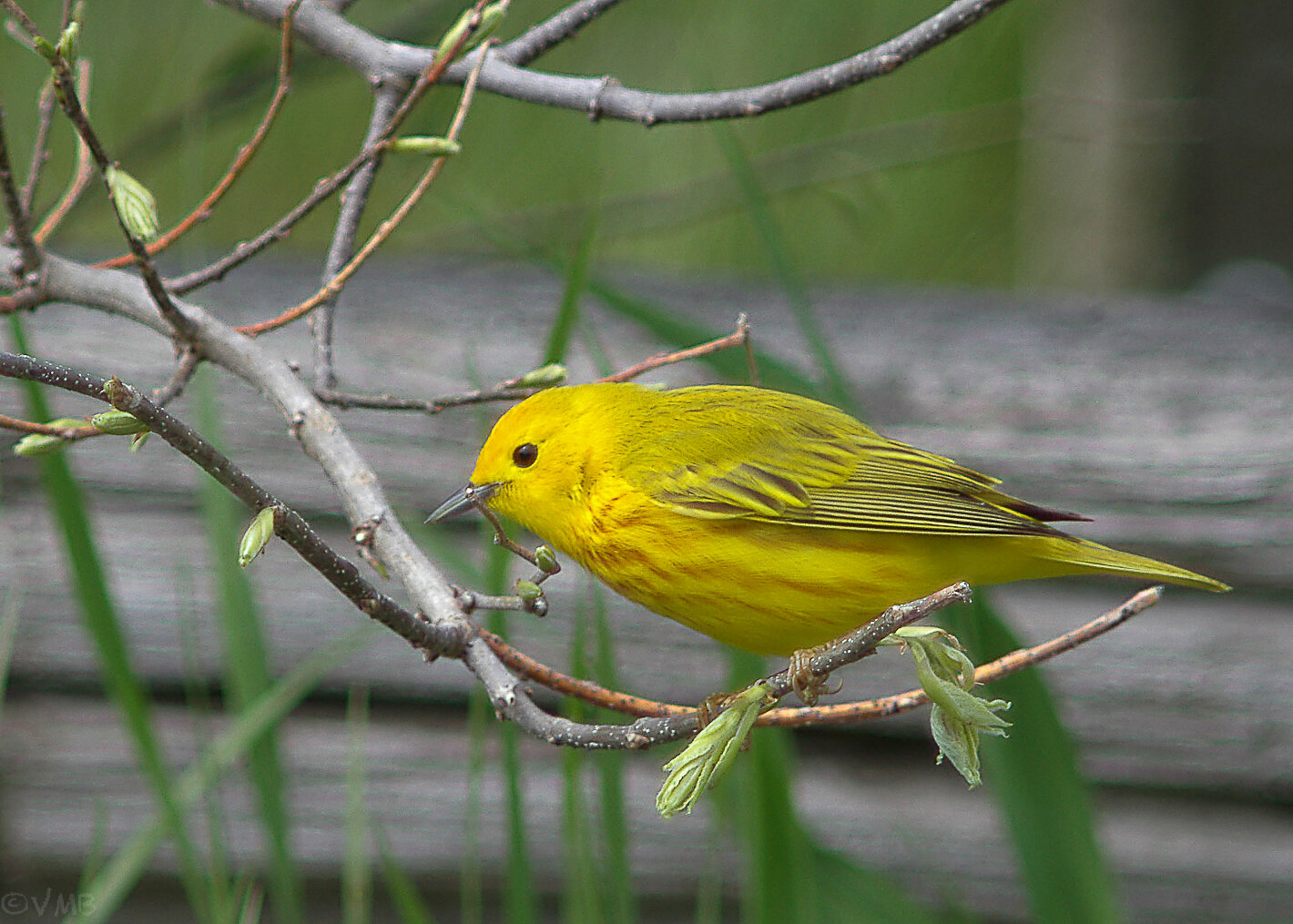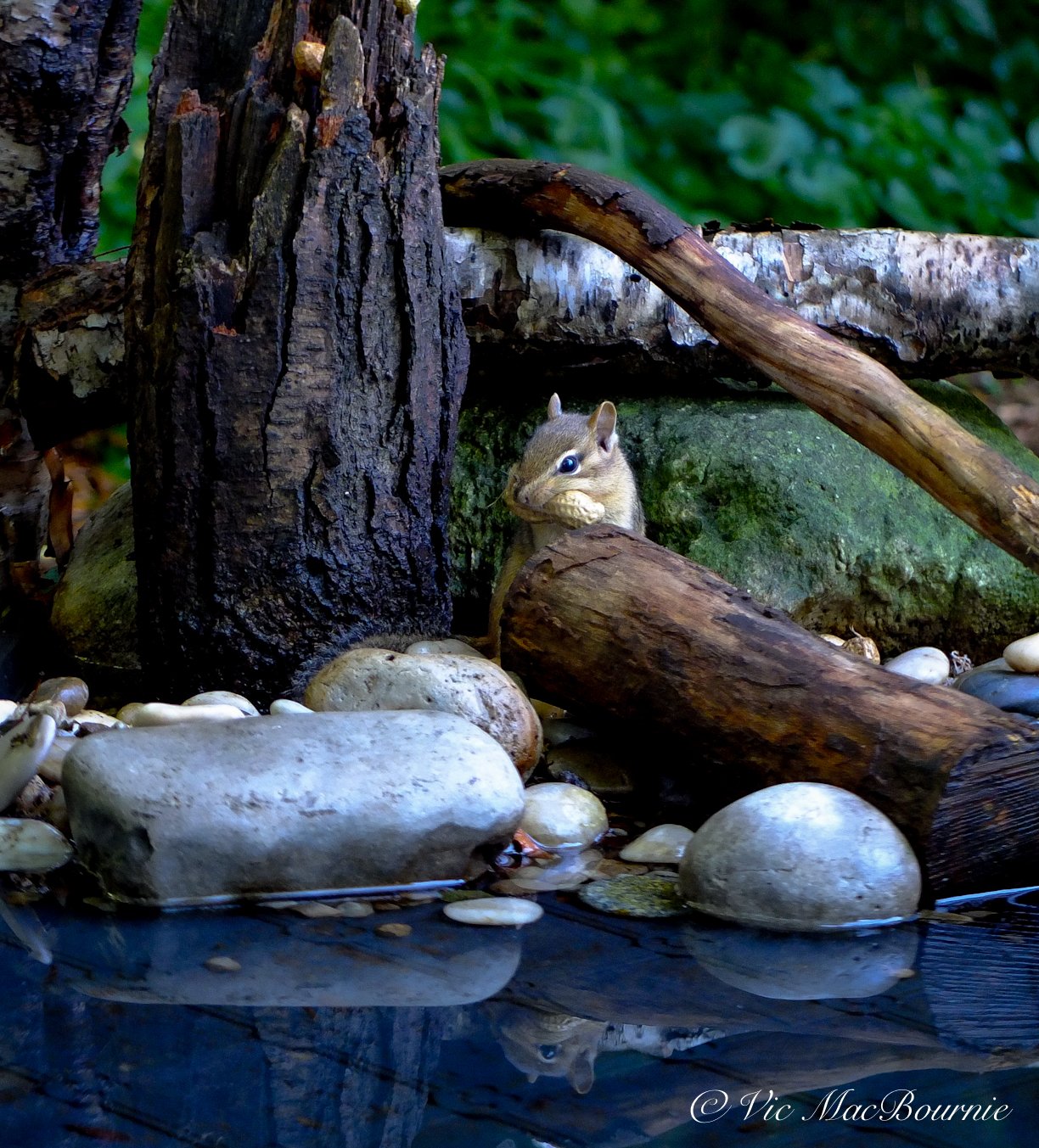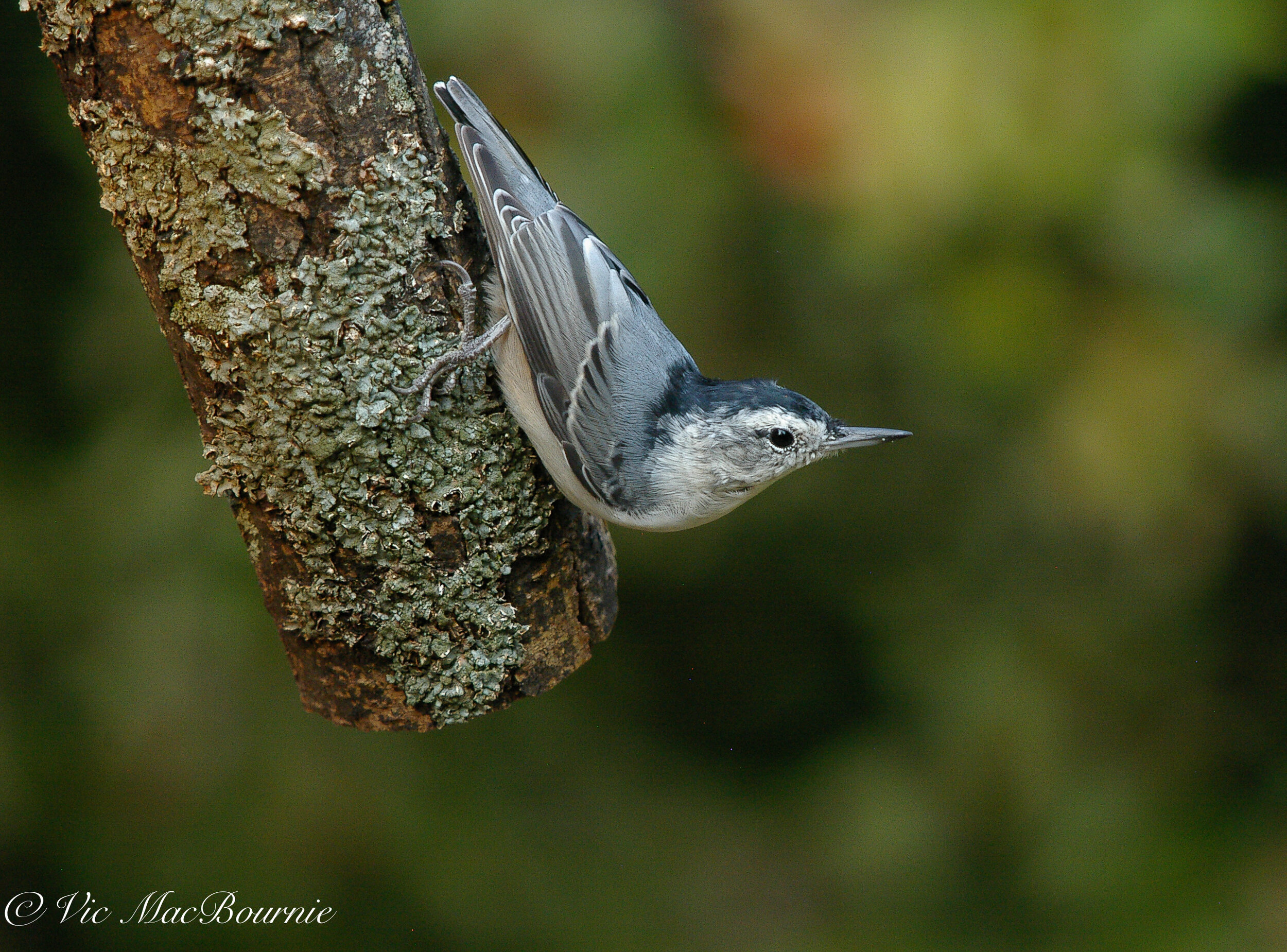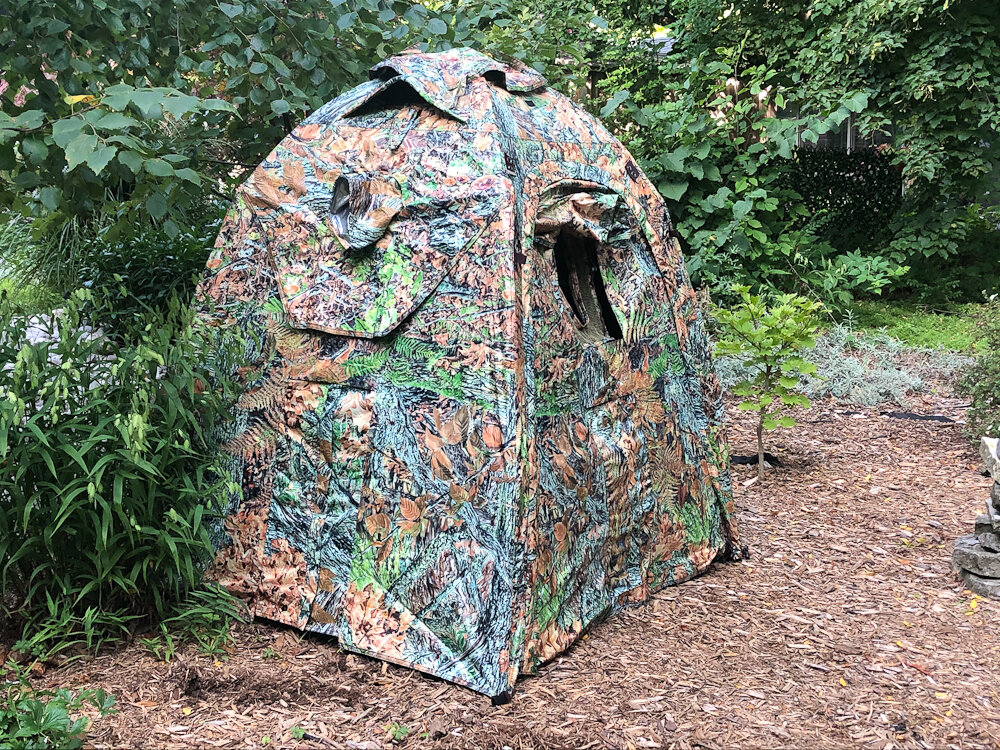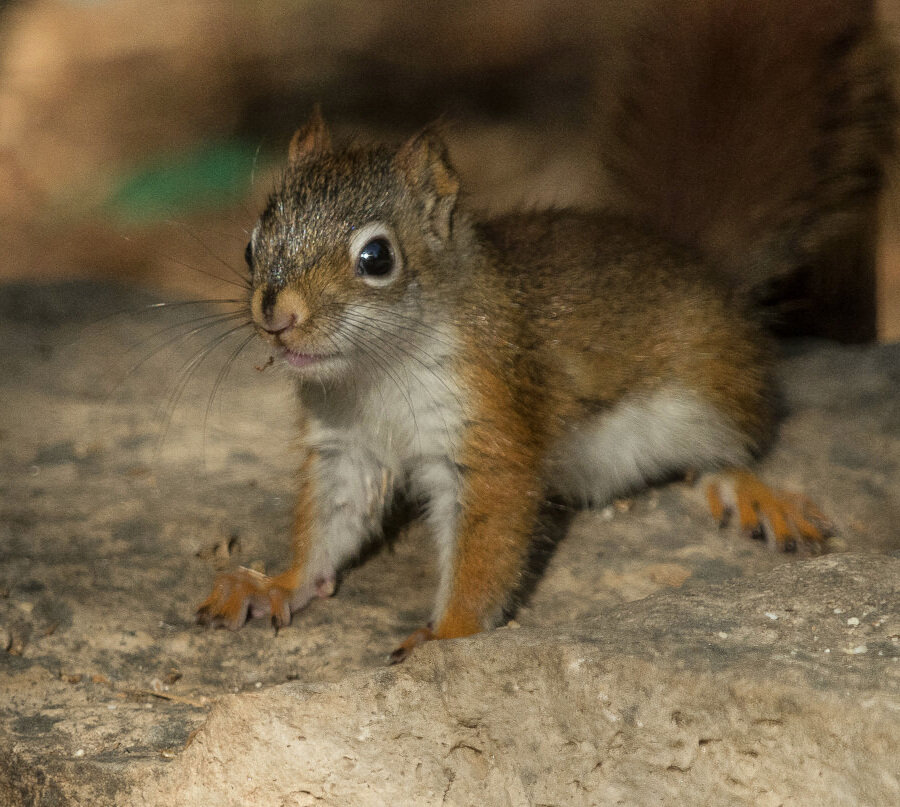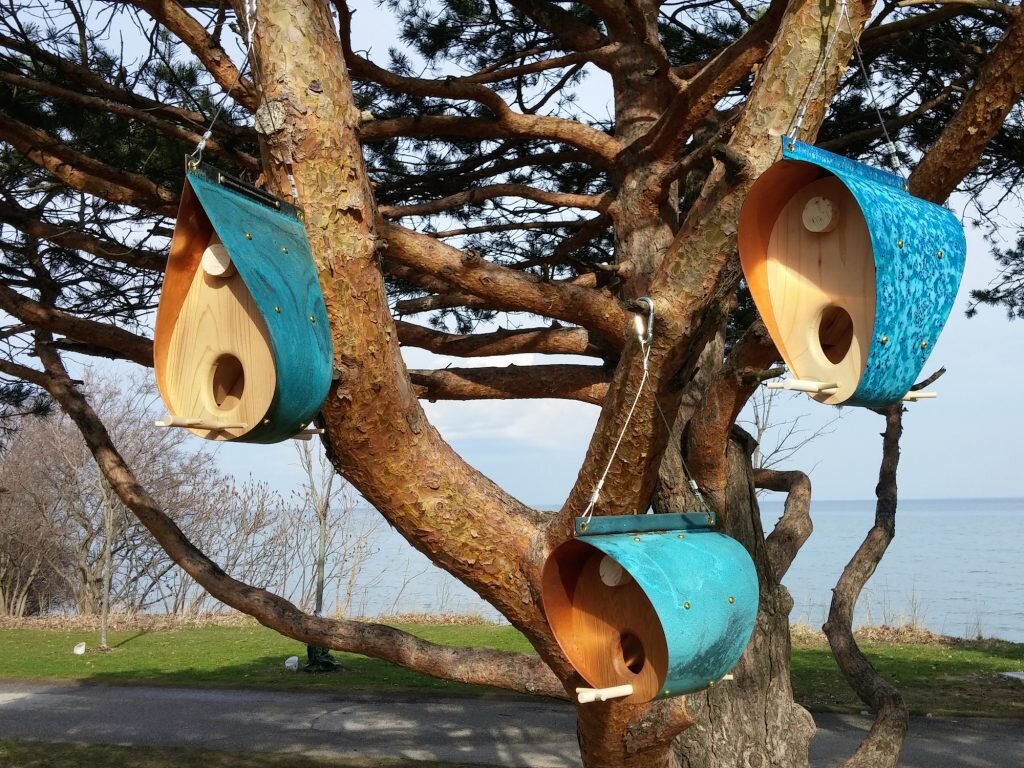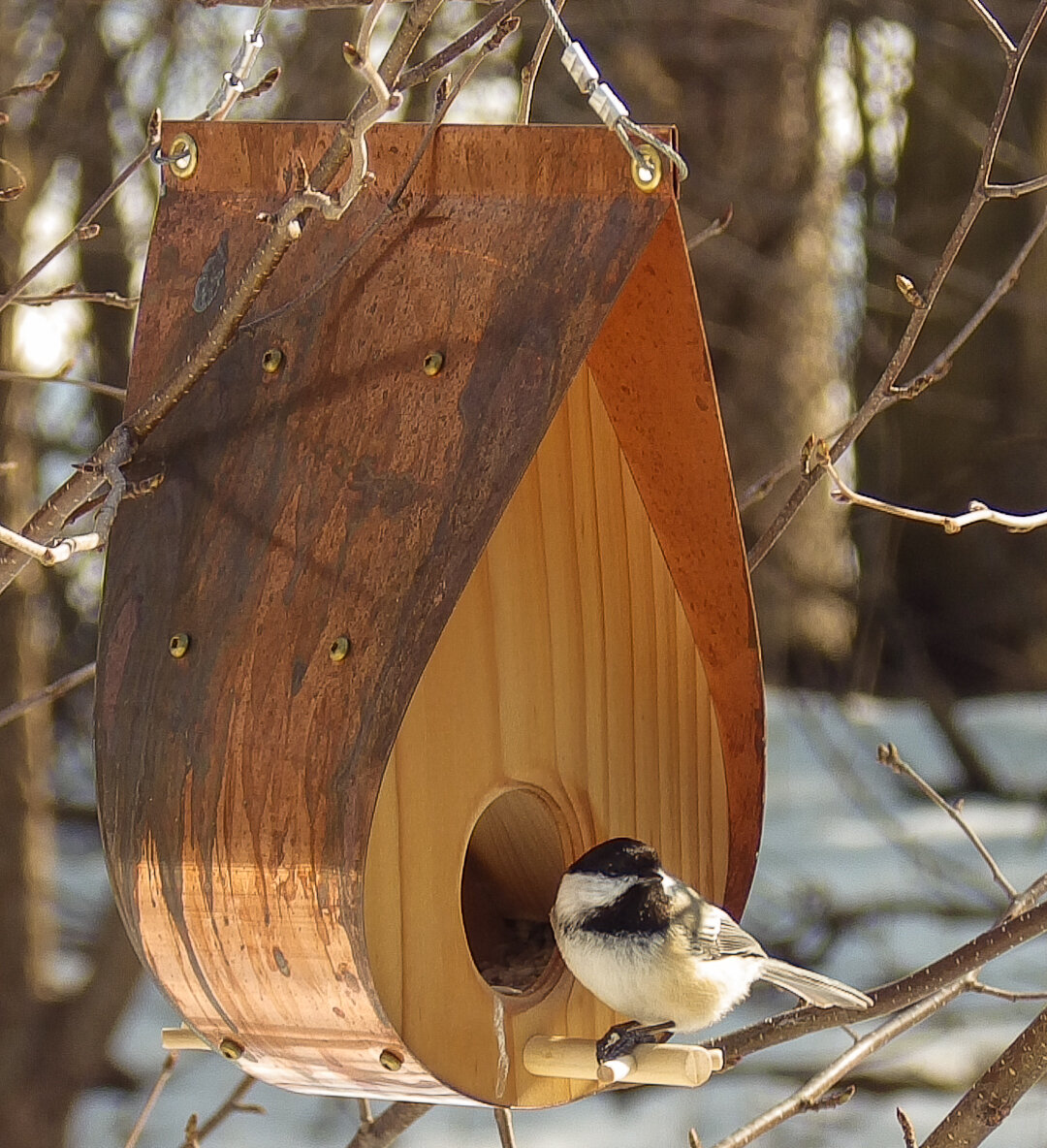How to attract nuthatches to your woodland garden
How can you not love our Nuthatches? Spunky, busy little blue-grey bundles of energy that, for most of the year, can’t stop talking. And how can you ignore their acrobatic routines while they make their way up and down tree trunks and branches looking for insects?
How did nuthatches get their name
Who doesn’t love a nuthatch?
These perky little birds – as cute as a chickadee and at least as busy – have developed a real fan-club following from bird lovers. Whether it’s the white-breasted (Sitta carolinensis), or the red-breasted (Sitta canadensis) these lovable little birds characterized by large heads, short tails and strong bills have become welcome visitors to our backyard landscapes and bird feeders in parts of Canada and the United States through to Mexico.
Their constant flitting from bird feeder to the nearest tree in our woodland gardens has earned them more than a growing fan base, it’s also a big part of how they earned their unusual names.
While Nuthatches are racing to and fro, they are actually taking seeds and “nuts” from the feeder and stuffing them into any crevice they can find in tree bark. Later, they return to hack away (or “hatch”) at the seeds with their small, pointy bills. And thus, their common name was born – by combining one of their favourite foods the “nut,” with their method or retrieving it “hatching.”
And so, we have the Nuthatch.
Red-Breasted Nuthatch in Pine tree.
Friendly enough to eat out of your hand
Maybe these little birds with their blue-grey back and white undersides have gained a following because, after a little practise, they are one of the birds that will readily eat out of your hand. Maybe it’s just because they always seem so darn busy – like a wind-up toy that never unwinds.
It does not take long to realize that Nuthatches have a wide assortment of whistles, trills and calls in their repertoires. Their breeding songs are simple and often identical to their contact calls. Cornell School of Ornithology has excellent recordings of the red-breasted Nuthatch various sounds. You can listen to them here.
Red-breasted nuthatch in winter storm.
How to attract Nuthatches to your feeders
They are certainly one of the busiest birds at our feeders. Maybe because they really can’t decide what they should snack on next. They are not particularly picky, readily feasting on sunflower seeds, nuts, meal worms, as well as high-calorie suet or peanut butter.
I have also found that they are big fans of Wild Birds Unlimited’s, Bark Butter. Not surprising, since Bark Butter attracts 152 different bird species. It’s expensive stuff, but if used sparingly, it is a great addition to your bird feeding area. I use it to fill holes that I drilled into a branch hung from the feeders. This way I can keep the squirrels from getting to it before the birds devour it.
But back to Nuthatches.
White-breasted Nuthatch photographed from Tragopan blind in our woodland garden.
It would not be hard to think, considering their activity at our bird feeders, that Nuthatches were primarily seed eaters. In fact, they are primarily insectivorous eating copious amounts of insects providing a natural control where insect infestations and caterpillar outbreaks occur.
When they are not “hatching nuts” these small passerine birds forage for insects hidden under bark by climbing along tree trunks and branches often upside-down. Their acrobatics are even more pronounced as they forage headfirst down a tree looking for dinner.
Planting natural sources of seeds, such as sunflowers, black-eyed Susans, coreopsis and other seed producers as well as Oaks, Beech and Hickory trees will not only provide them with nuts but also insects and caterpillars who live on the trees and nesting sites.
While I get great enjoyment from my bird feeding stations, providing natural food sources to our feathered friends is always the goal we should aspire to in our gardens. I have written a comprehensive post on feeding birds naturally. You can read about it here.
Evergreens, including pines and cedars are favourites of nuthatches both for their seeds and ready supply of protein-rich insects and caterpillars.
Ten cool facts about Nuthatches
1) Nuthatches are known to be one of the noisiest birds in the spring, but grow pretty much silent when breeding.
2) There are 24 different species of nuthatches in the world.
3) Most nuthatches are highly sedentary, seldom moving far from where they were originally hatched.
4) They have been called mud dabbler and mud stopper because of their habit of putting mud around the entrance hole to its nest.
5 Studies have shown that large gardens with oak trees provide the best habitat for nuthatches. This is not surprising considering the importance of the oak tree to hundreds of insects, caterpillars and pupae – the prime food source of Nuthatches.
6) Thanks to the growing use of bird feeders, Nuthatches have been able to expand their habitat.
7) Nuthatch pairs are strongly territorial partially because they have stored so much food throughout their territory.
8) The Nuthatch is able to move both up and down a tree looking for bugs or seeds.
9) Although dimunitive in size, these birds can be bold and aggressive at the bird feeder if larger birds try to intimidate them.
10) Their numbers fluctuate widely anually depending on the severity of winter and the availability of seed.
Where Nuthatches live
These cavity-nesting birds are happy to move into former woodpecker holes. It’s always a good idea to leave older trees and snags to give birds natural places to nest, but Nuthatches will also use bird houses if necessary.
“Some birds are not meant to be caged, that's all. Their feathers are too bright, their songs too sweet and wild. So you let them go….
-Stephen King
The nuthatch in winter storm.
Most of the species are non-migratory and live year-round in their habitat although some red-breasted nuthatches living farther north will migrate to warmer regions during the winter.
Did you know
Did you know that the Nuthatch rarely sleeps in the same cavity two nights in a row? And that when it leaves its secret resting place in the morning that it carries away its droppings in its beak? It may be done for the sake of cleanliness, but the main reason is to remove andy sign of the bird’s presence, so a predator cannot tell that this is one of the nuthatch’s secret roosting spots.
Nuthatches far and wide
Although we are familiar with the North American white- and red-breasted nuthatches that live basically from southern Canada into Mexico, there are many others spread out around the world including the Corsican and Chinese nuthatches, which are related to the red-breasted nuthatch, but have separate breeding ranges. They are similar in habitat preference, appearance and song.
In addition, the Eurasian, chestnut-vented, Kashmir and chestnut -bellied nuthatches form another superspecies and replace each other geographically across Asia.
In fact, there are close to 30 different Nuthatches spread out around the world.
Nuthatches are, for the most part, small compact birds with short legs, compressed wings and square 12-feathered tails. They can vary in size from the large giant nuthatch and 195 mm or 7.7 inches to the tiny brown-headed nuthatch and pygmy nuthatch that both come in at 100 mm or 3.9 inches in length and a mere 10 grams or 0.35 oz.
If you love backyard birds, don’t forget to sign up for my free backyard bird newsletter. You can sign up by going to the bottom of the home page and use the form. The second newsletter will be coming out in early December. Thanks
This page contains affiliate links. If you purchase a product through one of them, I will receive a commission (at no additional cost to you)
How to protect birds from cats
Every year millions of birds become victims of outdoor cats allowed to roam free. Birds are not the only victims, chipmunks, rabbits and red squirrels are also victims in the killing fields of backyards across Canada, the United States, Europe – anywhere where cats are allowed to roam. Clawed Monet was not part of that problem. He was a good boy.
In Canada, cats kill 200 million birds a year
He never once caught a mouse. Never chased a chipmunk. Not once did he kill a songbird.
Our indoor cat, Clawed Monet, simply watched their lives from the comfort of an open window when the weather was good, and from behind the glass when the cold winds of winter sent most of our forest friends under ground.
Outdoor cats have decimated an already declining songbird population that has seen a 75 per cent decline since the late 1960s. A study by researchers at two Canadian universities found neonicotinoids – a family of insecticides – to be a leading cause of this decline, but be assured that outdoor cats are a major contributor to this decline as well.
It wasn’t that Monet couldn’t handle himself out in the real world. He came fully equipped with four sets of very sharp claws and a couple of feline fangs that would scare most canines, domesticated or wild.
But Clawed Monet was an indoor cat – one of millions of cats that stay indoors, safe from cars, trucks and your neighbour’s rodent poisons. Fleas, ticks, mites, intestinal worms are rarely a problem for indoor cats. Neighbourhood cats, coyotes and, depending where you live, larger prey animals like alligators that see cats as nothing more than a morning meal, are not their problem.
Monet loved to sit on the table or the back of the pink couch to watch the world pass by outside the window in the Woodland Garden.
Estimated 60 million feral cats in the United States
The problem is that Clawed Monet represents a small fraction of the total number of cats. Most of the approximately 88.2 million cats in the United States alone are left on their own day and night to wreak havoc on a natural world not prepared to deal with an introduced predator and certainly not one as efficient as a house cat, or worse, a feral cat. The American Humane society estimates there are 60 million feral and homeless stray cats living in the U.S. alone. for the most updated statistics on feline numbers in the U.S. check out this website.
These cats carry and spread diseases such as feline leukemia, feline AIDS, feline infectious peritonitis, feline distemper and upper respiratory infections.
For more suggestions and some of my favourite garden things, be sure to check out my Favourite Things post.
But more importantly they are a major contributor to the decline of our backyard birds.
In Canada alone, a 2013 study by Environment Canada scientists in the Avian Conservation and Ecology journal, states cats are the number one killer of birds in Canada. The report adds that bird deaths by window collision is a distant second claiming 25 million birds per year.
In Canada alone, the study estimated that cats are responsible for 200 million bird deaths each year. Imagine the number of deaths when you include cats from the United States, Europe and elsewhere.
It’s a tragedy that does not have to exist. And it’s growing, as more and more cats are introduced to our world either as pets or, even worse, escaped pets that become feral.
How to keep birds safe in your woodland garden
Steps can be taken to help protect birds in your garden. We find that having a dog is certainly a good way to keep cats our. Our dog, Holly has always lived with a cat and she has never harmed a single animal that comes into our yard, but if a stray cat wanders into the yard, Holly’s frantic barking will clear any cat that knows what’s good for it out of the yeard.
But there are many other simpler solutions that can go a long way to keep bird safe.
• Keep your bird feeders and bird baths a safe distance from cover that can conceal a cat. Ideally, feeders should be 10-12 feet away from cover that could leave the birds susceptible to an attack
• Thorny bushes will help discourage cats from feeders and provides perfect safe zones for birds. They could also offer fruit or nesting habitat for backyard birds as well.
• Fencing can help to keep feral cats out of your yard or, at least, help keep them back from feeders and birdbaths.
• Ensure your birdhouses are cat-proofed. Not only should they be at least eight to 10 feet off the ground, try not to have perches large enough for a cat to use to help them gain access to the inside of the nesting box. In addition, extenders can be added to the nesting box access holes to make it difficult for cats or raccoons to reach into the boxes.
• Ensure that feeder poles are metal and have squirrel baffles to stop cats from getting up on feeders.
Birds are not the only wildlife killed by cats
It’s not just birds that are victims of outdoor cats. Millions of chipmunks, red squirrels, rabbits (both young and tiny babies) are brutally killed each year, their bodies often just left behind because many cats simply kill their victims out of instinct rather than a source of food.
The mass killing of small predators leaves less for natural predators like fox, coyotes, owls and raptors that depend on an abundance of these food sources for their own survival and that of their young.
According to the 2013 study, Canada’s wild bird population are estimated to have declined 12 per cent in the last 40 years, with some populations decreasing by over 95 per cent.
Ted Cheskey, a conservationist with Nature Canada, reported that “cats have contributed directly to the extinction of 34 species of birds” globally.
The report, based out of British Columbia, focused on the particular threat to that province’s island-based bird populations explaining that a new predator, like a cat, can totally devastate a colony that previously had few predators.
In a comprehensive article on the subject, the CBC quoted Cheskey stating that: “The cats, they’re indiscriminate on who they choose to kill. It can be a common bird, but it can be a bird that’s perilously close to being wiped out as well. It’s a big problem.”
The American Humane Society explain that a “cat’s prey drive is so strong that even well-fed cats may naturally enjoy hunting birds or other small animals. Although the impact made by one cat might not seem like a big deal, it is important to think about the total impact of all the cats who are allowed outside. Loose cats are estimated to kill hundreds of millions of birds each year, yet birds are believed to be only 20 per cent of the wildlife stray cats kill. Birds are especially at risk around homes with feeders and birdbaths.”
Saying goodbye is never easy
This week I stood beside Monet comforting him as the veterinarian administered the two needles that quietly and peacefully took his life. Because of the Covid-19 pandemic, my wife had to say her goodbyes in the parking lot outside the cat clinic. In a world where thousands of people are dying from the pandemic every day, Monet’s passing seemed small in comparison.
But to our family and his best canine friend, Holly, it marked a sad day.
There is comfort that he was allowed to live a full life, safe from the dangers of the cruel world outside his home. There was comfort that he left the world without ever playing a role in the mass destruction of the woodland gardens he loved so much to watch over – the world he saw from his favourite perch on the back of the pink couch that suited his gentle disposition and his kind heart.
Clawed Monet was a Very Good Boy.
• This page contains Amazon affiliate links.
Tips for using water to attract birds and other wildlife
Bringing water into the garden provides so much enjoyment not just for gardeners, but for the birds, mammals and reptiles that depend on it for their survival. It does not have to be a large complicated pond. Here are a host of alternatives to garden ponds that are easy, inexpensive and rewarding.
Provide a reliable source of water in your wildlife garden
There are few things you could do for birds and other wildlife more important than having a reliable source of fresh, clean water in your woodland garden.
Birds require water not only for drinking but maintaining the oil in their feathers to help them fly, provide a form of waterproofing and to keep them warm in winter.
Our backyard birds do not have sweat glands, so they need less water than mammals. But, most of the birds that visit our woodland gardens still need to drink at least twice a day to replace water lost through respiration and in their droppings.
Although backyard birds have developed brilliant ways of getting water on their own, they still appreciate our efforts at providing water for them in our backyard landscapes.
We’ve seen them wading in to the shallow edges of ponds and streams for a quick drink, but have you ever watched them in the morning take water droplets that formed on leaves overnight? That’s great fun. I once watched a bird drink from one of my large hosta leaves that had gathered a large amount of water overnight.
How birds drink from our bird baths
Most birds will drink at your bird baths by dipping their bill in water and putting their head back to swallow it.
Swallows, swifts and other aerial species will actually drink on the fly by dipping their bills into the water and scooping up water in its beak.
Unlike seed-eaters, insectivorous birds get most of their water needs in the food they eat. Seed eaters, the most common birds in our gardens, have very dry diets and therefore will rely on our sources of water considerably more.
Blue Jays love their bird baths. Here is one of our resident blue jays diving in for a good soaking.
“I hope you love birds too. It is economical. It saves going to heaven.”
Although a pond with a waterfalls is the best choice to attract birds, not everyone has the room for a large pond, or the time to properly care for it.
So, what are the alternatives? It’s not uncommon to see birds flocking to natural water sources like puddles after a rain. In some areas without a reliable source of water, such puddles can be vital to their existence. Plus, like our kids, it’s fun to splash around in a puddle after a rain.
But we don’t want to force them to rely on rain puddles for their daily bath. In the garden there are many alternatives that are simple yet effective in bringing birds into your yard.
For more suggestions and some of my favourite garden things, be sure to check out my Favourite Things post.
One of the benefits of providing a reliable water source is that it will not only help attract birds to visit your yard and possibly set up a nest there, it will attract birds that might not normally not come to your woodland garden. Many of the most desirable birds are not attracted to your seed-based feeders because they eat mostly insects. Even heavy seed-eating birds will often switch to primarily insects during the spring when they are raising their young.
Warblers and blue birds, for example, are a good example of insect-eating birds that you may not see often in your woodland garden. Although the insects provide them with water in their digestive systems, they will be attracted to water for the important task of bathing. Fresh water is vital to attract all birds including warblers and bluebirds to your garden.
Water is especially important in winter. Bathing can mean the difference between life and death for many birds during the winter months. When the birds preen their feathers they are actually carefully rearranging them and spreading oil from the preen gland. This keeps the birds waterproofed and traps an insulting layer of air underneath the feathers to help keep them warm.
If the water in your garden moves, either through a drip system, a sprinkler or a bubbling rock, more birds will be attracted to your water sources.
A simple birdbath is a perfect place to start.
Birdbaths are an important addition to any garden that welcomes birds. They can be as simple as an overturned garbage lid, or elegant enough to serve double duty as a piece of garden art. A simple rock with a natural pool is ideal for the woodland garden.
Birdbaths are an easy yet simple solution to provide water in our woodland gardens
Watching the birds visiting the birdbath will bring hours of enjoyment to the backyard experience. Establish it close to where you regularly sit and the birds will eventually feel comfortable enough to take a drink or have a bath near enough for your enjoyment. A shaded spot in the garden preferable under a mid-storey tree with low hanging branches will help keep the water cooler and fresher for birds, and give them a place to land before going to the birdbath.
It’s also a good idea to have another bird bath in a more secluded area for more shy birds not yet comfortable enough with your presence to come in close. If you have a large tree near where you sit, consider a hanging birdbath.
I have found that adding a drip system (amazon link) to an existing birdbath, or one of the many new solar fountains also available at Amazon, you’ll find the birds will get the most enjoyment and use out of the bird bath.
Although a drip system is an excellent way to attract birds, I decided to turn a dripper into a recycling solar fountain that proved even more effective. You can read about the DIY conversion in this post on my website.
During winter months, I have found that adding a heater to the birdbath makes a huge difference. In fact, I have a separate post here where I built a small heated bird bath that doubles as an outdoor photographic studio. As we have talked about earlier, the attraction of a reliable water source in the winter, is critical to attracting all the neighbourhood birds. Remember to locate the birdbath close to an electrical outlet so that you can keep the heater plugged in at all times. Most do not use much electricity at all, turning off and on when necessary and only heating the water enough to keep it from freezing.
On-ground water sources are vital for birds and wildlife
Another extremely important decision for the birds, mammals and reptiles in your garden is to add on-ground water sources. These water sources could be as simple as a sunken old Tupperware container or plastic garbage can lid, or as involved as a small in-ground vinyl pond. Be sure to provide a way for birds and small mammals to escape the water should they fall in.
A young Baltimore Oriole takes a bath in one of our on-ground water sources.
The importance of on-ground water sources was made clear to me one afternoon when a mother Baltimore oriole brought her entire family to one of our on-ground water sources. One of the young orioles is pictured here bathing in one of our moose’s ears. (Each ear acts as a small water pond) All of the young orioles took turns having a bath while mom stood by on the watch for possible dangers.
A recent addition to the garden are a grouping of three large water bowls. I originally bought them more for aesthetics (think Japanese water bowls) but I am amazed how many animals and birds are using them. They are much deeper than a traditional bird bath but I have put a couple of rocks in them to allow critters easy escape if they fall in.
When I put in the waterbowls in, I had no idea that they would become a “bird bath” for a large Goshawk that decided this spring that the bowls were a perfect size birdbath for this large bird of prey. I’m hoping he is a regular to the backyard. We’ve seen him on the hunt several times now.
On another day, a fox came by to drink from the large water bowl. I have seen the fox there regularly so I suspect it was using the water bowls on a daily basis. You can go here for a separate blog post about the fox and the waterbowls. I have also included a picture of the fox at the water bowls.
The bird baths are really just the first steps to providing a source of water in your garden.
In our garden, we have added two more water sources that have provided endless enjoyment without the hassle of a full backyard pond.
Patio container provides water source and place for new plants
One of my favourite water sources is our patio water container that not only provides a source of water but, more importantly, allows me to enjoy a few water plants, including a water lily and miniature bull rush that I would not be able to grow without this water source. It is a simple concrete container with an inexpensive solar pump I purchased several years ago that provides me with constantly moving water most days. The moving water is enjoyable to listen to, enticing for birds and helps to keep the mosquitoes at bay. The bull rushes and watr lily leaves attract dragon flies and other more unusual insects which in turn become food for the birds.
These large water bowls were originally going to be used primarily for aesthetics until a large Goshawk decided they were perfect as an oversized raptor birdbath. Before long, our neighbourhood fox was using them as well. There is a link above for a separate post on the fox and the water bowls.
All the water and plants are removed in the fall. Some of the plants I have managed to winter over in the shed, others are purchased in the spring. Because the patio water container is small, I need only a few plants each year to create a beautiful miniature water-garden container. There are no fish in the container but the water stays perfectly clear. It is important to have enough plants to cover the surface of the water to shade it enough to eliminate the growth of algae. The choice of plants here is endless, so if you are looking to experiment with some new plants, I would definitely recommend a water container garden.
A few water hyacinths and small water lily is usually all it takes for mine to stay clear and fresh all summer. I have some miniature rushes and a little duck weed in this year’s container. Be sure to provide access for any small critter that might fall into the water.
The Patio water container is too deep for birds to safely bathe in, but some birds do go on the plants and get drinks from there.
Birds, squirrels and humans love a bubbling rock
Our final water source in the yard is a small bubbling rock that once again is run off a solar fountain. It’s a larger solar fountain (amazon link) that includes a battery to allows me to run the bubbling rock during the evening if I need to. I would love a much larger bubbling rock but this one gets the job done and was primarily a do-it-yourself project. It’s main purpose is to use the moving water to attract birds and other wildlife to the garden. It sits in the middle of our birch glen (three clump birch trees that form a lovely canopy that helps keep the water and the container in shade for most of the day.)
Installing a large bubbling rock can be an expensive proposition involving heavy-duty industrial equipment best done by a landscaping company, but it is certainly a great investment and one to give serious consideration if you want to attract birds and drown out neighbourhood noise while not having the responsibility of maintaining an open pond.
The water reservoir is sunk into the ground and covered, so it stays cool even on the hottest days.
My bubbling rocks acts a little like a head water for a dry river bed. It works similarly to a disappearing waterfalls (see below) in that it creates moving water and the impression of a stream and pond without the all the hassle.
Although I have seen birds, chipmunks and squirrels drink from the bubbling rock, they much prefer to drink from two small pools at the foot of the bubbling rock where the water spills into the reservoir.
I have seen a large toad hanging out in those same pools beneath the bubbling rock. So it’s maybe more popular than I imagine.
Disappearing waterfalls creates the perfect environment for birds
Along the same line as the bubbling rock, is a disappearing waterfalls. (Amazon Link) Some people call it a pondless stream. These can be brilliant, providing both the sound and enjoyment of moving water, without the worry that comes with having to deal with a pond. The water cascades over a waterfalls or a small group of waterfalls into an underground reservoir that is hidden by rocks and then recycled back to the top.
These are especially useful if you have a sloped property and can make the waterfalls look natural.
In my opinion, having the waterfalls rise out of a flat piece of property just doesn’t work as well as having a natural slope where the waterfalls looks like it has always been there. This is the reason I chose to go with a bubbling rock rather than the waterfalls. The bubbling rock gives the impression of a spring rising out of the ground.
I do, however, have the perfect place at the back of the property where there is a three- or four-foot hill that would be ideal for a disappearing waterfall.
The waterfalls offer nooks and crannies for different-sized birds to find their favourite spots to bathe or get a drink. The noise of the waterfalls attracts the birds and the moving water helps to keep the water oxygenated and fresh. It also helps to keep mosquitoes at bay while attracting a large number of birds and other woodland creatures.
It’s not hard to see how important water is to creating a successful plan to bring in as many varieties of birds into your yard as possible. Our woodland garden has benefitted from multiple sources of water to attract everything from raptors to humming birds. Ensuring a reliable, fresh water source throughout the seasons, but especially in the cold of winter and extreme heat of the summer, is probably the most important addition to your garden.
You can invest in beautiful, elegant bird baths or simply use an old container that holds water. Unlike a bird feeder that requires you to purchase food regularly to keep the birds invested in your property, bird baths require only a regular cleaning and a bit of water.
Certainly, one of the cheapest forms of entertainment and satisfaction is watching a family of birds enjoying your labour of love.
This page contains affiliate links. If you purchase a product through one of them, I will receive a commission (at no additional cost to you)
How to choose the best binoculars for birding
Some say a birders’ best friend is their binoculars, and I can believe it. A high quality pair of binoculars, a good cup of coffee and a comfortable chair are all I need in the morning to check out the backyard birds along with my trusty ebird app to let me know what I’m looking at through the binoculars.
Focus on higher-end binoculars for spotting wildlife
Identifying birds is never easy.
Some markings are so similar between our feathered friends that a up-close observation is the only way to tell them apart.
That’s where binoculars not only come in handy, they become a necessity.
Just recently (January 2/2021) I could hear a bird out front singing away. It was the middle of winter, snow covered the ground, and this bird had been singing for days. Every other day it was hidden or impossible to locate. On this day, I spotted it but it was much too far away to identify. It was perched in a distant birch tree, so I ran for the binoculars and focussed in on it. Turns out it was a Yellow-rumped Warbler. I would probably never have know that if it were not for my trusty binoculars.
I can’t remember when I didn’t own a pair of binoculars. They came in handy at football games, rock concerts and trying to locate deer when I used to wander the fields and forests trying to capture the perfect picture of them.
But it wasn’t until I became more interested in birds and wildlife that binoculars took on a more important role.
For more suggestions and some of my favourite garden things, be sure to check out my Favourite Things post.
That’s when I purchased my first higher-end pair of binoculars – the Pentax 8X24s 7.5s. Since then, they have become an essential staple when I go out in the morning with my dog Holly and a coffee to watch the birds in the garden. These binoculars allow me to focus on the birds at the back of the woodland waiting their turn at the bird feeder. These binoculars are small enough that I can easily slip them in my pocket or pack them along with my photo gear to take with me to Pt. Pelee or around the trails near our home.
My trusty Pentax binoculars are an essential whether I’m in the backyard scoping out birds waiting their turn at the feeders or in the field focusing on distant warblers flitting high in the treetops.
What to look for when buying binoculars?
Why not just head to your local discount store and buy a cheap, no-name brand of binoculars?
It’s important to note that a high quality pair of binoculars do not only magnify views of birds, they also very importantly produce a brighter and more detailed image than the naked eye can produce. This allows users to see finer details in birds even as the light fades. It is especially important as evening approaches and you are, for example, surveying your backyard trees for owls or other birds tucking in for the night.
The stereoscopic field of view that high-quality binoculars offer helps to create a realistic three-dimensional feel. That three dimensional view depends, in part, on the design of the binoculars. There are two different design types, Porro prism and Roof prism. The traditional Porro prism binocular delivers a good optical performance. The Roof-prism binoculars, while requiring greater build precision and, in turn, a greater price, allows for a more compact design. Without going into great detail, this helps to account for why some binoculars are more expensive than others.
In addition, the size, weight, shock-resistant effectiveness, the holdability and the weather resistant capabilities play a major role in the price vs quality debate. Don’t underestimate any of these factors when considering your purchase.
What do the numbers mean?
Most binoculars use numbers to identify how they perform. My 8 X 24 7.5 degrees let me know that mine have an 8 times magnification factor – meaning the bird you are focusing on will appear eight times larger than you would be able to see with your naked eye.
The second number, which is often overlooked by purchasers, is the size of the lenses measured in millimeters.
Why is this important? The size of the lenses in addition to the coatings play an important role in how much light they are able to collect to ensure excellent viewing as the light fades. Even in brighter light, an inexpensive pair of binoculars will reduce the amount of light and degrade the image to the point where details are difficult to see correctly. This may not matter if all you want to do is see a larger image of what you are focused on, but if you are trying to pull out the fine details of a bird’s eye ring, or tail feathers, then the resolving power of the binoculars become extremely important.
The last number (in my case 7.5 degrees) represents the field of view that is seen through the binoculars.
Why does this number matter?
The field of view the viewer sees can be especially important for birders trying to pick up a rapidly moving bird in the backyard or out in the field. A wide angle of view is an important advantage not only to locate the bird quickly before it flies off, but to track it without moving your eyes away from the subject.
Binoculars with a very narrow angle of view allow for more concentration in careful observation – a benefit for birders trying to identify specifics in a bird. More important, high-end “glasses” ensure sharpness at the edges of the field through the use of high-quality glass elements and lens coatings that are easier on your eyes over longer-term use in the field.
What glasses wearers need to know
Eye glasses can get in the way of an enjoyable experience with your binoculars. Pentax, for example, tackles this situation by exploring what they refer to as ‘eye relief,’ or the distance from your eye to the outer lens of the binocular eyepiece. Binoculars that advertise as having a long eye relief distance of more than 15 mm provide a more comfortable working distance for most eyeglass wearers, especially during long periods without having to remove their eye glasses.
One only needs to compare a pair of high-end binoculars with a more inexpensive pair to experience the difference. Years of developing some of the finest photographic lenses in the world certainly puts companies like Pentax and Nikon in the lead when it comes to producing high-quality, reasonably priced binoculars.
I have always been impressed with Pentax glass for my photographic needs and did not hesitate to purchase their binoculars for my birding requirements. Pentax has long been recognized for their outstanding dedication to the creation of fine binoculars and spotting scopes for birdwatchers.
That’s not to say they are the only game in town. Other long-time lens makers such as Nikon offer their own fine binoculars.
Whether you are in your garden, or out on the trails at Pt. Pelee, binoculars can be the difference between notching another bird on your life list or thinking you are surrounded by house sparrows. Getting older with failing eye sight doesn’t make it any easier.
Do yourself a favour and invest in a high-end pair of binoculars to take your bird watching success to a higher level.
Buying solar lights for your garden
Solar garden lighting has come a long way. It is now a viable and, probably preferred, landscape lighting choice both for its environmental and cost benefits. We look at the best solar landscape lighting products and how best to use them in your landscape design.
Spotlight on solar lights for garden
No electricity? No problem.
Consider going solar and save not only the environment but a plenty of cash over time.
Not long ago solar lights were nothing more than driveway markers – and weak ones at best. Heck, our local fire flies gave off more light than those early inexpensive plastic solar lights.
Those days are gone. Today’s high-quality solar lights are not only aesthetically pleasing, they can rival very expensive low-voltage lighting systems installed in many high-end landscapes at great expense to homeowners.
Hiring lighting experts to bury miles of low-voltage wire throughout your landscape just to get a spotlight on that lovely birch tree in the corner of your yard is a thing of the past. So too is the need to hire an expensive electrician to bring full electrical service to several areas in the yard so you can power your low-voltage system.
Why do we even need lighting in the garden?
Every garden, big or small, benefits in some way from garden lighting.
A good, well-thought out lighting plan certainly provides an essential function by illuminating walkways and providing a safe passageway especially for elderly visitors. The real benefit to a lighting system however, is its ability to focus on the key features of the garden and create an enticing atmosphere that might be quite different from the one the garden gives off during the day.
Dinner parties become magical, BBQs on the patio become an experience more in line with a favourite vacation experience, and special events take on a more elegant atmosphere.
Heck, even taking the dog out for its nightly duty is easier and safer. You, at least, have a fighting chance of seeing that skunk before it unleashes on Fido.
Solar light batteries
Most high-quality solar-powered batteries will last between 5-8 hours on a full charge. Be aware, to fully charge the batteries, the solar panel will need at least 4 hours of direct sunlight. This could be a problem for Woodland or shade gardeners where sun is at a premium.
Thankfully, most good solar powered units come with a long wire allowing homeowners to place the solar panel and batteries quite a distance from the actual lights. (For those new to solar lighting, the solar panel charges internal batteries in the unit during the day providing the power needed to operate the lights during the day. Most units automatically turn on at dusk and remain on for a number of hours before automatically turning themselves off.)
All good reasons to invest in a solar lighting system.
Low voltage lights still have their place
Now don’t get me wrong, there is still a place for low-voltage lighting in a landscape. We have our entire front landscape lit by low voltage lights that I installed maybe 15 years ago.
The low-voltage system has performed magnificently during that time. All it has required is the replacement of a handful of bulbs. It throws a beautiful warm light in every season, and because it is low-voltage, the cost of running the system is reasonable. We have a combination of spotlights (focused on two Japanese maples), pathway lights guide visitors to the front door, and a couple of tulip-type lights are used to focus on key plants in the garden.
We love our low-voltage lighting system. But if I had to do it again today, I would likely go solar.
In fact, our entire backyard is lit by solar lighting and we couldn’t be happier.
Three solar-powered spotlights illuminate our birch clumps in the back garden.
Lighting our birch grove with solar
Three solar spotlights by Alpan, putting out 50 lumens of warm white LED light, are used to light up our three multi-stemmed birch trees that form a mini birch grove beside the patio. Another spotlight is focused on our large yellow magnolia that stands over the patio. The lights are bright and throw a clean white light that automatically turn on at dusk and stay on until well past 2 a.m. (5-6 hours) providing a lovely view from both inside and outside the home. In addition, the solar spotlights can be focused from a narrow beam to a wider one depending on your needs.
For more suggestions and some of my favourite garden things, be sure to check out my Favourite Things post.
And once installed, it’s literally free.
I have, however, a confession to make. We have the solar lights in the backyard because I never bothered to run electricity back there. For years we made do without it, now there is literally no need for it. I did bring in an electrician a few years ago to quote me on running electricity outdoors. The quote was enough to convince me solar was the way to go. I would rather spend the money on trees than electricity anyways.
But what are the best solar lights? Well, that depends. (As noted above, the Amazon.ca solar lights featured in this posts were considered best in their class by Renewable Resources Coalition after testing them on a number of criteria.)
Consider installing a high-end, off-grid solar power system
If you are like me and don’t have electricity in your garden, or at least don’t have it in the far reaches of the garden, consider installing a complete off-grid solar-powered electrical system like the American-based Shop Solar Kit company.
Maybe you have a pergola in the back of the garden, or even a she-shed that you would like to have full power running a small refrigerator, sound system or full-size lamps and lighting. If you need to run pumps and lighting to a garden pond, you can do it with one of these highly capable systems that, once installed, operate at no cost to you at all.
There are complete DIY kits available for approximately $1,500 and up.
Before buying solar lights ask yourself a number of questions:
1) How big is your garden?
2) How will the lights be used in the garden and how often?
3) What type of garden features will you be highlighting?
Lumens (a measure of brightness) will be important if you are hoping to light up a large yard. There is a big difference between lights that simply create ambience and ones being used for more practical uses. If you have a large garden and need plenty of light look for lights above 15 lumens. Pathway lights that are often grouped together do not need to be this bright.
Some solar powered lights are sold in packs of 2 or more. You may need both lights to illuminate a large tree properly so it’s important to check the pack count when purchasing the lights.
If you are putting lights into trees or highlighting an arbour, string lights and lanterns will go a long way to create the ambience you are hoping to create. In this case, you would not want a bright light. Stick with lights that throw off a warm (yellow) light with low lumens. These expandable solar string lights from Amazon with a contemporary flair provide 100 lumens in 10 lights on an 18 foot nylon-braided chord. They also come packed with a number of additional features.
These solar orbs (Amazon link) are a good example of using lights to create ambience rather than providing a main source of light.
If you are looking for more information on purchasing solar lights, this outsanding guide by Renewable Resources Coalition will provide you with everything you will need, including recommendations on some of the best solar lights for different uses in your garden.
This page contains affiliate links. If you purchase a product through one of them, I will receive a commission (at no additional cost to you) I try to only endorse products I have either used, have complete confidence in, or have experience with the manufacturer. Thank you for your support. This blog would not be possible without your continued support.
How to prevent birds from striking windows
More than 900 million birds are killed in the U.S annually from window strikes. 25 million are killed in Canada. Gardeners need to take action in their own backyards to ensure that they are not part of the problem. There are simple steps that can be taken to reduce bird strikes including putting commercially available stickers on windows and ensuring feeders are placed far away from windows.
Fatal window strikes second only to cat kills
It’s not easy being a bird.
Nature doesn’t make it easy for them. Every day in our backyard gardens, birds are fighting for survival either by trying to find food, water, a safe place to roost overnight, freezing temperatures, outdoor cats, predators on the ground and in the air.
They don’t need the massive windows of office towers, condos and, of course, our own homes, adding to their problems. We may not be able to do too much about office towers and apartment buildings, but we can do a few simple things to ensure our homes are not part of the problem.
One American report estimated that every year about 900 million birds could die from window collisions in the United States alone. The Oklahoma State University report states that most of those deaths come not from bird strikes of skyscrapers but from collisions with small buildings from four to 11-storeys high. They account for approximately 56 per cent of the deaths. Ok, still not a lot we can do as woodland gardeners to reduce this carnage either.
But, and here is the key to take away, residences that are one- to three-storeys high will make up around 44 per cent of the deaths. Skyscrapers account for less than 1 per cent of the bird deaths.
This commercially available window sticker is one of many that cover our back windows to prevent bird strikes.
What you can do to prevent window-collision deaths
1) Ensure windows have a deterrent, either commercially or homemade, so birds recognize them as obstacles.
2) Place bird feeders and water sources far enough away that a threat, for example a hawk attack at the feeder, will not result in a frantic escape that ends in a window strike.
3) Place natural cover close to bird feeders and bird baths so that frantic birds can escape easily and safely into a bush, tree or woodpile.
4) If you want a bird feeder or bath close to a window so you can watch the birds, be sure to place them close enough to the window that the birds cannot build up speed in their flight before hitting the window. Hummingbird feeders 6-12 inches from a window is a good example. It would help to have a commercial sticker on the window next to the feeder so the birds are aware of the obstacle.
5) A simple homemade solution is to hang streamers or string in front of your windows to break up the view and make the birds aware of an obstacle.
6) Consider purchasing window stickers as gifts for your neighbours, friends and family to put on their windows to protect backyard birds in their yards. The self adhesive stickers are simple to apply and remove if necessary. They are aesthetically pleasant to look at and can certainly help reduce bird strikes and, in doing so, save lives.
These figures should not come as a surprise to homeowners, especially those who feed and provide water for our backyard birds. With the increased number of birds attracted to your yard, the chances of window strikes increase proportionally.
The report goes on to say that window strikes at our homes may kill only a few birds each year, but with about 15.1 million low-rise buildings and 123 million residences, the death tallies add up very quickly compared to deaths caused by about 21,000 skyscrapers in the United States.
Canadian organization fighting for the protection and safety of birds
Before Canadians pat themselves on the back, consider that more than 25 million migratory birds are killed here because of window collisions. In fact, FLAP (Fatal Light Awareness Program) Canada is a Canadian organization with the sole mission to inform and educate people to take actions that keep birds safe from daytime and nighttime bird-building collisions in homes, in their workplaces and other structures.
FLAP points out that 25 million deaths is just a fraction of fatalities when “factoring in bird deaths by cats, agriculture, climate change, pollution, invasive species and the erosion of habitat due to mass urbanization. Cats in Canada alone kill up to 200 million birds annually.
At present, the Toronto-based organization is asking concerned resident to sign a petition to update Ontario’s Building Code to try to help save birds.
An October, 2020 press release states: ““For bird populations to be sustained, the design of buildings in Ontario cannot continue to ignore the ecological consequences of untreated plate glass killing birds….
“Currently in Ontario there are several municipalities with their own requirements or guidelines to encourage bird-friendly design in all new mid-to high-rise buildings. However, this piecemeal approach to conserving birds does not reach far enough across Ontario. As best management practices and the commercial market for bird collision prevention technologies continue to evolve, it would be necessary for collision mitigation strategies reaching architects and municipal planners across Ontario to be consistent with the CSA's standard. A province-wide requirement for bird-friendly building design through the Building Code is imperative.”
The Canadian organization goes on to explain that the “risk of bird collisions is highest at single-family dwellings, simply because they are the most numerous types of building. “ They are calling for new residential standards to ensure bird-friendly design legislation includes new homes. “Developers must be instructed by the province to commit to designing all new structures containing plate glass to comply with best practices under the CSA standard in order to minimize the risk of bird collisions.”
Obviously, birds on long-haul migrations at night fall victims to the disorientation from artificial lights in highrises, despite a greater effort to darken more of these large structures at night.
The American team reports that certain birds are more at risk than others listing Anna’s and ruby-throated hummingbirds, Black-throated blue warblers, Townsend’s solitaires and golden-winged warblers topped the risk list of migratory birds.
In our own gardens, it is more likely that the backyard feeder birds are most likely to strike windows, especially young birds who fly about with more wild abandon than the adults.
It’s important that we do all we can to ensure the safety of these birds in our own yards. Commercially available stickers that are placed on our windows are an excellent first step to help our feathered friends. We should ensure they are on any window that poses a threat to birds. But here is an idea, what if every bird lover provided stickers for one or two of their friends so they could use them on their windows.
Imagine how many birds could be saved.
• This page contains affiliate links.
Plant the perfect Redbud (a Carolinian zone favourite)
I consider the Eastern Redbud equal to Dogwoods when it comes to understory trees in the Woodland Garden. It’s incredible spring bloom turns into a green architecturally elegant tree in the summer that comes to life again in autumn with its spectacular canary-yellow fall foliage. What’s not to love about this native understory tree that lights up the spring landscape with its pink blooms and the fall landscape with its golden leaf colour.
Forest Pansy is a real winner in a forest of Redbuds
I’ve always liked Redbuds, but it took a local garden tour for me to fall in love.
With the Redbud, that is. It wasn’t just any Redbud tree, either. It was the Forest Pansy Redbud.
Cercis Canadensis, or the Eastern Redbud, as it is known in gardening circles, is a Woodland tree growing in zones 4-9, native to southern Ontario and most of the United States from northern Florida as far west as California. There are actually a few different varieties of redbud trees, including a Texas Redbud and a Mexican Redbud as well as a Western Redbud (which is a separate species, cercis orbiculata).
Eastern Redbud is part of the Carolinian Canada zone
The Eastern Redbud is the largest of the group, requiring the most water. The tree, which is part of the Carolinian Canada zone, also has larger, less glossy leaves than the other varieties. It grows to about 30 feet with a spread of about 35 feet and can be found as a multi-stem tree or large shrub, to a single-stem specimen. It can take full sun but likes a little light shade as an understory tree in the woodland garden where it puts on its glorious show in early spring with an abundance of pink flowers on bare branches.
For those not familiar with the Redbud, think back to early spring and seeing a small tree with a profusion of tiny pink flowers covering the branches of the entire tree before the heart-shaped leaves had begun to emerge. Remember thinking to yourself, ‘holy smokes what is that’? Well folks, that was a Redbud.
Our Redbud Forest Pansy in its spring bloom in mid May. The Forest pansy leaves emerge with rusty-coloured leaves that can be stunning in the woodland garden. They are a favourite for leaf-cutter bees that cut perfectly round holes in the leaves to line their nest.
Now if a spectacular fireworks of pink, pea-sized blossoms on bare stems in early spring isn’t enough, how about the fact that the tree’s horizontal growth habit gives it a beautiful architectural quality in the garden if, of course, it is left to grow in a natural state and not attacked by a chainsaw or some other tool of destruction.
Still not enough?
The leaves are 2 to 6-inch, heart-shaped and turn a dark green throughout the summer only to turn a spectacular bright canary yellow for fall. They attract many species of birds, bees and butterflies and will grow in most decent soils. They are deer resistant. The deer in my area, at least, have never bothered mine.
The trees are even so beloved that there are Redbud festivals in Texas, Virgina and Wisconsin, just to name a few.
They are also one of the few trees that leaf-cutter bees use to line their nest cavities. Look closely for circles cut out of the edge of the leaves, and you’ll know you have native leaf-cutter bees nesting in your garden. That’s a very good thing. You can rejoice in the fact that the bees cut holes in your leaves rather than trying to find the culprit crawling on the leaves.
I consider the Redbud equal to the Dogwoods as the best understory trees for the Woodland garden. At present I have three in the garden, including a Forest Pansy. The others are a multi-stem Eastern Redbud I added this year to join our single stem tree.
Early spring leaves on the Redbud Forest Pansy.
The Forest Pansy’s leaves are different
And we have not yet even talked about the Redbud I fell in love with. The Forest Pansy is actually a cultivar of the common Eastern Redbud. It has all the best qualities of the original Redbud but the leaves are a more intense red-purple hue. The tiny leaves grow into deep, shiny, leathery looking purple-colored, heart-shaped leaves.
The one I saw on the garden tour was incredible. At first, I didn’t know what to think of the leathery leaves. They almost looked like the tree was going into decline, but of course, it was not.
With that in mind, the Forest Pansy may not be a tree for everyone. Its unique summer colour might be too much for some gardeners to overlook. It is, however, the perfect specimen tree to get the attention of passersby on a garden tour. It might also work as a garden focal point in a Meditation Garden or an Asian-inspired Japanese garden.
Whether it’s a Forest Pansy cultivar or the common Eastern Redbud, consider planting them on the edge of your woodland alongside some dogwoods where you can fully appreciate them. They work beautifully in the natural landscape in groupings of three to five planted together to create an incredible view from a deck or window overlooking the garden. Underplant them with spring bulbs to create truly memorable spring garden designs.
A beautiful Redbud in bloom along a nature trail at the Royal Botanical Gardens in Burlington Ont.
A perfect example of mature Redbuds used in the landscape can be seen in the garden of Linda Vater. Not only are her Redbuds beautifully pruned to accentuate their natural horizontal branching habits, but her use of evening lighting makes the trees a standout in her garden both day and night. The above link takes you to an evening image of her garden with lighted Redbuds. Her YouTube channel is definitely worth checking out for more views of her Redbuds in the back garden.
If you remember one of my earlier blogs on some of the best nurseries to purchase native plants, we talked about Ontario Native Plants mail order company from the Hamilton area. They list Eastern Redbud for about $7.00. If you have the time to wait for them to grow, that’s a pretty darn good price.
Larger specimens can be purchased at most good local nurseries in tree form or multi-stemmed.
Looking for more information on our native Redbud? You might consider this e-book Kindle version from Amazon.
More links to my articles on native plants
Why picking native wildflowers is wrong
Serviceberry the perfect native tree for the garden
The Mayapple: Native plant worth exploring
Three spring native wildflowers for the garden
A western source for native plants
Native plants source in Ontario
The Eastern columbine native plant for spring
Three native understory trees for Carolinian zone gardeners
Ecological gardening and native plants
Eastern White Pine is for the birds
Native viburnums are ideal to attract birds
The Carolinian Zone in Canada and the United States
Dogwoods for the woodland wildlife garden
Bringing Nature Home by Douglas Tellamy
A little Love for the Black-Eyed Susan
Native moss in our gardens
This page contains affiliate links. If you purchase a product through one of them, I will receive a commission (at no additional cost to you). Thank you for your support. This blog would not be possible without your continued support.
Carolinian Canada is a diamond in the heart of Southern Ontario
Carolinian Canada is a sweep of land that extends from Toronto to Lake Erie and down through Windsor to Lake Huron. Its diversity of flora and fauna is unmatched anywhere else in Canada. The Carolinian forest also stretches through much of Eastern United States.
A Woodland Gardener’s journey of discovery
I am not sure when my love of gardening took root.
Two factors, however, played a major role in both my love of gardening and how I came to appreciate a Woodland Garden over, let’s say, a more formal style of gardening.
I was in my mid-twenties and working at a large weekly newspaper in the the metro Toronto area when I got my first real taste of the joy of gardening. I remember interviewing the president of the local garden club, touring his lovely suburban garden and sharing in his excitement for the diversity of flowers, shrubs and trees that grew in his garden. It definitely was not a Woodland garden but it left a big impression.
At the same time I was getting more and more involved in nature photography and my weekends were often spent wandering the local forests looking for wildflowers and other subjects that caught my eye. As my photographic knowledge grew, so did my appreciation for the more wild areas where I lived. Photographing trilliums, dog-toothed violets, hepatica, bloodroot and the ultimate photographic subject – native lady slipper orchids – became a spring ritual. In the summer months, our focus shifted to reptiles and mammals that seemed abundant in the ponds, rivers and forests that my photographic friends and I explored.
Fall, of course, was the magical time for Ontario photographers and nature lovers when the forests were blanketed with the spectacular reds, oranges, yellows and ambers of the season.
Carolinian Canada is an important ecosystem in Ontario that needs Woodland gardener’s assistance.
What I didn’t know at the time was that the driving force behind all of this was the fact I lived in one of the most beautiful, diverse and fascinating areas in Ontario. At the time it was just the forest. I later learned that it wasn’t “just a forest,” it was a very specific type of forest that made it special.
It was the Carolinian Canada forest.
Carolinian Canada is a rare gem
It’s a stretch of forest that sweeps from Lake Erie to Toronto, just kisses Guelph and Kitchener-Waterloo before heading up to Windsor and Lake Huron. Carolinian Canada boasts a diversity unmatched anywhere else in the country. From its unusual variety of trees to its rare plants, birds, mammals, insects, amphibians and reptiles, Carolinian Canada is certainly a nature lovers dream.
The Carolinian Canada forest is characterized by the predominance of deciduous trees and actually stretches well into the United States from the Carolinas, through the Virginias, Kentucky, Tennessee, Maryland, Delaware, Pennsylvania, parts of Ohio and New York state to name just a few. In the U.S., the Carolinian zone is commonly called the “Eastern Deciduous forest.”
Yellow lady slippers
Carolinian Canada includes primarily the gardening zones 6-7 and share many of the same fauna and flora.
Trees of note include hickory, oak, walnut, and the tallest of the lot, the tulip tree. In addition, there are the understory trees featuring native dogwood (cornus florida) and the pawpaw tree with it’s large, exotic fruit that tastes very similar to a mango.
In Southern Ontario the presence of the Great Lakes and their moderating influence creates the environment necessary to boast the longest frost-free seasons and the mildest winters of any region in the province.
The outstanding features of the Carolinian Forests in Ontario is also its downfall. The climate, fertile soils and proximity to large fresh-water lakes means that Carolinian Canada is highly developed and includes some of Canada’s most populated cities, intensively farmed agricultural areas and heavy industrialized locations. All this intensive settlement, industrialization and agriculture has led to significant habitat loss and fragmentation, leaving scattered and disconnected parcels of land left to carry on the natural ecology that makes up this important ecosystem.
The Natural Treasures of Carolinian Canada, published by James Lorimer& Company Ltd., is an outstanding resource for Woodland Gardeners who want to explore the Carolinian Canada forest more fully.
I was fortunate enough to be awarded this book as part of being recognized by the Hamilton Conservation Authority Watershed Stewardship Program for the efforts my wife and I have made on our property to care for the land in such a way to maintain a healthy state for today and for future generations. More on that in a later blog.
I took the time this winter to study this almost 150-page book. The book is edited by native plant expert Lorraine Johnson with individual chapters written by experts including naturalists and scientists working at World Wildlife Fund, the Nature Conservancy of Canada, The Royal Ontario Museum as well as many universities and government natural resources ministries.
It explores in great depth the various ecosystems within Carolinian Canada from the plants to the forests, the prairie peninsula and the wetlands. In chapter two, the authors focus on the fauna everything from badgers (yes there are badgers in Norfolk county) and flying squirrels to the birds, butterflies, amphibians and reptiles.
Finally, the authors turn their attention on stewardship and how humans can reshape the land and ecosystem they have played a major role in destroying, or at least bringing to the edge of distinction. These are important chapters; ones that, as Woodland gardeners, we have the opportunity to play a vital role in reshaping.
Woodland gardeners have a say in Carolinian Canada’s future
Whether we garden in a sensitive and highly threatened ecosystem like Carolinian Canada, a prairie grassland, the rolling hills of the mid-west or a desert landscape, all gardeners, but especially Woodland gardeners have the ability to influence the future of these important places.
Wherever you live and garden, there are organizations that work to protect the natural environment. Gardeners fortunate enough to live in Southern Ontario can take advantage of the vast resources and expertise that exists at Carolinian Canada, whose mission is to “advance a collaborative conservation strategy for healthy ecosystems in Ontario’s Carolinian Life Zone.”
The organization’s diverse network works to advance a “strategic ‘Big Picture’ vision for healthy landscapes and a green future in Canada’s deep south.”
Its website (see link above) states that since 1984, Carolinian Canada Coalition has been a leading ecoregional group, bringing together thousands of people and groups who care for the unique habitat network, and to support thriving wild and human communities in harmony for generations.
For our part, my wife and I do our best to plant native trees, shrubs and flowers, but we do not get too hung up on planting only natives. We try to plant fruit- and nut-bearing trees and plants to help local fauna. We put up bird houses on the property, have both above-ground bird baths and on-ground water sources for birds, amphibians and mammals and have a large debris pile to give mammals, reptiles and insects places to harbour over the winter. We have removed all the grass from our front yard and most of it from the back yard. (What’s left in the back yard is a combination of moss, wildflowers with a little lawn mixed in.) Chemicals are rarely used and branches, leaves and garden debris never leave the site.
Not everyone has the space or are willing to keep all the leaves and garden debris on-site, but if we all make an effort to do the best we can, we can play a significant role connecting these fragmented wilder areas and provide corridors for birds, mammals and flora to prosper even in some of the most built-up areas imaginable.
This concept is what Irish garden designer, naturalist and renowned author Mary Reynolds promotes with her gardening-inspired movement We Are the Ark and her book Garden Awakening, which was reviewed on this site in the previous blog.
Woodland gardeners have been building ARKs (Acts of Restorative Kindness) for years. Now we have a reason to celebrate our efforts and work to convince others to join us in celebrating the natural forests where we live.
More links to my articles on native plants
Why picking native wildflowers is wrong
Serviceberry the perfect native tree for the garden
The Mayapple: Native plant worth exploring
Three spring native wildflowers for the garden
A western source for native plants
Native plants source in Ontario
The Eastern columbine native plant for spring
Three native understory trees for Carolinian zone gardeners
Ecological gardening and native plants
Eastern White Pine is for the birds
Native viburnums are ideal to attract birds
The Carolinian Zone in Canada and the United States
Dogwoods for the woodland wildlife garden
Bringing Nature Home by Douglas Tellamy
A little Love for the Black-Eyed Susan
Native moss in our gardens
This page contains affiliate links. If you purchase a product through one of them, I will receive at commission (at no additional cost to you)I only endorse products I use, have complete confidence in or have experience with the manufacturer.
Five great books for woodland gardeners
A gift guide to five great woodland garden books that every gardener young and old will cherish in their collection and use this winter to help create a vision and turn it into a reality this spring.
These books will help you plan your garden vision
It’s almost time to curl up with a good gardening book and plan your vision for next season.
To help you focus that vision, here are five outstanding garden books every woodland gardener will cherish this winter when snow blankets the earth.
1) The American Woodland Garden: Capturing the Spirit of the Deciduous Forest.
It’s another excellent book by Rick Darke and published by Timber Press, which specializes in outstanding books for garden enthusiasts.
The publisher’s book excerpt calls the book “a clarion call to a new awareness of our relationship to the natural world.” And adds that it “will take its rightful place among the classic works that have influenced our concept of the American landscape.”
Be sure to check out the outstanding selection of books (used and new) at alibris Books. (see ad below)
For more suggestions and some of my favourite garden-related books and items, be sure to check out my Favourite Things post.
The book is pretty much sold out but available on Amazon’s used market. It scores an impressive rating. If you are lucky, you may also be available to find one at your local bookstore.
Used copies of this hard-to-find book are available through Alibris out of California. Check out the link here for The American Woodland.
The book publisher notes: “In his unique, and often thought-provoking new book, award-winning author Darke promotes and stunningly illustrates a garden aesthetic based on the strengths and opportunities of the woodland, including play of light, sound, and scent; seasonal drama; and the architectural interest of woody plants.
While written from a compelling and fresh perspective, The American Woodland Garden never strays from the realistic concerns of the everyday gardener. Information on planting, soils, and maintenance provides a firm foundation for horticultural accomplishment. An alphabetical list of woodland plants offers useful advice for every garden, emphasizing native trees, shrubs, vines, ferns, grasses, sedges, and flowering perennials that fit the forest aesthetic. More than 700 of the author's stunning photographs show both the natural palette of plants in the wild and the effects that can be achieved with them in garden settings.”
2) The Living Landscape: Designing for Beauty and Biodiversity in the Home Garden.
Rick Darke teams up with Douglas Tallamy in this thoughtful and extremely intelligent book. Again, it scores an impressive on-line rating and is available in both Kindle and hardcover both as new and used.
The book is aimed at showing today’s families how to create a backyard garden that manages to pull in everything from entertaining areas to zones for wildlife and incorporating them with a child-friendly area for the kids or grandchildren.
The book is available at Alibris: Books, Movies and Music based out of California. Check out the link for the Living Landscape.
The publisher’s note: “Many gardeners today want a home landscape that nourishes and fosters wildlife, but they also want beauty, a space for the kids to play, privacy, and maybe even a vegetable patch. Sure, it’s a tall order, but The Living Landscape shows you how to do it. You’ll learn the strategies for making and maintaining a diverse, layered landscape—one that offers beauty on many levels, provides outdoor rooms and turf areas for children and pets, incorporates fragrance and edible plants, and provides cover, shelter, and sustenance for wildlife.”
3) Bringing Nature Home: How You Can Sustain Wildlife with Native Plants, Updated and Expanded.
Douglas Tallamy’s bible for saving the environment one garden at a time through the reintroduction of native plants, is a must read for every gardener and non-gardener.
Priced very reasonably and available both in Kindle and paperback form, this would make a perfect gift new gardeners and those with a green thumb looking to redesign their garden to encourage more wildlife, from insects to warblers. The book is available used for under $10. I can guarantee that it will become a priceless addition to most gardener’s bookshelves.
Go here to read my complete review of this book which is described by the New York Times as a “ fascinating study of the trees, shrubs, and vines that feed the insects, birds, and other animals in the suburban garden.”
To purchase the book from Alibris Books check out the link for Bringing Nature Home.
4) The Garden Awakening: Designs to Nurture Our Land and Ourselves.
I can’t recommend this book by Chelsea gold-medal-winning garden designer Mary Reynolds enough. It’s more than a book about gardens, it’s a book about nurturing our gardens and, in so doing, discovering the important role nature plays in our own lives.
Take a moment to read my earlier review of this outstanding book here.
The beautifully illustrated book is available both in Kindle form and hardcover (new and used.) It too, will become a treasured book that gardener’s can return to time and time again.
The book, and a made-for-TV movie about creating the garden design that ended up winning the prestigious Gold Medal at the Chelsea Flower Show, has evolved into an on-line movement that continues to change how people around the world view their gardens.
The publisher note’s that The Garden Awakening is a step-by-step manual to creating a garden in harmony with the life force in the earth, addressing not only what the people in charge of the land want but also asking what the land wants to become. Mary Reynolds demonstrates how to create a groundbreaking garden that is not simply a solitary space but an expanding, living, interconnected ecosystem. Drawing on old Irish ways and methods of working with the land, this beautiful book is both art and inspiration for any garden lover seeking to create a positive, natural space.
Alibris Books, Movies and Music link to The Garden Awakening.
5) Designing and Planting a Woodland Garden: Plants and Combinations that Thrive in the Shade.
This is an older book published in December of 2014 but it is still available as a hardcover both new and used.
The author’s other books, include On The Wild Side, Experiments in new Naturalism (hardcover), and Shade: Planting Solutions for Shady Gardens (paperback).
The book is perfect for gardeners looking to create a woodland feel even a small garden.
Alibris Books link to Designing and Planting a Woodland Garden: Plants and Combinations that Thrive in the Shade.
As the publisher notes: “Woodlands are magical places and even small gardens can capture the atmosphere with carefully chosen trees and shade-loving plants. Selecting the right plant for the right place is essential and in Designing and Planting a Woodland Garden, expert plantsman Keith Wiley explains how to combine plants that will thrive together. In this evocative account, he mingles beguiling, less well-known plants with familiar, time-tested ones to create beautiful, four-season gardens.”
The above is just a sampling of the gardening books available for woodland gardeners to either give as a gift to friends or keep for themselves. It’s a long winter ahead for gardeners and we all know how gardening books can inspire and educate us so that we are ready to implement our visions at the first signs of spring.
Expandable hose takes pain out of watering your wildlife garden
Today’s expandable hoses are a must for any gardener still struggling with the traditional hose. The best ones are everything they advertise. Kinks are a thing of the past and they all but put themselves away when you are done with them.
Watering your yard just got a lot easier
It’s not everyday a new invention comes along that actually works. Expandable garden hoses, though technically not a a new invention, are new enough to many people that I think they fit the category.
My sister once asked me if I liked my expandable hose and if I thought she should get one. My answer: “I can’t imagine life without mine.” And I meant it. Needless to say she bought one too and can’t imagine her life without one.
My neighbour too, after struggling with a traditional hose for his entire life, asked me what I thought of my expandable hose. Needless to say, he’s got one now too.
For more suggestions and some of my favourite garden things, be sure to check out my Favourite Things post.
I’ve been using these hoses for at least five years now and I can’t recommend them enough. The good ones are exceptional. Not only do they work exactly as advertised, but they make the task of watering a pleasant experience.
Not only do these hoses free themselves of tangles and never kink, they almost put themselves away by shrinking down to a fraction of their size once the water is turned off.
No more tangled hoses
I can barely remember the days of untangling the hose for a half hour before finally getting it stretched out, only to then find major kinks that blocked the water from reachng the sprinkler. You guys know what I mean? And, I’ve long forgotten about the enormous hose carts that you were left wheeling around the yard with 100 ft of heavy plastic hose attached.
Yea, I’m glad those days are done.
These days, my hose holder is so small that I actually consider it a piece of art in the garden, instead of the large plastic monstrosity it replaced. The rusty hanger with the fleur de lis design would not stand up to a traditional hose, but the fact that the expandable hoses shrink to a ridiculously small size, changes everything.
Hooked on expandable hoses
These days my expandable garden hose sits on this small hook beside the water spigot and goes almost unnoticed. It stores itself down to about 12-15 feet when not in use but expands to about 50 ft when I need it. Its brass fittings are outstanding and it came equipped with a separate shut-off valve at the end of the hose that makes changing fittings or controlling the water flow a breeze. No longer do I need to go back to the water source attached to the house to turn on or off the water or even change the flow. Traditional hoses usually call for a separate valve to achieve this precise control of the water flow.
This thing just works.
The best of these new hoses never tangle, twist or kink. Once the water is turned on, these hoses can be stretch out and take the tangles, twists and kinks out themselves. It’s like a miracle. And we all need some of those in our lives these days.
The 25-foot, FitLife Expandable Garden Hose, for example, weighs in at a mere 1.8 lbs. complete with with its triple core latex and solid brass fittings. The triple layer latex in this hose is wrapped by a high-density polyester outer layer that helps protect it from sun or sharp objects. This combination prevents the hose from bursting under high pressure. These hoses can take a maximum water pressure of between 300-350 PSI.
In case you are wondering, this does make a difference. One of the earlier, cheaper models I purchased years ago, worked great for a couple of years but then burst under pressure.
That’s when I replaced it with my current hose and I could not be happier. The FitLife hoses, for example, come in 25-feet, 50-feet, 75-feet and 100-foot lengths.
If you don’t have one of these hoses, now is the perfect time to try one out.
The company is currently offering a bonus free spray nozzle with the purchase of one of their hoses. That makes it an even better deal.
These hoses are actually the best selling garden item on Amazon.
Oh, and if you don’t believe me, take a look at the reviews of these hoses on Amazon. It seems like I’m not the only person who thinks these things are miracle workers.
This page contains affiliate links. If you purchase a product through one of them, I will receive a commission (at no additional cost to you) I try to only endorse products I have either used, have complete confidence in, or have experience with the manufacturer.
Attract birds all winter with DIY heated birdbath
Providing a reliable winter water source for backyard birds begins with an electric water heater. But it does not have to end there. Check out the DIY outdoor photo studio and reflection pond that birds are flocking to as winter approaches.
Build a heated birdbath and photo studio for the birds
Winter is a great time to focus on attracting birds to your backyard.
The cold temperatures, often freezing overnight, make it difficult for our backyard birds – especially when it comes to obtaining water. Even those of us who are vigilant about keeping our feeders full, too often underestimate the importance of a reliable water source.
We are lucky enough to live near a small, fast-flowing stream that provides emergency water sources to all our neighbourhood birds. However, I like to make their lives a little easier by ensuring a reliable water source in the garden. Not only does it make their lives a little easier, it attracts a wide variety of birds including many that may not regularly visit the feeders.
For my other posts on bird baths, check out adding water to your garden and a DIY solar drip conversion.
Why water is critical for birds especially in winter
Water is critical to birds in the heat of the summer and even more important in the winter when traditional water sources are frozen over, including ponds and puddles. Bathing is an important part of a bird’s feather maintenance. Wetting the feathers in a bird bath helps to loosen dirt and makes feathers easier to preen. When preening, birds carefully rearrange the feathers and spread oil from the preen gland so they remain waterproof and trap an insulating layer of air underneath to keep them warm. That’s vital in a Southern Ontario winter where temperatures and wind chills can reach a bone chilling -30 C. and beyond and stay that way for days.
A cardinal stops for a drink among the stones in the heated bird bath and outdoor photo studio refection pond.
Birds lack sweat glands, so they traditionally need less water than mammals. They do, however, lose water both through respiration and in their droppings. Many insectivorous birds get most of their water from their food, but seed-eating birds have a dry diet and they need to drink several times a day.
The appeal of a reliable water source may even be a stronger draw to birds than a well-stocked feeder, especially if there is no other reliable water source in the area.
Attract birds to your heated bird bath
The heated bird bath ready for winter.
If you set up your heated bird bath in a separate area to where you normally have your bird bath, or your heated bird bath is entirely new to your garden, don’t be surprised if it takes a while for the birds to discover and be comfortable using it.
To encourage birds to use your heated birdbath be sure to set it up, like any bird bath, in a safe area of the garden. Cover for your birds in case of attack is just as important in winter as it is in the summer.
Include perches above the bird bath to allow the birds to come down and check out the bird bath from a short distance. Include stones or landing spots inside the bird bath where smaller birds can either drink from or wade into the water slowly.
Finally, place a feeder nearby to attract birds and make them feel safe in the area. The combination of food and a reliable water source in winter will certainly encourage them to use the heated bird bath.
Build your own photo studio for the birds
With this in mind, I set about creating both a reliable water source and a backyard photo studio and reflection pond. In fact, I’m in the process of building two: one large reflecting pool and a smaller heated pool that will be the main source of water in the yard when the temperatures turn to freezing.
Let’s first deal with the smaller one. The larger reflection pond will be discussed in a later post.
Our DIY project started with a round, medium-size black plastic basin that I picked up from a local nursery for just over $10.00. It’s a couple inches deep, so it’s perfect for small- and medium-sized birds to use safely. Larger birds, like jays and robins, will not hesitate to create havoc in the bath as they splash about, but we’re all good with their daily antics.
This bird bath is quickly becoming the gathering place for our backyard birds.
It sits on a concrete bench just outside our family room French door where I can easily monitor the water levels. At the same time, it’s close enough that I can use it to capture photographs of our feathered friends enjoying a bath. And, I can do it from the warmth of our family room.
Cute little Carolina Wren taking advantage of the heated bird bath to get water during winter.
An electric heater from Wild Birds Unlimited was carefully placed in the bird bath and hidden with a thick layer of pea gravel and a few larger river rocks to give the birds a landing spot. A birch branch across the back will help to stabilize the bird bath in case a large bird or animal decides to use it as their personal bath tub. It also creates a lovely background for the birds using the feeder. A few other branches help to hide the edge of the plastic tray, give it a little more stability and add to its natural appearance.
The heater, buried in pea gravel, will keep the bird bath ice-free in the coldest temperatures but remain hidden under the gravel. I’m expecting the heated pea gravel to also play a role in helping to keep the water ice-free, but adding a pitcher of hot water on particularly cold mornings will keep the water open. The pea gravel also provides birds with a gradual slope into the water much like a sandy beach. This allows birds of all sizes to enter the water to a comfortable depth, and put them in a position that creates good photographic opportunities.
Although the goal was to create a reflection pond that doubles as a heated bird bath, the round plastic dish comes up a bit short to capture perfect reflections of the birds on a regular basis. It will work nicely for a small bird on the pea gravel, but the reflection will likely fall just short for a larger bird like a blue jay or cardinal. I can certainly live with that, since the real reflection pond will be in another part of the garden.
More on that later. Stay tuned for an historical hack that will form the basis of the larger reflection pond. You won’t want to miss that.
Finding inspiration in local woodlands for our garden design
Drawing garden inspiration from the simple beauty of our fall woodlands is not only an important educational exercise but a joy we should all experience as fall turns to winter. Recognizing the beauty in a moss-covered rock and how we can incorporate that same feeling in our own gardens is just the beginning.
Take a walk in the woods for a little inspiration
There is nothing like fall in Ontario to inspire a Woodland gardener.
When the leaves change along with our weather, it’s the perfect opportunity to load my dog, Holly, into the Subaru along with my camera gear and head out to the forests and fields surrounding our home. Luckily, Holly and I don’t have to go far to experience mature forests and some spectacular fall scenes, but even if we did, getting out and about at this time of year is a top priority.
Especially on a rainy, overcast day when the colours are at their most vibrant.
Not only is it an opportunity to give my cameras a workout, it’s a vivid reminder of how simple, yet beautiful a natural Woodland garden featuring native trees and plants can be.
If you ever wondered whether a Woodland garden is right for you, a slow drive through the forest stopping to admire the details of a small stream, the texture of the hickory or the elegance of a birch grove on the edge of a forest, should make the decision an easy one. There is no better place to go to find inspiration for your own woodland garden.
This image taken with the Fujifilm X10 shows the simplicity of a woodland and provides a little inspiration for gardeners looking to replicate nature at home.
This is the inspiration we can take home with us and try to recreate – even in a small way – in our own gardens.
Recreate nature in your backyard
Our small backyard birch grove, made up of three clump birch all planted about 10 feet apart, was inspired by a birch grove I remember walking through regularly probably 30 years ago on my fall strolls along the Niagara escarpment at Mount Nemo Conservation Area in Halton, just outside Burlington Ontario. But I suspect that inspiration also has its roots much further back when my wife and I vacationed in Alberta’s Rocky Mountains during October. I remember admiring the beauty of the groves of Aspens with their white tree trunks and yellowing leaves standing out in the magnificent landscapes.
Inspiration for our small birch grove may have can come from experiences earlier in my life in the Rocky Mountains, but another inspirational landscape that draws on the same experiences can be found a few kilometres from my home on the forest’s edge.
We can’t recreate the wide-open spaces of the mountains in our backyards, but we can use that inspiration to recreate a version of this that reminds us of those memorable times. (Rick Darke’s now out-of-print book, “The American Woodland Garden: Capturing the Spirit of the Deciduous Forest” illustrates this approach perfectly.)
The simplicity of a backdrop of fall colours can provide inspiration for Woodland gardeners. A single tree can take the place of a forest in a backyard setting.
Closer to home, a single maple in full colour stands out in the forest despite competition from other trees surrounding it. An inspiration to plant our own maple in our gardens. If space is a problem, consider a smaller tree that gives you much the same effect. A Japanese maple, though not a native tree, can provide that hit of red throughout the year. I have three Japanese Maples in the front garden and each has their own unique fall color display ranging from a deep red to a vibrant orange. A native dogwood or serviceberry – single or multi-stem – both smaller native trees with good fall colour are excellent alternatives that also have the benefit of outstanding spring flowers and berries that will attract a large variety of birds and mammals.
On a smaller scale, the moss-covered rock rising out of the forest floor dotted with a tapestry of coloured leaves can be the inspiration for a similar boulder added to the empty area under the maple in your backyard. It is a perfect example of garden art that is both natural and ever changing with the seasons. Place the moss-covered boulder near a bird bath and give our feathered friends a place to land before hopping to the birdbath. Filling the bird bath daily is also an opportunity to gently spray your mossy boulder to keep it looking its best and stop it from drying out.
It’s also the perfect opportunity to photograph backyard birds on a natural mossy boulder. Maybe you are lucky enough that the mossy boulder itself has a natural shallow pool where water gathers. (If you visit the rockeries of local nurseries early in the spring, when the new shipments are delivered, look for a rock with a natural shallow hollow already there. If you find one, don’t hesitate. Grab it. They are not easy to find.) In some cases, small hollows can be carved out of an existing rock to give you a similar experience.
On my most recent walk through the forest, there were no garden beds, native grasses were long and naturalized, the forest canopy was often layered with mature trees – many of them in various degrees of decay and snags perfect for wildlife looking for a home. Many of the smaller shrubs like Highbush Cranberry and Alternate-leaved dogwood (Cornus Alternifolia) and trees were loaded with berries and nuts providing life-giving nutrients to our feathered friends and woodland creatures preparing for the long winter ahead. Native ground covers, too, like virginia creeper, bunchberry (Cornus Canadensis) and Jack-in-the-Pulpit (Arisaema triphyllum) show off their berries. Under the canopies of large trees, leaves form a magnificent and colourful ground cover providing a warm blanket for the wildflowers and small creatures, and hunting grounds for birds and mammals that depend so much on these fallen leaves. (For more on leaving your leaves, check out this post.) Hidden among the fallen leaves are millions of eggs and pupae that depend on the fallen leaves to provide a warm incubator until spring arrives.
There were no rakes here, no leaf blowers to break the glorious sounds of nature, no gas-powered vacuums to shred the leaves and destroy any life in them… no bags of leaves lining the edge of the forest waiting to be carted away by massive “garbage” trucks.
It was simply nature in all its simplicity and glory inspiring us woodland gardeners to slow down and accept it’s natural beauty.
A woodland backdrop with natural grasses can provide inspiration to Woodland gardeners. Try to take time during the spring and fall to photograph your favourite woodlands to draw inspiration from nature and use it in your own garden. All of these photos were taken with a Fujfilm X10, high-end point and shoot camera.
Fuji X10 is ideal enthusiast camera to take with you everywhere
In these days of the iphone, Samsung and other smart phones with top-notch cameras built into them, it’s hard to imagine why anyone would pay good money for a small compact camera often referred to as a high-end, point-and-shoot or enthusiast camera.
There is no question that cellphone camera’s are ideal for so many uses including garden photography. (Check here for an earlier post on using a camera phone to photograph your garden.)
But if photography is more than a passing interest, and you love the feel of a high-quality, elegantly machined piece of equipment, or you are looking for a second camera that easily fits into a pocket while still providing excellent image quality, then you might want to consider a high-end point and shoot camera.
The good news is that there are many available on the market both new and used. Most are not necessarily from today’s most popular names in photography, and range in price from about $400 Cdn. to several thousand dollars.
The camera market is changing so rapidly that it’s difficult to keep up, so I won’t even try.
I can talk about the Fujifilm X10 (click for full review) that I have used over the past several years and that I took with me on my recent fall foliage outings. There have been several iterations of the camera since the release of the X10. But essentially they are small upgrades to the original X10. One reviewer described the Fujifilm X10 as a “camera where its innards are as progressive as its exterior is nostalgic.” I could not agree more.
For enthusiasts who care about the camera specifications: It has a 12MP 2/3 EXR CMOS sensor; a 28-112mm equivalent F2.0-2.8 lens; an optical viewfinder with 85 per cent coverage; a 2.8-inch LCD display, shoots raw and jpeg images and can shoot 7 frames per second at full resolution or 10 fps at 6MP.
It also features a macro setting and super macro setting for getting up “close” and “real close” to flowers and insects.
That fixed 28-112mm lens is a fast lens, which helps you get sharp images of your garden in the low light of early morning and late evening without a tripod. To ensure sharp images, the camera also has built-in shake resistance.
The first time I saw the Fujifilm X10 I had to have it. A digital camera with the elegance and ease of use of a Leica, with more features than any garden photographer would need. Above all else, it featured what every former film photographer dreamed of – the ability to dial in specific nostalgic fuji films but in digital form. Every nature photographer has a soft spot in their hearts for the vibrant colours of Velvia; portrait photographers loved the softness of Astia, and for everyday use there is Provia. In addition, photographers have the option of dialing in Black & White film complete with filters for that Ansel Adams look.
Velvia is my choice for any garden shots involving highly colourful flowers where I need to pull out that vibrancy. Astia adds a lovely softness to early, mist-filled mornings.
So what makes this a great camera to document your garden? Besides having all the necessary features to help you create beautiful garden images including closeups of flowers, larger garden views in low light, multiple frames per second to capture wildlife and a variety of film choices to create different effects, its greatest assets are its small size and its inherent ability to inspire you to pick it up and actually take photos with it.
Not unlike my outing into the natural woodland to draw inspiration, photography enthusiasts can draw similar inspiration from an elegant camera that encourages you to pick it up and capture the garden in all its beauty. These enthusiast cameras, unlike bulky 35mm SLR cameras, are compact enough to carry around with you on a regular basis and will inspire you to document the changing seasons in the garden and explore the artistic images that are there just waiting to be unleashed.
And, if that is not enough, just think about how much better your instagram account could become.
• This page contains Amazon affiliate links. This blog would not be possible without your continued support.
DIY: A solar drip for the birds
Converting a rarely used bird bath dripper into a solar powered fountain that is used daily, is a simple, DIY project that will please both the birds and the birdwatchers.
Turn a bird bath dripper into a solar-powered fountain birds will love
Birds love moving water and a drip, drop is about as good as it gets for them.
So, when I saw a nice copper bird bath dripper on Kijiji this spring, I jumped on it. The dripper was very high quality and I couldn’t pass it up. A copper drip tube attached to a lovely piece of slate with brass hose fittings.
It just doesn’t get any better than that.
Fast forward to this fall. Back on Kijiji looking for a cheap plastic bird bath to use this winter with an electric heater to provide water for our winged visitors throughout the freezing Southern Ontario winter, and … there it was. A magnificent copper bird bath for a very reasonable price. I remember saying to my wife that “someone in Toronto was going to get a great deal on a used copper bird bath.”
The converted dripper that operates as a solar-powered recirculating pump is certainly a treat for the Goldfinches in the garden.
The cheap plastic bird bath turned out to be an expensive copper one but I couldn’t be happier. The next morning I was on my way to Toronto (about a one-hour drive) to pick up the birdbath. To help justifiy the two-hour return trip, I combined it with a grocery delivery to my daughter who, it turned out, lived just 10 minutes from my prized bird bath.
Keeping an eye open for bird baths, bird houses and bird feeders on your favourite on-line used marketplace sites like Kijiji or Craigslist is a good way to get started with backyard birding or just to upgrade or add to your baths, houses and feeders.
Besides scoring the copper bird bath, I decided to do a slight hack on my already converted dripper to use it with the new bird bath.
For more suggestions and some of my favourite garden things, be sure to check out my Favourite Things post.
Although birds love drippers, the units need to be hooked up to a hose that needs to be left on while the amount of water is controlled to the point where just a drip at a time falls into the birdbath. Eventually, though, if left on and unattended, the bird bath overfills and drips over the edge potentially flooding an area.
I tried to make it work. I really did. Set up a nice deep bird bath that actually had a small leak. So it could handle the constant dripping without really overflowing. Trying to get the right flow was a pain and remembering to turn it off added to my frustration.
If only I could convert it to a recirculating dripper or even use it like a fountain.
Once I got the idea, it didn’t take long to convert the dripper to a solar powered unit. It’s no longer a “dripper” but that doesn’t matter because it is recirculating the water in the birdbath rather than adding to it.
The original dripper unit came with a very long, thin rubber hose that connected to the hose faucet. By cutting that into a short (maybe 6-inch) hose and connecting that to the pump’s outlet via one of the alternative fountain heads provided by the solar pump, the unit works even better than expected.
A robin takes a drink from the bird bath with the solar-powered fountain.
When the sun was out, it provided birds with a gentle flow of water recirculated from the bath itself.
This approach worked well but a small problem emerged. Trying to keep water levels high enough so that the small solar pump stayed below water became a daily concern.
The combination of birds using the bird bath, evaporation and some splashing caused by the fountain, created a daily water loss that meant constant monitoring of water levels. Everyday the water had to be topped up for fear of the bird bath running too low on water and potentially ruining the pump.
So, a small change to the original dripper conversion should work well with the new bird bath and its new location. By hiding a large bucket of water near the copper bird bath and sinking the solar pump to the bottom of the bucket, there is no fear of running the pump dry. On sunny days the bird bath will likely overflow a little but it’s placed in an area that does not get a full day of sun and will benefit from access water. A little overflow on sunny days will help to keep the water fresh and the bird bath full. In addition, I can’t help but think that it might be the perfect place to grow a thick carpet of moss around the birdbath where the access water will fall.
We set up the new bird bath and dripper/fountain right outside our family room French door to give us a window into the woodland and our keep an eye on the action at the bird bath. I’ll report back on how it’s working and how much the birds are loving it. It’s always a good idea to place feeders and bird baths so that you can watch them from inside your home. Read my blog on “A window into your woodland,” here.
I want to put a real plug in for these small, inexpensive solar-powered recirculating water pumps. This will be the third solar pump I’m using in the garden and I expect to put an order in for another one. There are so many uses for these small pumps. They come with a number of different fountain heads from a single stream of water to a gentle multi-stream fountain that would be perfect for hummingbirds who like to play in gentle streaming fountains.
A quick look on YouTube under “small solar fountain” turns up numerous DIY projects.
Definitely worth trying out.
For more on Building your Garden on a Budget, check out my earlier in-depth article here.
Consider installing a high-end, off-grid solar power system
If you are like me and don’t have electricity in your garden, or at least don’t have it in the far reaches of the garden, consider installing a complete off-grid solar-powered electrical system like the American-based Shop Solar Kit company.
Maybe you have a pergola in the back of the garden, or even a she-shed that you would like to have full power running a small refrigerator, sound system or full-size lamps and lighting. If you need to run pumps and lighting to a garden pond, you can do it with one of these highly capable systems that, once installed, operate at no cost to you at all.
There are complete DIY kits available for approximately $1,500 and up.
Gardening on a budget links
Ten money-saving tips for the weekend gardener
DIY Bark Butter feeder for Woodpeckers
DIY reflection pond for photography
Click & Grow is ideal for Native Plants from seed
Remove your turf and save money
Hiring students to get your garden in shape
If you are interested in backyard birds, please consider signing up for my backyard birds newsletter. The sign-up page is at the bottom of my homepage. Not only will the newsletter provide in-depth articles on attracting, feeding and photographing backyard birds, I am also working with local artisans to provide discounts on incredible bird-related feeders, houses and other goodies backyard birders will love. In addition there will be regular giveaways , including gardening books and birding items.
Building a brush pile for your Woodland garden
A brush pile provides habitat for a multitude of mammals, insects and reptiles. But the real bonus of a backyard brush pile is that it may just lure in new birds that don’t normally visit your Woodland garden.
Wood piles provide perfect hunting grounds for insect-eating birds
There are days we look out from our patio and lose count of the chipmunks. At one point eight under the bird feeder was our record.
That’s been shattered a few times since then. Add to that a handful of spunky red squirrels and a couple of black and grey ones, and it doesn’t take much to see that our four-legged friends have found a home here.
In our yard, rabbits and groundhogs are always around and then there is our neighbourhood fox on patrol morning and evening. Deer make themselves at home during different times of the year, as do the skunks and possums.
So why would I build a woodpile in the backyard?
A woodpile is a valuable safe spot for so many of your backyard critters providing many of them with a safe place to live and others with food sources in the form of insects, amphibians and small mammals. Woodpiles developed over time become a go-to place for insect-eating birds to look for food sources. As they begin to break down over time, they become a home for fungi, reptiles and amphibians.
Not a day goes by when these critters don’t provide us with hours of entertainment chasing one another about the yard, running through the understory on some highway of branches known only to them, and sending out warnings of pending danger when the fox or hawk shows up looking for a quick meal.
Just recently I set up a trail camera pointed at the brush pile and in one night I was able to see two skunks, a racoon and a possum at our wood pile. That shows just how busy the pile is in the evening and throughout the night. A trail camera can be an excellent way to find out what animals are visiting a particular area of your garden.
Our woodpile is a very popular spot for both the chipmunks and red squirrels. I can’t imagine how many sunflowers are tucked away in the crevices of the branches. A generous addition of leaves creates a more comfortable spot for garden critters as fall and winter approaches.
I’ll never forget the day a neighbourhood cat caught one of our chippers in the backyard. I ran out to scare the cat, who dropped the chipmunk as I approached at a dead run. The cat had no intention of leaving the chipmunk, but I scared it enough for the cat to drop the little guy at my feet. Before I knew it, the little chipmunk scampered up my pant leg, up my back and perched itself on my pretty much bald head. Sitting there was as far away from the cat that it could possibly get. The cat missed the great escape and was looking through the grass for little chipper who, by then, had settled onto the top of my head like he was king of the world.
I wasn’t looking forward to the cat noticing the little guy on my head and clawing its way up my leg and onto my unprotected skull, so I just turned around and walked away with chipper’s little claws clinging to my scalp. We left the bewildered cat frantically searching for the little guy in the tall grass. I simply reached up, grabbed the little guy and set him free in another corner of the garden.
The backyard wood pile is being covered in leaves moved from the front of our home. The leaves provide a blanket over the woodpile and provide an even better habitat for insects, small mammals and reptiles that call it home.
Two lessons learned here: First, keep your cats in the house where they can’t kill every wild neighbourhood creature trying to live their lives; and two; provide the little creatures areas where they can feel relatively safe.
And, a wood pile or brush pile is one of those safe places.
They form micro-habitats where mammals, birds, reptiles and insects come together.
They can be as simple as a variety of branches piled into a corner of the yard and added to regularly, or as complex as a highly planned structure of carefully placed branches rising out of the depths of the soil with specially formed pockets for amphibians, integrated bird houses and vines interwoven through the branches.
The branches can be placed horizontally or dug into the ground to rise up vertically. Either way, it should not take long before your woodland friends will check out the woodpile.
Wood piles provide a natural habitat for so many of our Woodland friends.
Consider building your woodpile in an area of the garden where it gets dappled sun, providing a habitat that is neither too hot in the summer months, nor too cold for hibernation through the winter.
Depending where you are and the fauna already living in the yard, you can expect small mammals from chipmunks to rabbits and groundhogs. Don’t be surprised if you attract a skunk or mice, which is a good reason to build your pile in a corner of the yard away from the home or a well-used patio.
Yellow warblers are an insect-eating bird that might become a regular visitor to your brush pile.
Snakes, toads, salamanders and a host of insects will likely find the woodpile hard to resist, especially as the branches begin to decompose and return to the earth.
This fall, the woodpile has become the dumping ground for bags of leaves from the front of the home. (Click for my Blog post on why you should leave your leaves) The leaves will act like a blanket protecting the insects, reptiles and small mammals that have taken up residence in the woodpile. As the leaves decompose, the leaf mold will encourage more microbial life and help the branches break down even further. The leaves will also give birds a place to scratch around this winter looking for hidden insects and pupae.
Birds that might not normally visit your Woodland will find the woodpile provides a smorgasbord of insects. Bluebirds, woodpeckers, orioles, robins and warblers to name just a few insect-eating birds, that might become regular visitors to your woodland.
You can encourage them to discover the woodpile with a little help from some dried meal worms sprinkled about and maybe pushed into some natural cavities in the tree stumps. Meal worms are available at most good bird stores. UK readers can check out Gardenbird for a complete supply of food and birding accessories.
Encourage some berry producing vines to weave their way through the branches and you are inviting even a greater variety of birds to your yard.
While I get great enjoyment from my bird feeding stations, providing natural food sources to our feathered friends is always the goal we should aspire to in our gardens. I have written a comprehensive post on feeding birds naturally. You can read about it here.
An added bonus is that brush piles are excellent places to set up a photographic blind to capture your woodland friends in their natural habitat.
In addition, if it is safe to do so, leave dead trees, tree stumps and branches rather than having them removed by tree services. Dead trees are vital for many birds who depend on them to create nesting cavities. Woodpeckers and bluebirds are just two that come to mind.
Just recently, I heard a tapping in the back corner of the garden and went over to investigate. Upon inspection, I could still hear it but could not locate the source of the tapping. Then, a large Pileated woodpecker appeared not more than 10 feet away from where I was standing, from the back side of a dead tree. Tapping away oblivious to me standing there in amazement. It was working what was left of an old dead tree that so many homeowners would have long removed at a high cost to both them and the wildlife that depend on it.
My suggestion, just leave it. If the snag does not pose a danger, leave it for the birds. Maybe let a vine like virginia creeper grow up it and provide the birds with an ideal habitat where it can find places to live and sources of food.
If you are interested in backyard birds, please consider signing up for my backyard newsletter. The sign-up page is at the bottom of my homepage. Not only will the newsletter provide in-depth articles on attracting, feeding and photographing backyard birds, I am also working with local artisans to provide discounts on incredible bird-related feeders, houses and other goodies backyard birders will love. In addition there will be regular giveaways , including gardening books and birding items.
This page contains affiliate links. If you purchase a product through one of them, I will receive a commission (at no additional cost to you) I try to only endorse products I have either used, have complete confidence in, or have experience with the manufacturer. Thank you for your support. This blog would not be possible without your continued support.
Why leave your leaves
Let them fall and leave them be. It’s time to rethink how we deal with fall leaves. If we let them be over the winter, insects, birds, reptiles and mammals will have a fighting chance not only to survive winter, but to get through an often demanding spring with enough food to feed themselves and their babies.
Create a Woodland where insects thrive summer and winter
That’s my motto when it comes to fall leaves. Sure, a few get picked up and brought to the back where they are allowed to decompose in a corner of the yard but pretty much the remainder just stay where they fall for the winter. In Southern Ontario we can get some cold winters complete with a heavy snow cover. The leaves act like a blanket between the tender roots of plants and shrubs, helping to reduce the extreme of the freeze-thaw cycles of a Canadian winter.
But that’s not the best reason to leave the leaves. In fact, it’s never been more important for us to change the way we normally deal with the leaves that fall on our property. There was a time when we burned every last leaf on our properties (many rural property owners still burn their leaves). Today, we simply put them out on the curb or shred them into tiny pieces with gas-powered or electric machines to speed up composting.
Neither burning, nor shredding is best for insects, birds and mammals that depend on us to change our old habits.
The above photo illustration courtesy of Facebook’s Pollinator Friendly Yards is the perfect illustration of what is going on in neighbourhoods where leaves are beginning to fall. Thanks to Leslie Nelson Inman for allowing us to use the illustration.
As winter approaches and most of the insects on our properties disappear, it’s easy to forget about them and their needs. What we don’t realize is that many insects go into a type of hibernation through the winter months, while others, like monarchs, actually migrate to warmer regions. Some simply tolerate the cold and wait out the winter by sheltering and using various warming techniques, including changing body fluids into a form of antifreeze. Although most insects have a one year life cycle, some require two or more years to fully develop.
Insects can overwinter in any stage of development such as eggs, larvae, pupae, nymphs, or adults. But no matter the form, they need places to get them through our winters.
Fallen leaves are important habitat for countless life forms, everything from caterpillars of various moths and butterflies to spiders, sowbugs and salamanders, just to name a few.
(For years, my wife and I have used the plastic leaf claws to pick up leaves that fall on our driveway and pile up against large boulders along the edge of the driveway. We then put them into a collapsible bag (see above) drag them into the back yard where they are either dumped in areas of the garden or piled in a corner. I highly recommend this approach to picking up your leaves. It’s handy and a lot easier on your back)
Insect larvae, microbes and worms overwinter in leaf litter often as pupae. Turtles, toads and salamanders use leaf litter to hide and hunt for prey. Chipmunks, worms and insects rely on leaf litter during winter to help shield them from the cold, and wintering birds forage in fallen leaves for these insects.
There are many places where an insect can overwinter, including burrowing into the soil, in the leaf litter layer or under the leaves and stems of dead plants that are often surrounded in fallen leaves, under rocks or in tree bark.
Lady beetles are just one good example of insects that overwinter in leaf mulch, ready to emerge at the first signs of spring to keep our gardens free of aphids.
Without good habitat to overwinter, insects will not survive and, as a result, migrating birds will not be able to find enough insects to survive or to feed their young. Spring is a critical time for birds. A huge amount of energy is needed just to return to their breeding grounds from more southern areas, let alone find and build a nest and raise their young. To face a dwindling supply of insects and the vital protein they provide at this critical time could be a death sentence for many fledglings.
Bird feeders are not a solution to this problem. Granted feeders can certainly help migrating birds who use a high percentage of seeds to fuel their diets, but many of these birds still depend on insects and spiders to feed their young. Warblers and other insect eaters, rarely seen at feeders, especially need an abundance of insects.
All they are asking us to do is to relax. I think we can afford to do that for them.
Leave the leaves on the ground in the garden. Don’t worry what your neighbours think. If you need to pick up some leaves, move them to an area of the garden where they can slowly decompose. Even a large pile will be cut down to a fraction of its size by spring. Just do it.
• This page contains Amazon affiliate links. This blog would not be possible without your continued support.
Fallen leaves are woodland gardeners’ gold
Fall is a golden time for Woodland gardeners. While neighbours line the curb with bags of leaves, gardeners have to restrain themselves from filling their trunks with the bags to compost them and create leaf mold, otherwise known as gardeners’ gold. The best idea is just to leave them where they fall, the next best idea is to gather them and create an open compost in a corner of your yard.
Leave the leaves where they fall
It’s that time of year when bags and bags of leaves are put out to the curbside as if they were some kind trash.
One might think these leaves are of no value whatsoever.
But gardeners know that one person’s garbage, is a another person’s gold.
Woodland gardeners know the value of a bag of leaves better than most. While others are lining their curbs with compostable bags of leaves, many of us are debating whether they should load up their trunks with their neighbours’ leaves.
Known as black gold, there is nothing better for your garden than leaf mold – the results of simply composting the leaves that fall from our trees. A resource freely available to us every Fall.
While leaf mold is a tremendous addition to our gardens, it’s always best for local wildlife to just leave the leaves where they fall. Or, just rake the leaves on to our gardens where they will eventually break down.
But if that’s not an option for you, rake the leaves into piles in a corner of your garden and leave them for a year or two before spreading them over your garden beds.
Leaves from a Japanese Maple form a carpet over pachysandra. If you can, leave them where they fall, if not move them to a corner in the yard where they can be composted to form leaf mold.
What makes leaf mold so good for our gardens?
One needs only to go to a forest to see the benefits of leaf mold in action. Just push pack the top layer of dried leaves and you’ll likely come across that rich layer of leaf mold. You will find a crumbly, brown, moist layer of decomposing matter with a lovely earthy scent.
I remember that earthy smell best from early spring photo expeditions in the woodlands around our home. A group of us photographers would go out into our local woodlands in the Carolinian zone looking for Hepatica, Blood Root, Trilliums, Dog-Tooth violets you name it. When we kneeled among them, even if the ground seemed bone dry, the spongy soil would leave our pants’ knees wet, and the aroma of fresh earth would fill the air.
It’s those early memories out in the woods that make me realize now just how fertile that forest soil was.
Leaf mold, that “stuff” that left the knees of our pants all wet and earthy smelling, was nothing more than several seasons of partially decomposed leaves that are somewhere between shredded leaves and pure woodland humus.
Here is the golden part: Leaf mold can hold up to 500 per cent of its own weight in water. You know all that snow that melts in early spring and the rains that follow, well leaf mold traps most of that water and both feeds and protects the young emerging plants. It also helps feed the roots of the established perennials that are also beginning to emerge.
Do everything you can to treat your woodland garden as if it is a natural forest.
Like a forest floor, yearly applications of leaves falling on your garden will significantly improve the quality of your soil by, among other things, having a moderating effect on the pH levels in your soils.
Over time, soil will have a better water-holding capacity, a more friable texture, and an increase in beneficial soil life.
In many Woodlands, leaves are simply left on the ground to slowly decompose. In this approach, it could likely take several years for the process to be complete.
In our fern glen, for example, leaves are left where they fall and more leaves are added to the area from other parts of the garden. The leaves not only improve the soil, but provide a blanket for the ferns over the winter.
Leaving the leaves on the ground throughout the winter is definitely the best approach.
Many insects, larvae, birds, reptiles and small mammals depend on leaf cover to survive cold winters.
Wherever you can, leave the leaves where they fall until spring cleanup. And don’t be in too much of a hurry in the spring to begin cleanup. Leaving them until later in spring will give many of the overwintering insects, larvae and eggs an opportunity to complete their cycle. Not only will it help wildlife, the leaves also provide a blanket for our plants, shrubs and tree roots. Yes it looks a little messy. Your neighbours will probably be freaking out, but once the leaves are covered with a blanket of snow, it’s all forgotten.
Unfortunately, for many of us leaving the fallen leaves in place may not be possible. In a smaller yard, a corner of the garden could be set aside for leaf collection either in an open-pit style of composter, or contained inside steel mesh or a more traditional composter.
Can I create leaf mold in one year?
It’s possible to create finished leaf mold in a single year but several steps need to be followed to create the right conditions to speed up the process.’
Unlike traditional compost, leaf mold is created using a cold composting process and decomposition is the result of fungi rather than bacteria.
To speed up the process follow these recommendations: use a variety of leaf types Oak, Maple, Linden, Birch…; keep them moist (not wet); try to shred as many as possible so they are smaller; build a large pile (six feet wide by five feet high or about 20-30 bag fulls). Please note that shredding the leaves actually threatens the lives of the insects, larvae and eggs of butterflies, moths and insects that live in and on the leaves.
If this seems like too much work, you can simply put the leaves into large plastic bags with holes cut into them, add some water, some garden soil, compost or manure and a leave them in a corner of the yard for a year or two. It won’t take long for the leaves to break down under these conditions.
The leaf mold is ready to use when it’s soft and crumbly. Spread it around your perennials or incorporate it right into your soil.
Repeat every Fall.
(For years, my wife and I have used the plastic leaf claws (see Amazon ads above) to pick up leaves that fall on our driveway and pile up against large boulders along the edge of the driveway. We then put them into a collapsible bag and drag them into the back yard where they are either dumped in areas of the garden or piled in a corner. I highly recommend this approach to picking up your leaves. It’s handy and a lot easier on your back)
• This page contains Amazon affiliate links. This blog would not be possible without your continued support.
Naturally Native: Creating a Woodland Garden for the Birds
Exploring native plants and the importance they play in our gardens to attract birds is a primary focus of Ferns & Feathers’ first Naturally Native newsletter. Our primary feature is a three-part unveiling of a backyard woodland landscape plan created by a professional designer. It’s not too late to fill out the form at the bottom of the homepage to sign up for your free newsletter.
Newsletter explores the importance of using native trees, shrubs and plants to attract birds
Subscribers will soon be introduced to the first Ferns & Feathers newsletter designed for Woodland Gardeners looking to attract, feed and photograph backyard birds.
The name, Naturally Native, evolved after much thought. In just the first six months of writing this blog, I’ve come to realize the importance of using native plants in our gardens. It’s not just the latest trend in gardening inspired by environmentalists in the age of climate change. It is a matter of life and death. Maybe not for us humans in the immediate future, but certainly for the wildlife that shares our world.
It’s just a matter of time before the absence of native plants in our gardens begins to have a detrimental effect on all of us. It has actually already begun to play a role in our lives but we may not have realized it quite yet. Insects that depend on particular native plants as a food source are being threatened as those plants slowly disappear from our landscapes. The birds that depend on that particular insect to feed their nestlings are being threatened as it becomes more and more difficult to find enough insects to keep their babies alive.
A recent report shows that the North American bird population has decreased by 2.9 billion breeding adults, a net loss of 29 per cent over the last half-century. Scientists have identified habitat loss as the biggest reason for the decline. Habitat loss can mean many things. The loss of habitat is directly related to the loss of our native plants.
The first Naturally Native newsletter coming out later this month. It’s still not too late to sign up for your free digital copy
Now, throw in the ever increasing number of suburban eco-terrorists. You know that neighbour down the street who fogs his yard to ensure every mosquito within a mile of his property is killed so he can go out with his buddies and have a beer without being bitten. Every spider, every creepy crawly has to be eliminated … every snake destroyed. Massive expanses of perfect lawn – a monoculture that supports few if any living things – have taken over where forests or prairie grassland once existed.
The landscaping companies who move in with their gas-powered, noisy machines disrupting the peace of the neighbourhood. Those weed-free companies that care for lawns the homeowners can’t be bothered to take responsibility for themselves, spraying trees in the spring, routine spraying throughout the summer and a fall cleanup to ensure that any chance of insects who use them to overwinter will not survive.
In many areas, even flowers are no longer wanted. To many homeowners, a low-maintenance landscape means fake grass, a massive deck, a concrete walkway, a few grasses and maybe a sterile tree in the corner of the yard that never gets bigger than 10 -15 feet and is not bothered by any “pests.”
That’s not what this newsletter is going to be about.
The focus will always be on using native plants because these are the drivers to attract the greatest variety of birds to your backyard and keep them there maybe to set up a nest.
Backyard bird feeding is not all about setting up a feeder, although feeders are certainly an important way to attract a variety of birds. We will discuss the best feed to attract various birds, how to provide water to birds in winter and some of the best nesting boxes to create safe homes for the birds, butterflies and bees.
For those who like to document their yards, the newsletter will offer tips on how to best photograph your garden and the wildlife that lives there. Maybe you are just looking to improve your pictures for social media, or maybe you are looking for ideas to take your hobby to a higher level; either way, the newsletter will offer tips to help you reach your goals.
I’m extremely proud of the first newsletter. The highlight is the first of a three-part woodland landscaping plan to help readers envision a typical, new, suburban woodland backyard aimed at attracting birds.
We have a feature on two Toronto architects from France who have designed the ultimate bird feeder and they are offering our readers a special discounted price. Just in time for the perfect Christmas gift.
We have features on getting closer to backyard birds for photography and the importance of using native plants in the garden. We also put a focus on two popular backyard birds and how to attract them to the yard with both native plants and backyard feeders.
I hope that readers who have not signed up for the free newsletter will take the time to join our group. For anyone who prefers not to sign up, the newsletters will soon be available on the Ferns & Feathers’ website on-line store for a reasonable charge.
• This page contains affiliate links. If you purchase a product through one of them, I will receive a commission (at no additional cost to you) I try to only endorse products I have either used, have complete confidence in, or have experience with the manufacturer. Thank you for your support. This blog would not be possible without your continued support.
Garden photography: Tragopan blinds help get you up close to backyard birds
It’s not always about getting photos, but nothing is better than nailing the photograph you’ve been trying to get for weeks. A Tragopan photographic blind just may be the best tool to get up close and personal with your favourite birds and woodland creatures. Not only will it improve your photography, it may also provide some memorable moments as you experience your backyard wildlife in a whole new way.
The Tragopan blind allowed a close approach to this young fox who regularly visits the garden.
Memorable moments and favourite photographs
It’s not always about the photos, but when you nail the shot you’ve been trying to get for weeks, it’s always a good day.
And just about every day has been good since I landed a Tragopan V6 photographic blind.
Like I said, though, it’s not always about getting a good shot. One of the greatest joys I’ve experienced in the first full week of using the blind is getting the opportunity to experience our backyard birds and squirrels up close and personal. Observing the wildlife has been almost as much fun as photographing them.
White-breasted Nuthatch, taken from inside the Tragopan photographic blind.
I’ve even come to know a couple of the squirrels on a more personal basis. There’s the very timid little baby red squirrel who likes to hang out under the bird feeder but scampers up the pole and hides under the squirrel baffle at the least sign of danger. Then there’s the small female black squirrel who obviously has given birth recently and likes to hang out close to the blind.
The Tragopan V6 photography blind set up in the woodland garden.
This blind has given me new insights into the goings on in the backyard. At one point, a hawk flew over the yard and the birds and animals scattered in all directions. The yard grew completely silent and I noticed that all but one small Downy woodpecker found refuge. The little Downy clung motionless to the hanging feeder for at least 10 minutes until it felt the danger was completely gone. It was fascinating to watch from a mere 6-8 feet away.
It was just one of a host of memorable moments that I experienced since UPS delivered the one-person blind made specifically for photographers.
This image of a chipmunk was photographed with a compact camera equipped with a 112mm lens in the Tragopan blind.
How close can you get with a Tragopan blind?
I decided to put the Tragopan photo blind to a real test. How close could I get to wildlife using my Fujifilm X10 compact camera equipped with a mere 28-112mm lens. Of course, in the garden where many of the backyard wildlife are more accepting of me, it can be easier to get close. However, most wildlife photographers invest a lot of money in cameras and lenses that enable them to get up close.
Good planning is critical to successful wildlife photography and be combining the Tragopan blind and my outdoor nature reflection pond, I was able to capture the above image of the chipmunk. In the same photo session, a bluejay also paid me a visit.
So, even if you can’t afford an expensive lens, a Tragopan photo blind might just be all you need to get in close to backyard wildlife.
Many memorable moments in the blind
The other memorable moments have been digitized on photo cards and now sit proudly in Lightroom’s digital database on my computer’s hard drive. There are the woodpeckers, the blue jays, the white-breasted nuthatch, red-breasted nuthatch, the many squirrel shots and chipmunks. In exactly one week in the blind, my success ratio of good shots is through the roof.
I’ve never owned a blind. The closest I’ve come to using one was the purchase of a camo throw that I used to try to photograph deer at a local conservation authority years ago. I tucked it away in tall grass under a tree thinking it was a safe hiding place only to come back the next day to find it gone.
So, this is a new experience for me.
My Tragopan blind set up near the bird feeders in a corner of the yard. The Tragopan blind is an essential photographic accessory that works as well in the garden as it does in the field.
(If you are interested in exploring garden photography at a higher level, be sure to check out my comprehensive post on the Best camera and lens for Garden Photography.)
I could write about the high build quality of the blind. The fact that everything is double stitched, and that the inside has a silver thermal lining that keeps out the heat of the sun, holds in the warmth in fall and winter and blocks any movement in the blind especially when it is backlit. I could write about all the small things that, unlike a blind made for hunting, makes this blind perfect for photographers.
One of our baby red squirrels looking as cute as ever. The photo blind makes getting pictures like this much easier without the need for extremely long lenses.
And did I say that the blind is built specifically for photographers. It is NOT a hunting blind converted for photographers. Ethically, that makes me feel a whole lot better.
“Designed for photographers by photographers” is how Tragopan describes their line-up of blinds. “We’ve tried to think of everything you’ll need to stay concealed and keep yourself and your subject comfortable. Our goal is to make your job of creating great images easier.”
It’s no surprise that one of the company’s goals is to make our job of creating great images easier. What I love, is that one of their goals is also to keep your subjects “comfortable.” I can’t imagine a hunting blind that would make that claim.
I could go on about what makes this blind better for photographers than even the best “hunting” blinds, but I’m not sure readers of this blog need all those details in this post. (There will be other more detailed reviews later.)
The real question for readers here is: who needs this blind and why?
You might think that only dedicated wildlife photographers would go to the trouble of buying a photo blind. In this age of social media, however, many of us are looking for simple, inexpensive ways to improve our Instagram and Facebook posts. Many of us just want to document our gardens and the birds and animals that either call it home or visit it on a regular basis.
Let me say that there might not be a better photographic tool than a blind to improve your backyard bird and wildlife photography, especially if your photography equipment is limited to a few kit lenses and your longest telephoto is a 70-200mm zoom.
There are basically two ways to get closer to your subject. Either buy a longer lens in the realm of 300-400mm for several thousand dollars, or figure out a way to get closer to your subject.
The Tragopan blind made getting this image of a young fox possible.
The blind gets you a whole lot closer for under $300. And because it’s small and light, (sets up in less than a minute or two) it can be easily moved anywhere in the yard or taken out into the field to photograph or observe a host of other subjects.
One of the benefits of photographing in our yard is that many of the birds and wildlife are already accustomed to our movements and accept a closer approach than they would in the wild. But there are many birds and backyard wildlife that do not allow a close approach. The blind not only allows your subjects to become more comfortable, it also allows a close approach to more skittish birds and wildlife. You might be able to get a shot of a bold little chickadee without a blind, but what you really want is a closeup of the sparrow hawk that visits every afternoon looking for dinner.
And, because the blind is mostly used in your yard, you can leave it up for days, even weeks without worrying about someone walking off with it. Set up and tear down is is so easy that I simply store my blind in the shed overnight and pop it up in the morning or evening when I want to use it.
A photographic blind may not be for everyone, but for anyone interested in improving their photography, whether it’s to take their hobby to a higher level, or just to document the wildlife in the yard for their social media accounts, a photographic blind might be the ideal investment.
I hope to use the blind to get photographs of fox, deer, wild turkeys and more. Stay tuned for future posts on how the Tragopan performs under different conditions throughout the fall into winter and finally into the spring months.
For more information on Tragopan Photographic blinds, go to www.photographicblinds.com. or just click on to one of these links.
* I want to disclose that Tragopan Photographic Blinds have provided me with a blind to use for a period of time to test and review. I was required to pay delivery costs of the blind and GST. In no way have they required me to write positive reviews of the product.
• This page contains affiliate links. If you purchase a product through one of them, I will receive a commission (at no additional cost to you) I try to only endorse products I have either used, have complete confidence in, or have experience with the manufacturer. Thank you for your support. This blog would not be possible without your continued support.
Toronto couple behind Q&A Design create the ultimate Bird Feeder
The Ultimate Bird Feeder has its roots in France but it’s definitely a made-in-Canada masterpiece. With its copper roof and western red cedar body, the exquisite feeder is the work of French architects and designers Coraline Allard and Pierre Quesnel from QnA Design. The couple are offering a special discount to readers who sign up for the Ferns and Feathers Woodland Garden newsletter.
Q&A design combines copper and cedar to create unique feeder
The Ultimate Bird Feeder’s roots may be in France, but it was born in Canada.
And, Toronto-based architects Coraline Allard and Pierre Quesnel wouldn’t have it any other way. The couple, who met at architecture school in Rouen France, came to Canada as part of an adventure, to improve their english, and to experience architecture in a big North American city.
Then, they fell in love with Toronto and never left.
Coraline and Pierre go over designs in their Toronto workshop.
The couple didn’t come here to design and build bird feeders, but the exquisitely designed feeders featuring a natural copper roof teamed with western red cedar, have certainly played a key role in pointing them in a new direction that has led them to where they are today.
“In the end, life showed us another path that we are delighted we’ve taken,” explains Coraline.
The couple’s journey actually started with jobs at the prestigious Bowlus Road Chief trailers.
“Yes, we worked for two and a half years designing and building the first prototypes of this amazing travelling trailer, before we decided to start our own business designing and building custom projects for people.” says Coraline.
Their change in focus came after they designed a custom mailbox made out of copper and cedar for a client. That’s when they decided to show their wares at Toronto’s prestigious One of a Kind Show. They created Q and A Designs back in September of 2014, and began brainstorming on what they could focus on as their first creation.
The Ultimate Bird Feeder with its verdigras copper roof and natural cedar.
“We knew we loved the combination of cedar with copper, we just had to find the right object to create,” says Pierre.
After much thought and a vacation in France, they decided to combine their love of nature with their dream of creating a product of the highest quality and design.
Some sketches on a napkin, and the Ultimate Bird Feeder was born.
It’s not hard to see how their work on the all-aluminum travel trailer might have influenced their work.
“Sometimes people say, especially about the round-shape-feeder version, that it looks like an old trailer. So I guess it is not a long way from the design of trailers,” adds Coraline.
Exhibit at Toronto’s One of a Kind Show
While they were showing the feeders at the One of a Kind Show, many shoppers asked them where they could buy the feeders outside of the show. Artisan friends from Toronto told them about the sales potential of Etsy, and their on-line store was born.
Q&A are offering a 15 per cent discount to all Ferns & Feathers readers who make a purchase on their Etsy website by using this special FERNSFEATHERS link.
The feeders are a far cry from cheap plastic feeders or even more expensive store bought models.
“A majority of our buyers are design lovers,” says Coraline, adding that “they are also nature enthusiasts, and most love to watch birds.” She adds that: “usually people buy our feeders for a special occasion gift, housewarming gifts, cottage host gifts, anniversary gifts, retirement gifts, and it’s always a success! Our customers are usually looking for a unique, well crafted product that will be loved at first sight. And as nature admirers, we associated copper with cedar to design a minimalist, yet elegant shape, and created the perfect durable outdoor bird feeder.”
Our QandA feeder didn’t take long to attract the local Chickadees. The copper roof is beginning to patina after arriving with a gorgeous shiny copper roof.
Although Canadians are the biggest buyers of the bird feeder, they also have clients in the United States, Europe and Australia. All of the units are entirely handmade by Coraline and Pierre in their Toronto studio. The price reflects the extremely high quality, the dedication to design and the use of only the finest natural materials that will only get better with age.
Unique bird feeders
“On a design point of view, our feeders are very unique. Let me explain to you how they work. The cork at the top is where you load the seeds. It fills a reservoir that keeps the stock dry and clean, and drops a small amount down at the bottom of the feeder. That is where the opening is, and the birds come to eat. As the bird eats the displayed food, more comes down from the reservoir, self served, it is fed by gravity,” explains Coraline.
The couple get a lot of inspiration for their natural designs from their own environment.
They agree that they love Canada first for its “Nature and the great outdoors. Although people we met here are a big part of the reason why we stayed here as well. So I guess what we like most about living in Canada is going with friends to enjoy some time in the wilderness.”
Closer to home: “Toronto is a great city with lots of green spaces where you can see a wide range of bird species. We love to go to Tommy Thompson Park, and watch wild life for hours there with our binoculars,” says Pierre.
Since their first One of a Kind Show in 2014, the couple have launched several more products.
“After our big success with the bird feeders at the One Of A Kind show the first year, we had to (design more products.) So we came up with different ideas, and some of them are still on the drawing board. But the Beer Boxes, is one of our other most popular collections of objects. They are made of Aluminum, and are riveted with solid rivets which creates a light weight object but still very strong.”
What does the future hold for the couple?
“In the near future, we'll adapt to the new situation and tweak our website to directly accept sales as no shows will happen for the Christmas season this year. We are working on different ideas for a new product, some are mailboxes, and bike rack boxes. I guess we must have something with boxes. On another hand, we also work on big commissions, and are in the process of designing and building a big urban furniture art piece that will be installed next summer in the Toronto cityscape. Keep an eye open @qnadesign (Instagram or Facebook) to see the work in progress.”
Engineering a naturally native wildlife garden
Angela den Hoed of Soil&ink has taken a passion and turned it into her life’s career. One that has taken her down an unusual path, but a path she just loves to go down. Along the way she has discovered her love for the outdoors, for gardening and using natives in the garden. Angela is in the process of designing a Woodland garden for our upcoming fall newsletter.
Soil&Ink: Putting pen to paper in a digital world
Angela den Hoed has not always had an attraction to the great outdoors.
Growing up in Dodge City, Kansas, the dry windswept plains didn’t really inspire outdoor activities. Since then, however, she’s come to appreciate those wide open, windy prairies and big blue Kansas sky.
Her love for the outdoors took root after college when she landed a job with The Coleman Co., the prestigious and well-respected outdoor camping gear manufacturer.
Here, Angela used her mechanical engineering skills obtained at Wichita State University to create many of the camping necessities we’ve come to depend on over the years.
I remember designing flashlights and lanterns, particularly a flashing LED light for kids and a tent light that attaches to the tent wall using magnets,” she recalls. “I learned a lot about the interactions between engineering, marketing, and manufacturing. It was great being able to see something I designed go from idea to being on the shelf at a local retail store.”
So how did an engineer go from designing high-end camping gear, to creating exquisite gardens for her world-wide clients?
Like a good garden path, her journey certainly didn’t evolve as a straight line.
While working at The Coleman Co. her husband’s job provided the family with a chance to live in Annecy, France.
It’s been an interesting path from being an engineer at The Coleman Co to creating beautiful backyard gardens. It’s a path, however, Angela den Hoed is happy to take and one that is providing her with new discoveries at every turn with her company Soil&ink.
Angela has created an impressive meadow garden. For more on how she created the meadow go here.
Angela took the opportunity to become a stay-at-home mom to her two children, Kaitlynn and Emma and take in the incredible culture France had to offer.
Included in the culture change was a fresh view of gardening that Angela admits may have cultivated new roots in her eventual career choice.
Since returning from France, the family called Western North Carolina home, as well as a brief stint back to Wichita, and finally to Carlisle, Pennsylvania, where she now operates Soil + Ink, her on-line landscape design and garden coaching business.
Angela is quick to point out that everywhere she has lived has been in growing zone 6. But, she adds, “the native plants in each location have been different.”
At home in Carlisle, she spent much of her time working on her own garden. “I’ve been a gardener and DIYer for more than 20 years,” she says.
Her hard work did not go unnoticed
Her work at home did not go unnoticed. Before long, neighbours recognized her gardening skills and attention to detail and began asking for gardening advice. The next step was creating garden plans for friends and family.
“One day a local landscaper approached me while I was working in my own garden and asked me to help some of his clients. That started me on the path to owning my own landscape design and garden coaching business, Soil + Ink,” she explains.
“Most people think landscape design is a long leap to make from mechanical engineering, but to me, they are very similar,” she adds.
“The process of designing a product to be sold in a store is very similar to designing a garden. In both cases you must keep the end user in mind, the design must be functional as well as beautiful, and you must take into account environmental factors (sunlight, temperature, etc.) on your materials.”
There is one big difference, however, between working at The Coleman Co. and as a landscape designer that suits her just fine.
“The difference is I get to design with living plants rather than plastic and metal as my materials,” she says.
Since starting her business in 2018, Angela has created more than 20 gardens and coached countless rookie and experienced gardeners on how best to tackle their gardening problems.
One of her favourite designs is one she just finished. “I love working with young homeowners and getting to teach them about using native plants and ecologically sound practices. They often have small children, and I like to include a small path for a child to run through the perennials and get up close and personal with them. Interacting with native plants helps children and adults create a connection and ‘sense of place’ with where they live. I’m so glad more and more home gardeners are asking for native plant designs.”
Backyard bird and wildlife Newsletter and free download
We are extremely excited about our backyard bird and native plants newsletter.
By joining our woodland garden community newsletter, you will receive a downloadable ebook with the complete design plan. To sign up for the newsletter, go to our home page here, scroll to the bottom and complete the newsletter form.
